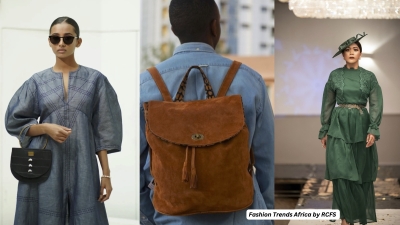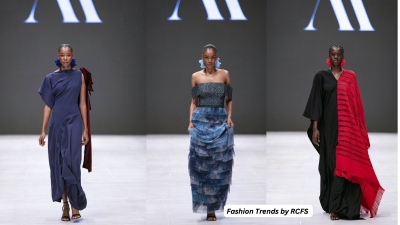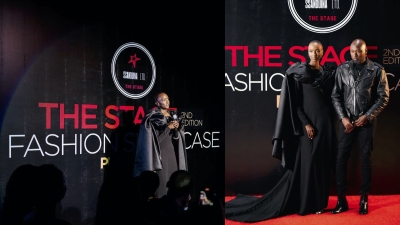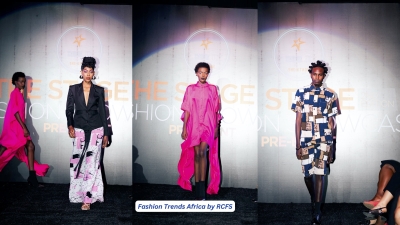
RCFS
Circular Economy and Sustainability in Africa: Fashion and Textiles
The circular economy concept, which aims to minimize waste and maximize resource efficiency, has gained significant attention in the fashion and textile industry, particularly in Africa. The African continent faces unique challenges and opportunities concerning sustainable fashion and textiles.
 Stunning Kimono created from upcycled fabrics by AFC in Kenya [PHOTO NT]
Stunning Kimono created from upcycled fabrics by AFC in Kenya [PHOTO NT]
The fashion and textile industries play a significant role in the circular economy and sustainability efforts in Africa. These industries face various challenges, including resource depletion, environmental pollution, and unethical labor practices. However, there are also opportunities for adopting circular economy principles to address these issues and promote sustainable development.
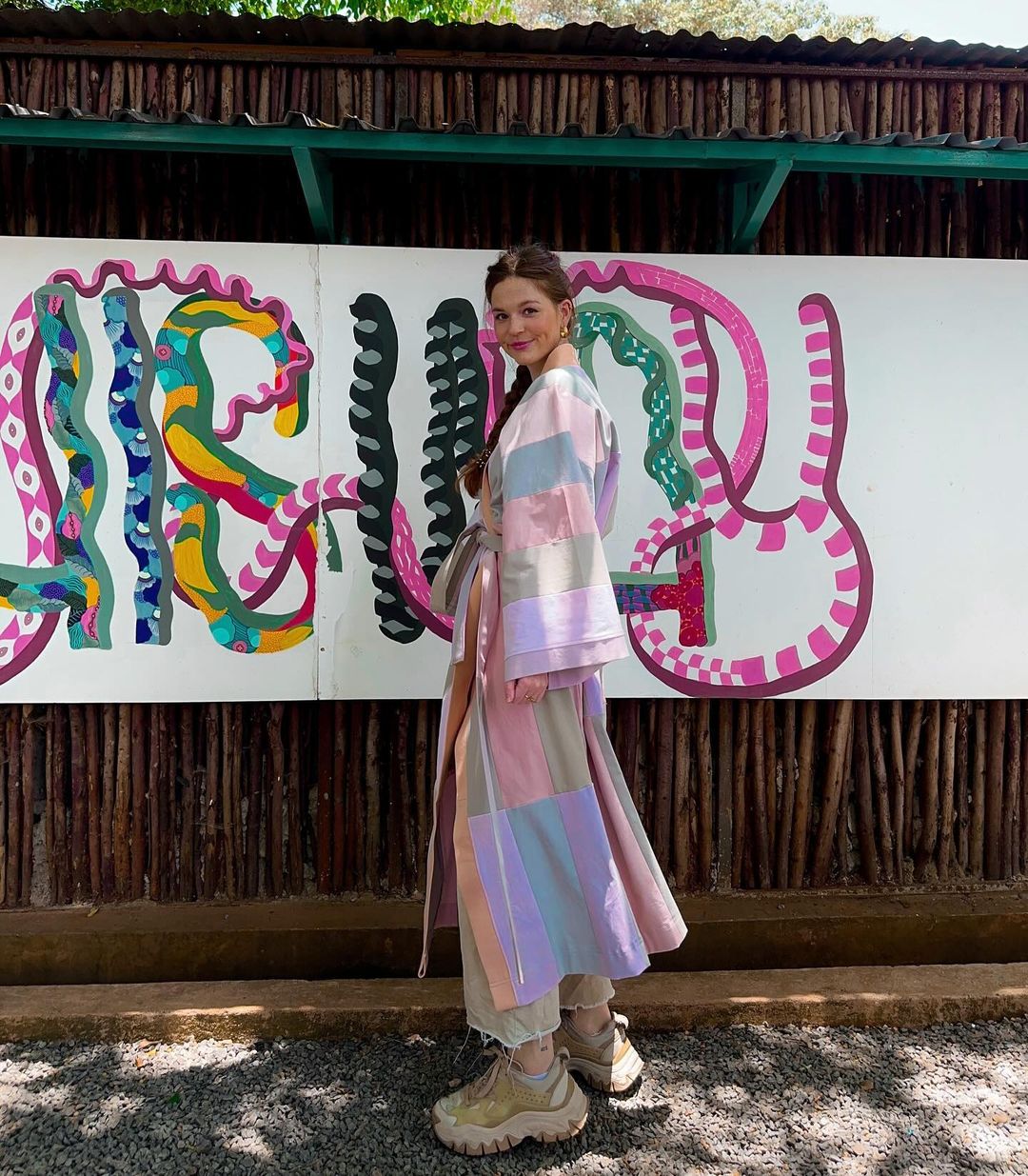 Stunning Kimono created from upcycled fabrics by AFC in Kenya [PHOTO NT]
Stunning Kimono created from upcycled fabrics by AFC in Kenya [PHOTO NT]
Textiles and clothing are a fundamental part of everyday life and an important sector in the global economy. Worldwide, the USD 1.3 trillion clothing industry employs more than 300 million people along the value chain, and the production of cotton alone accounts for almost 7% of all employment in some low-income countries. Out of the many African countries growing and selling cotton, eleven do so under the label Cotton Made in Africa (CmiA), representing 40% of African cotton production.
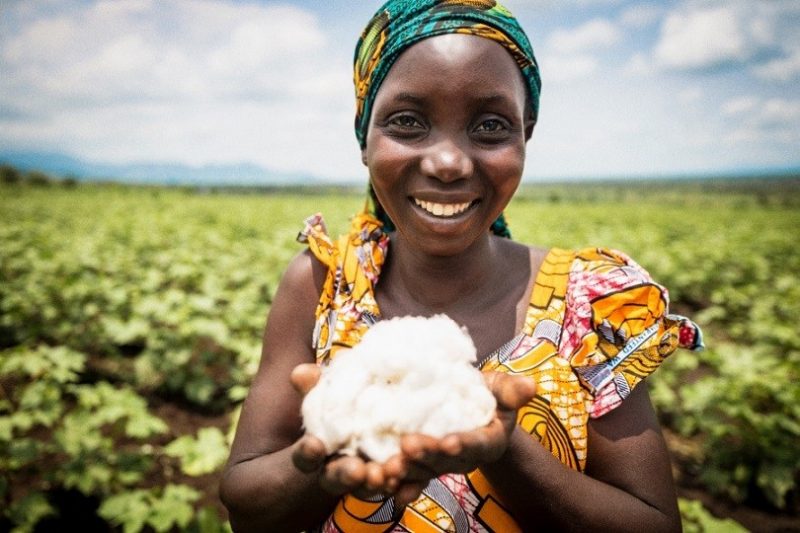 A woman holding cotton on a farm cotton [PHOTO NT]
A woman holding cotton on a farm cotton [PHOTO NT]
In Africa, cotton is almost exclusively grown by smallholder farmers, and there are very few large plantations. The cotton plant loves warmth: it needs about 200 days of sunshine in the season to flourish and bear fruit. For that reason alone, it does well in the dry or humid savannahs of Africa. The climate, with its high average temperatures and alternation between dry and wet seasons, favors the cultivation of this natural fibre crop.
Under the (CmiA) initiative, a total of 900,000 small-scale farmers across eleven African countries produce 715,000 tons of sustainable cotton for the international market and benefit from business and agricultural training. On the manufacturing side, historically, many African countries had vibrant textile industries, with long-standing links to EU-based brands and retailers. Although the biggest textile-producing countries today are China and India, “Made In Africa” is gaining traction, and many brands are moving their production from Asian to African countries, with Ethiopia positioning itself as a leader in the development of the textile industry in East Africa.
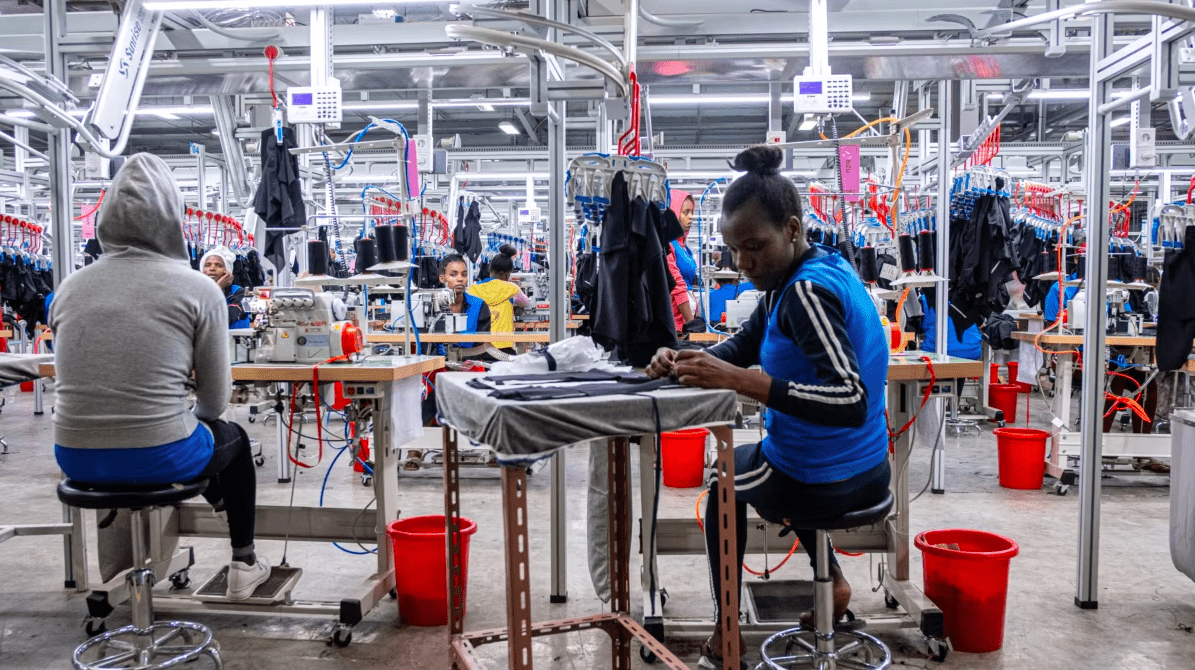 Inside a garment factory in Ethiopia [PHOTO NT]
Inside a garment factory in Ethiopia [PHOTO NT]
Currently, in sub-Saharan Africa, the combined apparel and footwear market is estimated to be worth USD 31 billion and the textile industry in Africa is estimated to grow at a CAGR of ~5% over the forecast period of 2019–2024. The demand for African designs, textiles, and garments is increasing within and beyond the continent. With the growing population and expanding middle classes, the demand for clothing (both local and imported) is expected to rise. African countries, such as Rwanda and South Africa, are planning to revitalize the national textile industry.
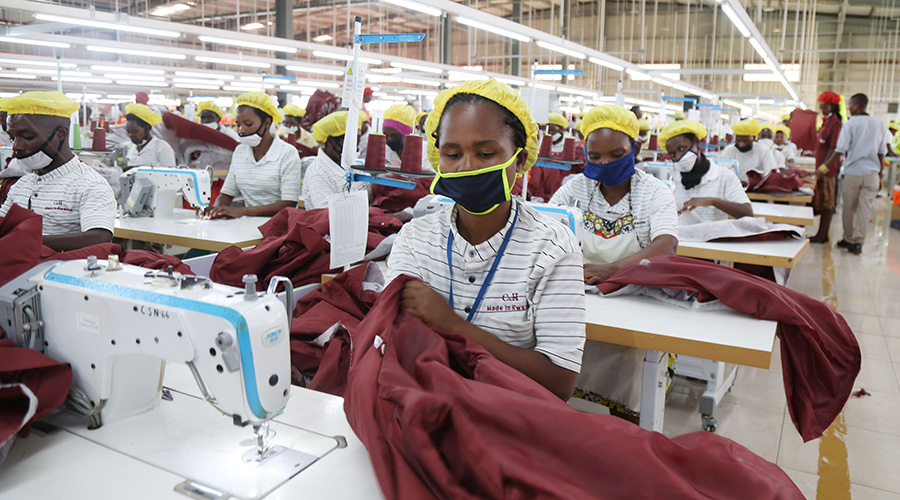 Inside a garment factory in Rwanda [PHOTO NT]
Inside a garment factory in Rwanda [PHOTO NT]
On the global stage, African fashion designers are gaining prominence and for many people, the African fashion industry remains a source of economic inclusion, innovation, and promotion of cultural identity.
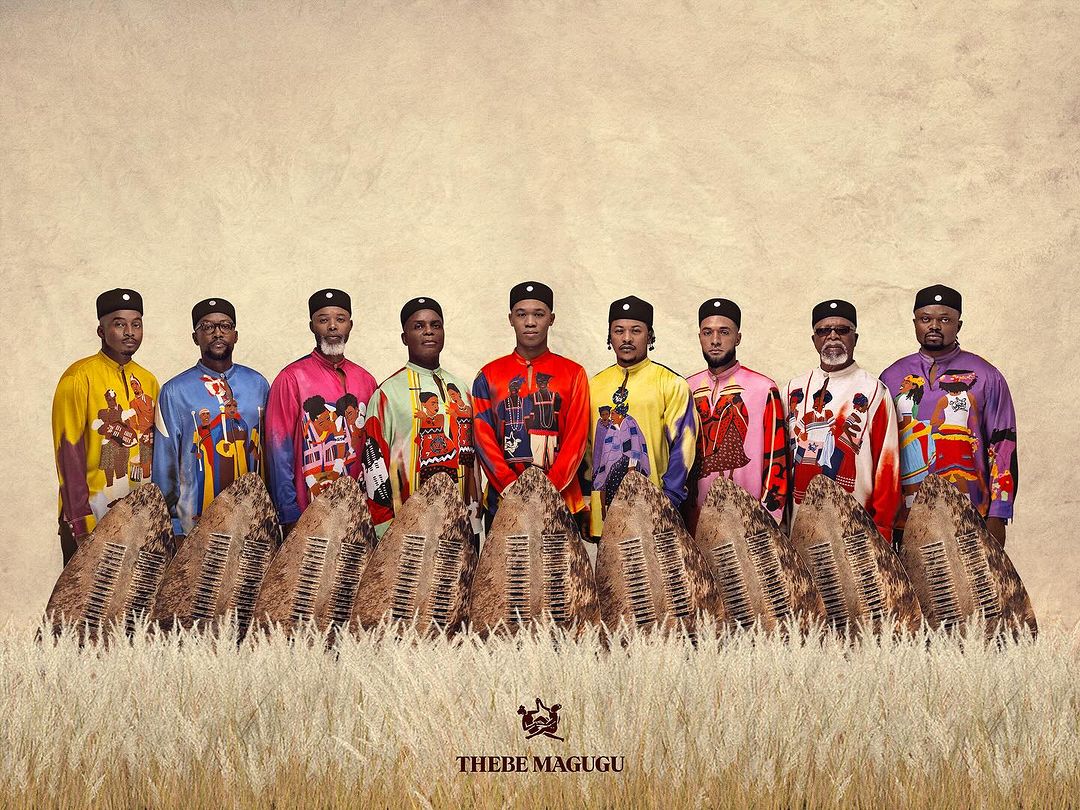 A collection made in South Africa by THEBE MAUGUG [PHOTO THEBE MAUGUGU]
A collection made in South Africa by THEBE MAUGUG [PHOTO THEBE MAUGUGU]
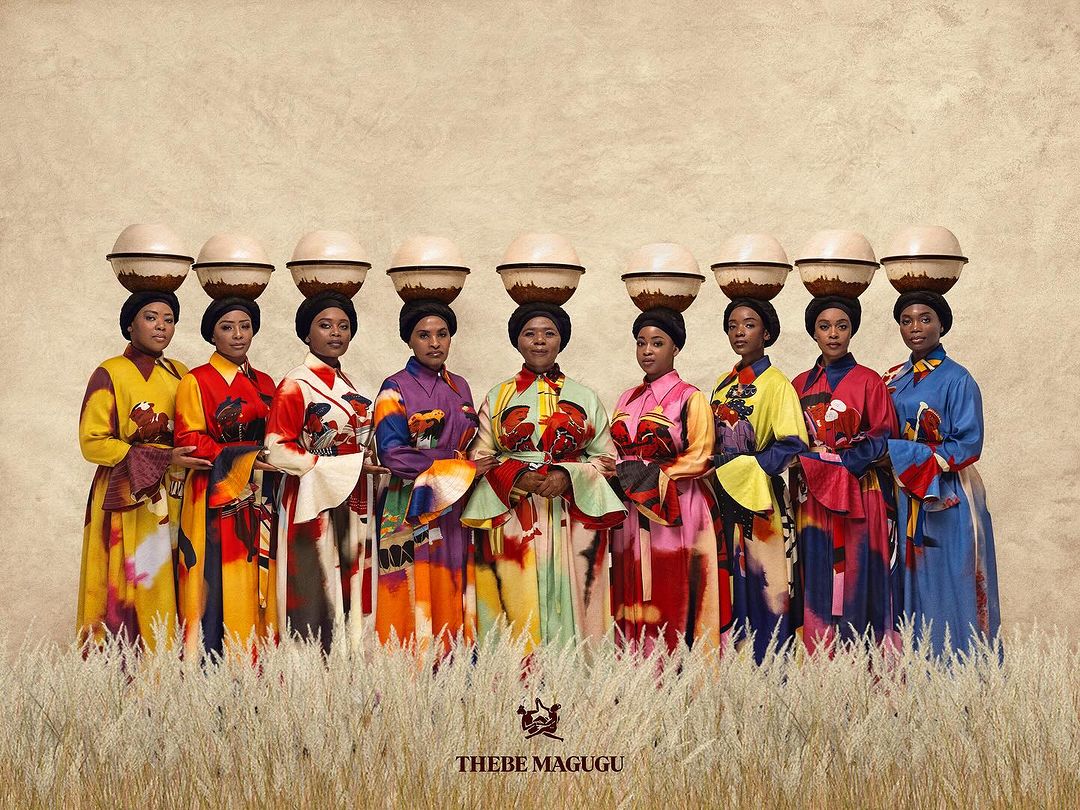 A collection made in South Africa by THEBE MAUGUG [PHOTO THEBE MAUGUGU]
A collection made in South Africa by THEBE MAUGUG [PHOTO THEBE MAUGUGU]
These encouraging trends for the textile sector are not without challenges. Firstly, conventional textile manufacture is associated with labor rights violations; unsafe working conditions; excessive consumption of raw materials, water, and energy; use of Persistent Organic Pollutants (POPs) in industrial operations; as well as water and air pollution. As big brands are increasingly seeing Africa as a new destination for their production facilities, the risks of replicating the same environmental and social negative outcomes seen in some Asian countries are high.
Secondly, downstream, the impact of clothing waste is particularly devastating for African countries, where second-hand clothing is increasingly exported. In the capital of Ghana, the Accra Metropolitan Assembly picks up around 70 metric tons of imported clothing waste from the Kantamanto market every day, six days a week. A lack of capacity to collect and recover textiles leads to clothing being disposed of informally – meaning it is burned and the ashes are swept into the gutters, where it makes its way to the sea; or it is brought to ‘informal’ dumpsites. The total impact of leaching dyes, chemicals, and microfibres on the environment, people’s health, and biodiversity loss is significant.
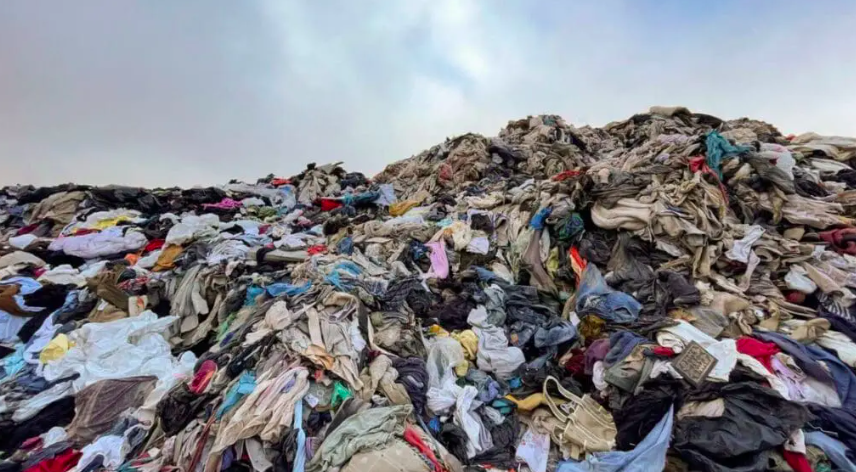 Old clothes dumped in mixed with other trash [PHOTO NT]
Old clothes dumped in mixed with other trash [PHOTO NT]
According to Climate Action, the challenges of textile waste in Africa are numerous, with serious environmental, economic, and social consequences. " People on the red carpet wear outfits that they will never wear again This is to argue that the fashion sector lacks sustainability and environmental care, resulting in increased textile waste in Africa. The catchphrase is always “Who are you wearing” and there will be no recycled outfits on the next red carpet"
Furthermore, according to the Future Investment Initiative Institute, the fashion industry emits more than 1.2 billion tons of greenhouse gas emissions every year as more clothes are produced each year and worn for increasingly shorter periods. That represents one-tenth of total emissions, more than all foreign flights and maritime shipping combined. Fast fashion companies are dumping textile waste in Africa, exacerbating a cycle of environmental degradation and social injustice. Africa is at the center of the expanding textile waste challenge.
The case for a thriving textile industry is clearly emerging in Africa, with potential important gains in terms of job creation and skills development. A circular economy holds the key to a prosperous, inclusive, and resilient fashion industry in Africa while avoiding the drawbacks of the current linear system that have detrimental impacts on people’s well-being and the environment.
The Latest in African Print Patterns
 African print pattern- Made in Africa dress [PHOTO NT]
African print pattern- Made in Africa dress [PHOTO NT]
African print patterns have always been a statement of culture, identity, and personal style. In 2024, we're seeing these prints evolve into even more intricate, bold, and dynamic designs. From the classic Ankara to the mesmerizing Kente, designers are pushing boundaries and blending patterns. African prints have always been very beautiful and colorful, but this year we've already seen that this has been turned up a notch.
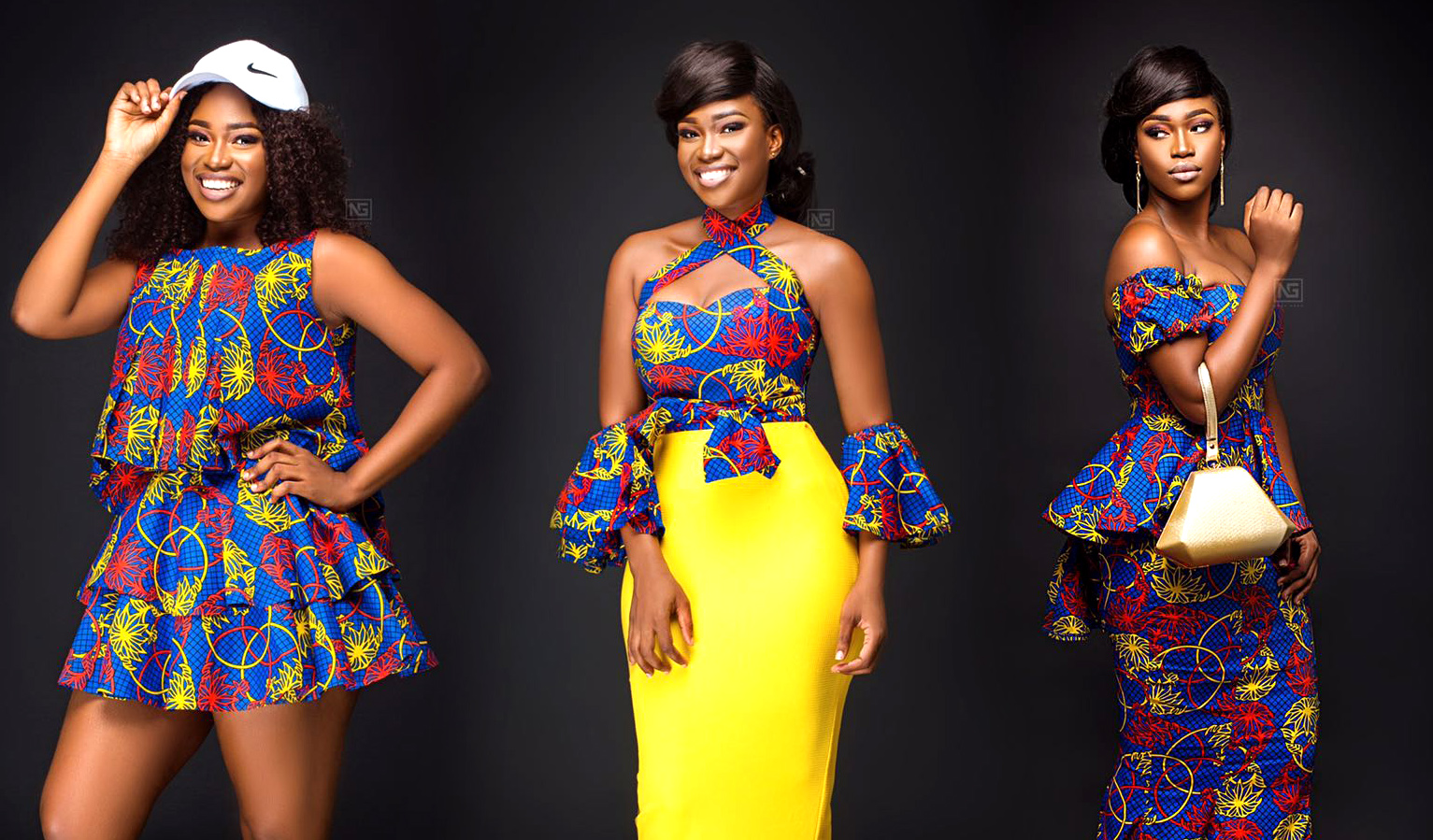 African print patterns [PHOTO NT]
African print patterns [PHOTO NT]
Making the wearer of these colorful fabrics and gorgeous patterns feel royal. This is especially seen with the launch of the new silky Satin Royal fabric by Vlisco. The traditional fabrics we all know and love are still very much alive, but we think we'll be seeing more fabrics with new patterns and color pallets that will suit modern designs.
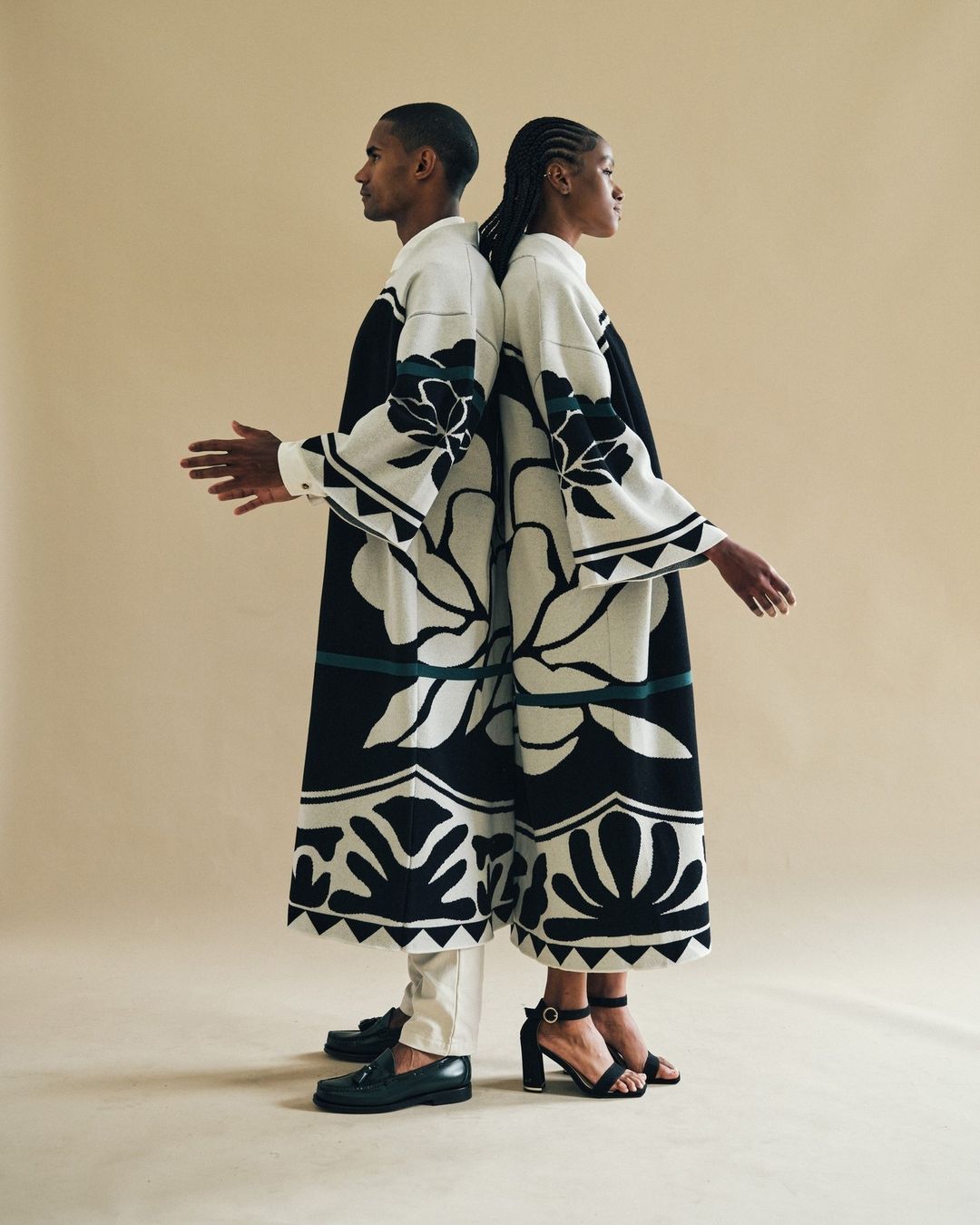
African print pattern- Made in Africa by Mille Colines [PHOTO MC]
Some information in this article is from the research by the Ellen MacArthur Foundation
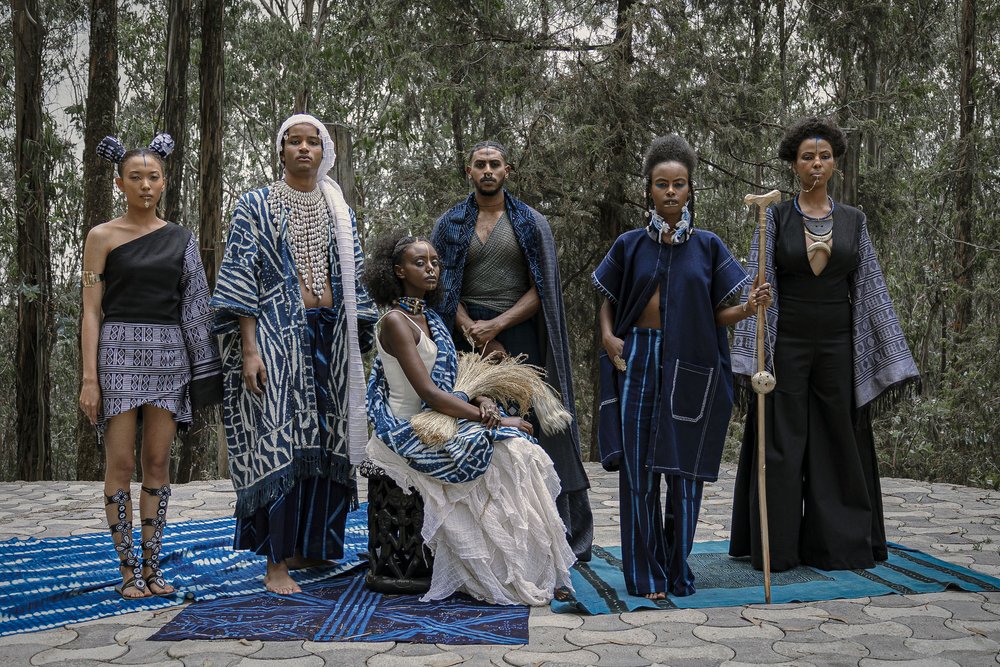
Made in Ethiopia collection by Afropian: A play on words between Ethiopian and African, Afropian is a lifestyle brand based in Addis Ababa that focuses on telling a story of African excellence, by Africans for the world. Though it is strongly centered on Ethiopia, it is a journey across the whole continent and its History.
During an exclusive side chat at Source Fashion in London, the president of Ethiopia's Hawassa Industrial Park Investors Association (HIPIA) Hibret Lemma, confesses Ethiopia is only just at the start of its shift away from relying solely on the US for its garment exports.
He admits losing AGOA was a big hit to the country's garment sector and it slowed down growth considerably. However, Ethiopia's garment suppliers were hopeful that AGOA would be reinstated by the end of 2022 and that hope continued again until the end of 2023.
The nation's apparel sector has now accepted the waiting game is set to continue, with even AGOA's existing members still waiting for the agreement to be extended beyond its 2025 expiry date.
Lemma states: "We're back to reality now so we’ve been looking at the Europe market for about a year but it’s still in the early stages." In fact, Lemma took part in a panel session at last summer's Source Fashion event where he explained why European fashion sourcing executives should consider tapping into Ethiopia's sourcing potential.
Ethiopia's main challenge since losing AGOA
In his one-on-one chat with Just Style, however, Lemma is much more frank about the challenges since losing AGOA. He notes the main problem for the Hawassa Industrial Park is that it was originally designed with the US fashion industry in mind.
It was built seven years ago with US fashion conglomerate PVH Corp as an anchor investor, so the factory lines were made for repetition and big volume orders. Ethiopia's manufacturers were not looking at other markets before the loss of AGOA so it meant cutting staff and employees having to go back to their rural homes.
Hawassa, which is still Ethiopia's biggest industrial garment factory park, had 4,500 employees at its peak. Since the end of the country's AGOA membership in 2022 this has dropped down to 3,000. For Lemma, losing staff due to war and economic issues was a major challenge and on top of that having less help from the government, due to it it having other priorities. He adds access to foreign currency has historically also been a problem, but that is getting better.
The silver lining is that most companies managed to stay at the park, despite some downscaling, but they are now looking for reasons to expand. Indeed, despite the loss of AGOA Lemma retorts proudly that only two companies have closed since 2021.
On the whole, Lemma believes the factories wanted to stay open, which shows the resilience and true long-term potential of Ethiopia's garment sector. Remarkably, some garment manufacturers are still working with the US market despite the extra costs of not having the AGOA advantage. Lemma suggests these companies have successfully mastered efficiencies such as discounts on transportation to make exporting to the US a profitable endeavour.
Arguably, the big lesson Ethiopia has learned after all this is not to rely on one market and one trade agreement, such as AGOA. It is the same lesson fashion retailers and brands learned during the COVID-19 pandemic when supply chain issues were rife. Diversification is key at both ends of the supply chain spectrum.
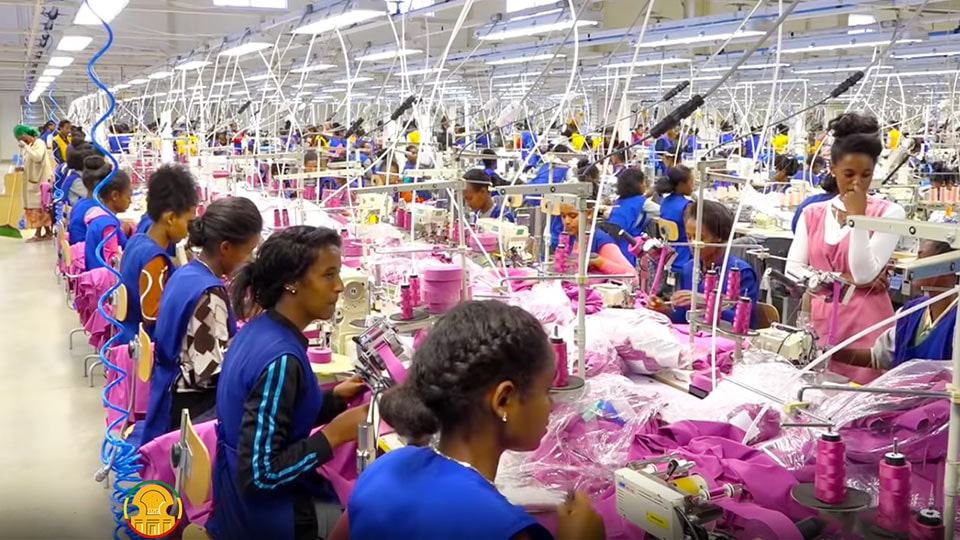
Ethiopian workers inside a clothing factory [PHOTO NT]
Pros and cons of exporting to Europe
There are still plenty of opportunities for Ethiopia's garment sector, however, Lemma accepts: "Adapting to the European market and fast fashion will require adjusting lines and having more agility, which takes time." He continues that styles and volume are different for European fashion brands and retailers so this is a challenge for its supply chain.
The French sporting brand Decathlon is namedropped as already sourcing from Ethiopia along with French department store Monoprix, which Lemma says shows the country does have some experience with the European market, but it's still at an infant stage from a scale point of view.
Just Style spoke to a number of Ethiopian garment suppliers while wandering around the responsible global fashion supplier trade show. Many of them were quick to cite Europe as their new target market. JP Textile Ethiopia's general manager Dick Sun noted that the UK announced duty-free benefits for Ethiopia last year, which is why he was keen to be at the London-based show.
However, Desta Garments PLC's general manager Eyob Bekele points out that Europe and the UK offer Ethiopia the same duty-free benefits as their Asian suppliers, so he views the likes of Bangladesh and Pakistan as real competition.
Bekele acknowledges that Ethiopia doesn’t have as much vertical sourcing, which makes it a challenge as Ethiopia has to buy materials from Asia, while also competing with the sourcing major continent on export price for its ready-made garments.
There is development in Ethiopia's cotton farms and companies are looking into backward integration in terms of developing the fabric, but it has to be sustainable, Bekele adds.
Lemma hopes verticality will be on the horizon for Ethiopia in the not too distant future. He stated: "We would love to see fabric mills and a ginning capacity. We also want our garment hub to be a leader in Africa. I hope in three or four years we will be a leader at least in sub-Saharan Africa".
For Bekele, sustainability is key as he points out that Europe in particular is looking for more sustainable options and higher quality fabrics. Plus, he agrees with Lemma that the US' consumer power is much bigger than Europe so his factory was not set up for the smaller volumes European brands and retailers are now requesting.
Demka Group's managing director Ayhan Demir explains his Turkish company opened an Ethiopia factory eight years ago. AGOA was a "big disappointment" and is the reason why his company has now "turned its face to Europe and the UK".
Demir shares UK retailers Matalan and Primark currently work with Demka Group's factory in Türkiye, but given the impact of the Red Sea crisis, he is hopeful the Ethiopia factory could become an attractive proposition for them moving forward.
Sumbiri Hela Intimate Apparel's general manager Ravi Jaya Thilaka also points out that Ethiopia is already producing highly technical garment products. He says his company has the first bra factory in East Africa which involves using high tech machinery. His factory has 3,000 employees and he is proud to say the workforce is trained and has a willingness to learn with potential for them to improve.
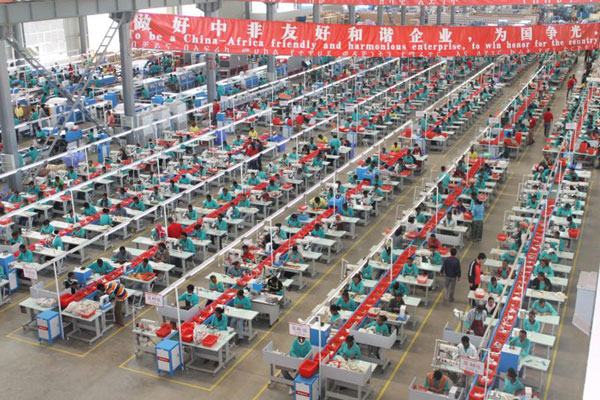
Ethiopian workers inside a clothing factory [PHOTO NT]
Will Africa be Ethiopia's next big opportunity?
Lemma describes Africa's consumer market as a real growth opportunity, but he notes you can't put a timeline on it as the free trade agreement for Ethiopia is not yet in operation. He is referring to the African Continental Free Trade Area Agreement (AfCFTA), which aims to create the largest free trade area in the world measured by the number of countries participating.
Ethiopia is yet to commence its trial but it is said to be making preparations with a view to diversifying its export products. Bekele believes that once the trade agreement is in operation the duty-free benefits will give Ethiopia a big opportunity. He notes volume is also substantial in Africa but affordability has to be a key part of any African consumer push.
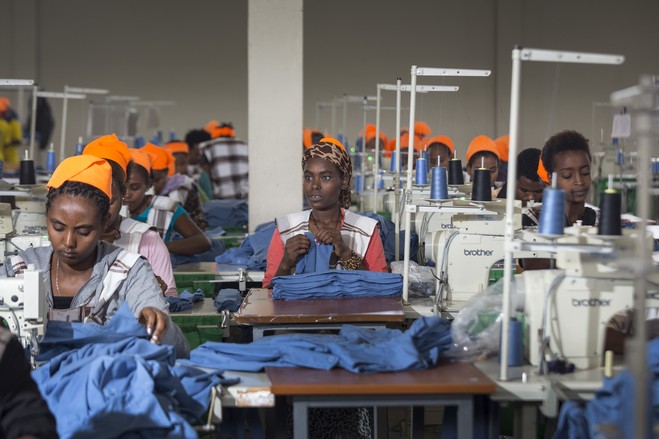
Ethiopian workers inside a clothing factory [PHOTO NT]
For Bekele, another arguably missed opportunity to date that would prevent both the amount of excess garment waste that enters the region as well as the chance to boost Ethiopia's sourcing potential locally is for global fashion brands and retailers to open stores in the continent.
Bekele believes there is demand for it as many Africans currently buy branded products when they travel to Europe so he asks: "Why are chains not opening in Africa?"
Hirdaramani Apparel's group marketing consultant Tharumal Wijesinghe agrees that Africa's potential is "huge".
He maintains it is beneficial for his multinational company to stay in Ethiopia as it gives European fashion brands and retailers the chance to expand their sourcing in the region for the time being. However, like so many of the other Ethiopian garment manufacturers exhibiting at Source Fashion, Wijesinghe has still got his fingers (and toes) crossed for AGOA and its huge US consumer market returning in the near future.
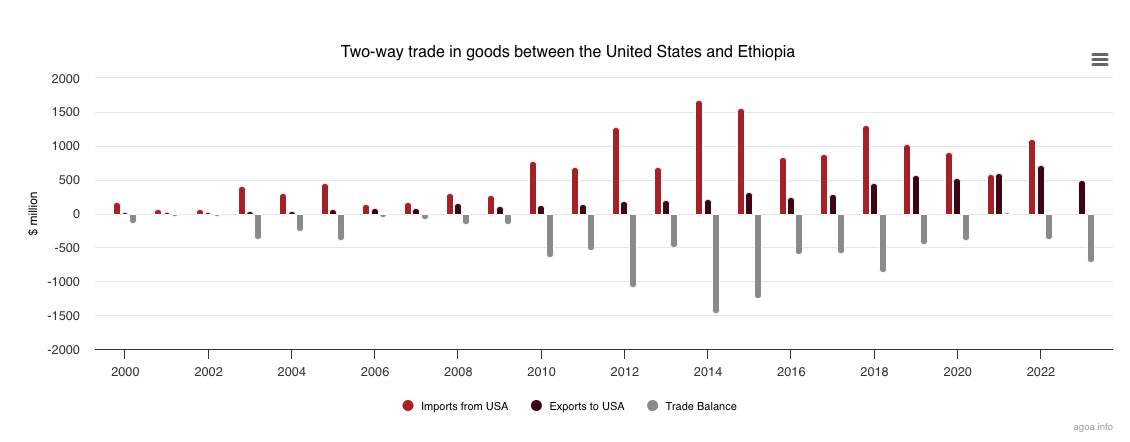
Article souce : GlobalData
How Ethiopia's Apparel Sector is Combatting AGOA Uncertainty: Fashion's Next Sourcing Hub

Made in Ethiopia collection by Afropian: A play on words between Ethiopian and African, Afropian is a lifestyle brand based in Addis Ababa that focuses on telling a story of African excellence, by Africans for the world. Though it is strongly centered on Ethiopia, it is a journey across the whole continent and its History.
During an exclusive side chat at Source Fashion in London, the president of Ethiopia's Hawassa Industrial Park Investors Association (HIPIA) Hibret Lemma, confesses Ethiopia is only just at the start of its shift away from relying solely on the US for its garment exports.
He admits losing AGOA was a big hit to the country's garment sector and it slowed down growth considerably. However, Ethiopia's garment suppliers were hopeful that AGOA would be reinstated by the end of 2022 and that hope continued again until the end of 2023.
The nation's apparel sector has now accepted the waiting game is set to continue, with even AGOA's existing members still waiting for the agreement to be extended beyond its 2025 expiry date.
Lemma states: "We're back to reality now so we’ve been looking at the Europe market for about a year but it’s still in the early stages." In fact, Lemma took part in a panel session at last summer's Source Fashion event where he explained why European fashion sourcing executives should consider tapping into Ethiopia's sourcing potential.
Ethiopia's main challenge since losing AGOA
In his one-on-one chat with Just Style, however, Lemma is much more frank about the challenges since losing AGOA. He notes the main problem for the Hawassa Industrial Park is that it was originally designed with the US fashion industry in mind.
It was built seven years ago with US fashion conglomerate PVH Corp as an anchor investor, so the factory lines were made for repetition and big volume orders. Ethiopia's manufacturers were not looking at other markets before the loss of AGOA so it meant cutting staff and employees having to go back to their rural homes.
Hawassa, which is still Ethiopia's biggest industrial garment factory park, had 4,500 employees at its peak. Since the end of the country's AGOA membership in 2022 this has dropped down to 3,000. For Lemma, losing staff due to war and economic issues was a major challenge and on top of that having less help from the government, due to it it having other priorities. He adds access to foreign currency has historically also been a problem, but that is getting better.
The silver lining is that most companies managed to stay at the park, despite some downscaling, but they are now looking for reasons to expand. Indeed, despite the loss of AGOA Lemma retorts proudly that only two companies have closed since 2021.
On the whole, Lemma believes the factories wanted to stay open, which shows the resilience and true long-term potential of Ethiopia's garment sector. Remarkably, some garment manufacturers are still working with the US market despite the extra costs of not having the AGOA advantage. Lemma suggests these companies have successfully mastered efficiencies such as discounts on transportation to make exporting to the US a profitable endeavour.
Arguably, the big lesson Ethiopia has learned after all this is not to rely on one market and one trade agreement, such as AGOA. It is the same lesson fashion retailers and brands learned during the COVID-19 pandemic when supply chain issues were rife. Diversification is key at both ends of the supply chain spectrum.

Ethiopian workers inside a clothing factory [PHOTO NT]
Pros and cons of exporting to Europe
There are still plenty of opportunities for Ethiopia's garment sector, however, Lemma accepts: "Adapting to the European market and fast fashion will require adjusting lines and having more agility, which takes time." He continues that styles and volume are different for European fashion brands and retailers so this is a challenge for its supply chain.
The French sporting brand Decathlon is namedropped as already sourcing from Ethiopia along with French department store Monoprix, which Lemma says shows the country does have some experience with the European market, but it's still at an infant stage from a scale point of view.
Just Style spoke to a number of Ethiopian garment suppliers while wandering around the responsible global fashion supplier trade show. Many of them were quick to cite Europe as their new target market. JP Textile Ethiopia's general manager Dick Sun noted that the UK announced duty-free benefits for Ethiopia last year, which is why he was keen to be at the London-based show.
However, Desta Garments PLC's general manager Eyob Bekele points out that Europe and the UK offer Ethiopia the same duty-free benefits as their Asian suppliers, so he views the likes of Bangladesh and Pakistan as real competition.
Bekele acknowledges that Ethiopia doesn’t have as much vertical sourcing, which makes it a challenge as Ethiopia has to buy materials from Asia, while also competing with the sourcing major continent on export price for its ready-made garments.
There is development in Ethiopia's cotton farms and companies are looking into backward integration in terms of developing the fabric, but it has to be sustainable, Bekele adds.
Lemma hopes verticality will be on the horizon for Ethiopia in the not too distant future. He stated: "We would love to see fabric mills and a ginning capacity. We also want our garment hub to be a leader in Africa. I hope in three or four years we will be a leader at least in sub-Saharan Africa".
For Bekele, sustainability is key as he points out that Europe in particular is looking for more sustainable options and higher quality fabrics. Plus, he agrees with Lemma that the US' consumer power is much bigger than Europe so his factory was not set up for the smaller volumes European brands and retailers are now requesting.
Demka Group's managing director Ayhan Demir explains his Turkish company opened an Ethiopia factory eight years ago. AGOA was a "big disappointment" and is the reason why his company has now "turned its face to Europe and the UK".
Demir shares UK retailers Matalan and Primark currently work with Demka Group's factory in Türkiye, but given the impact of the Red Sea crisis, he is hopeful the Ethiopia factory could become an attractive proposition for them moving forward.
Sumbiri Hela Intimate Apparel's general manager Ravi Jaya Thilaka also points out that Ethiopia is already producing highly technical garment products. He says his company has the first bra factory in East Africa which involves using high tech machinery. His factory has 3,000 employees and he is proud to say the workforce is trained and has a willingness to learn with potential for them to improve.

Ethiopian workers inside a clothing factory [PHOTO NT]
Will Africa be Ethiopia's next big opportunity?
Lemma describes Africa's consumer market as a real growth opportunity, but he notes you can't put a timeline on it as the free trade agreement for Ethiopia is not yet in operation. He is referring to the African Continental Free Trade Area Agreement (AfCFTA), which aims to create the largest free trade area in the world measured by the number of countries participating.
Ethiopia is yet to commence its trial but it is said to be making preparations with a view to diversifying its export products. Bekele believes that once the trade agreement is in operation the duty-free benefits will give Ethiopia a big opportunity. He notes volume is also substantial in Africa but affordability has to be a key part of any African consumer push.

Ethiopian workers inside a clothing factory [PHOTO NT]
For Bekele, another arguably missed opportunity to date that would prevent both the amount of excess garment waste that enters the region as well as the chance to boost Ethiopia's sourcing potential locally is for global fashion brands and retailers to open stores in the continent.
Bekele believes there is demand for it as many Africans currently buy branded products when they travel to Europe so he asks: "Why are chains not opening in Africa?"
Hirdaramani Apparel's group marketing consultant Tharumal Wijesinghe agrees that Africa's potential is "huge".
He maintains it is beneficial for his multinational company to stay in Ethiopia as it gives European fashion brands and retailers the chance to expand their sourcing in the region for the time being. However, like so many of the other Ethiopian garment manufacturers exhibiting at Source Fashion, Wijesinghe has still got his fingers (and toes) crossed for AGOA and its huge US consumer market returning in the near future.

Article souce : GlobalData
Is Recycled Cotton Sustainable: What it is and All the Advantages of This Fabric?
“No new land is required in recycling cotton. We all know that cotton is a crop that requires vast amounts of land, often leading to habitat destruction and biodiversity loss. Recycled cotton reuses existing materials” Fashion and Textiles expert says

Cotton farming [PHOTO NT]
With increasing concern about the environmental impact of the fashion industry, more brands and consumers are looking for sustainable fabric alternatives. Recycled cotton has emerged as one promising eco-friendly option. But what exactly is recycled cotton and how does it stack up in terms of sustainability?
Over the years, an increasing focus on the theme of sustainability and environmental impact has revived ancient techniques of fabric recycling that were fading away. This is how recycled cotton is born.

Old and second hand clothes to be recycled [PHOTO NT]
ALSO READ: HOW FAR IS THE AFRICAN FASHION INDUSTRY? POTENTIAL, SUSTAINABILITY, AND CHALLENGES
Why does Cotton matter in the fashion industry?
Cotton is a natural and biodegradable fiber, and its traditional cultivation and harvesting practices require the extensive use of many resources and harmful inputs, such as the intensive use of hazardous pesticides. It is made from the natural fibers that grow in the bolls of the cotton plant.
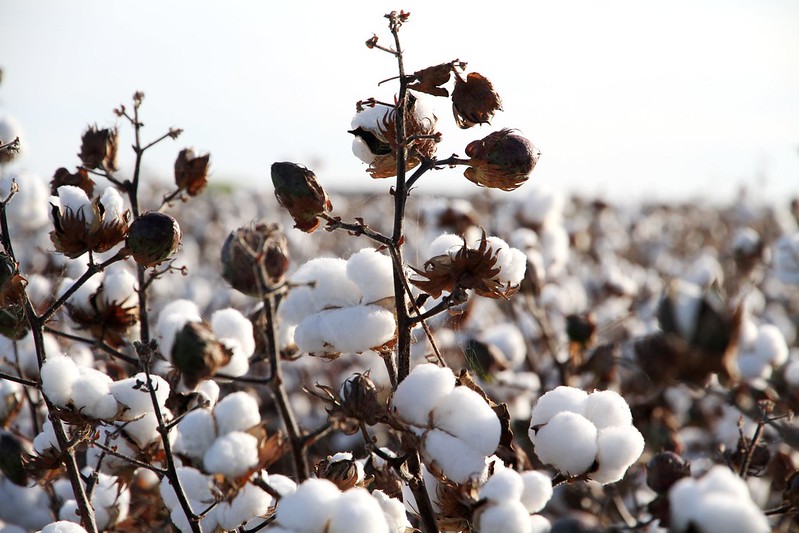
Cotton ready to be harvested [PHOTO NT]
The fibers are basically cellulose polymers. The unique twisted, convolutions structure of cotton fibers gives cotton its special qualities like strength, absorbency, and breathability. Also, cotton is highly absorbent due to the presence of many hydroxyl groups in its cellulose molecules. This allows cotton to absorb and release moisture quickly. Cotton is an integral part of our everyday lives: it is the second most used fiber by the textile industry and is used across multiple categories of clothing, home textiles, and accessories. You might even be wearing something made of cotton right now. But have you ever stopped to consider whether this cotton is recycled? And if it were, would you be able to tell?

T-shirt made out of recycled cotton [PHOTO NT]
As the world becomes more and more aware of the textile waste crisis, and legislation coming into place to try to slow it down, it is important to understand the concepts within recycled cotton and the nuances you can come across.

People harvesting cotton [PHOTO NT]
According to fashion and textiles experts, there are many advantages of recycled cotton starting with the water usage in the process where it reduces water and energy use growing conventional cotton which is extremely water-intensive, with one kg of cotton requiring up to 20,000 liters of water. “Recycled cotton skips this agricultural stage, eliminating the tremendous water footprint. It also requires much less energy since there is no need for crop production and raw material processing” an Expert says

Cotton pieces to be recycled [PHOTO NT]
“When we recycle cotton fabrics and old clothes, it reduces waste and pollution an estimated 15% of fabric intended for clothing ends up as waste on the cutting room floor. Recycling captures this waste along with post-consumer cotton products and diverts it from landfills, incinerators, and the environmental pollution associated with them” Experts say
ALSO READ: AS EGYPT’S ECONOMY DIPS, SUSTAINABLE FASHION SOARS
Market Overview
The recycled cotton market comprises three main types: purified cotton, cotton blend, and others. Purified cotton refers to recycled cotton that has been extensively processed and refined to remove impurities, resulting in a high-quality and pure end product. Cotton blend involves the combination of recycled cotton with other fibers like polyester or viscose, leading to enhanced durability and functionality. The “others” category encompasses various recycled cotton products not falling under purified or blend types, such as mixed fiber textiles or innovative uses of recycled cotton in non-textile applications.
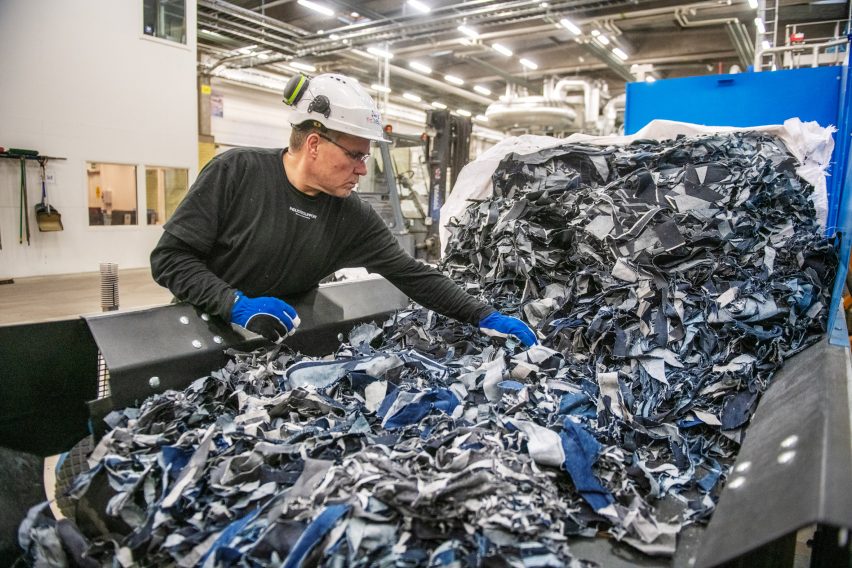
Sorting out different fabrics made of cotton to be recycled [PHOTO NT]
Recycled cotton had an estimated production volume of 300,000 tons in 2022, accounting for approximately 1% of total cotton production worldwide. This contrasts deeply with the approximately 25 million tons of virgin cotton produced annually. However, the demand for recycled cotton is anticipated to increase in the coming years.

Sorting out different fabrics made of cotton to be recycled [PHOTO NT]
The Scaling for Circularity Report highlights that Bangladesh, one of the major textile manufacturing hubs globally, generates around 330,000 tons of post-industrial cotton waste annually. Currently, only 5-7% of this waste is recycled into new fiber, leaving a huge opportunity untapped to close the loop and increase the recycling of this category of products, instead of downcycling it, incinerating it, or sending it to landfill.

Recyled cotton [PHOTO NT]
As the demand for recycled cotton is predicted to grow, it is important for consumers and professionals of the fashion and textiles industry to understand the differences in cotton recycling methods.
The major cotton producers are China (with about 5 million tons/year), the United States (with 4 million tons/year), India (2.5 million tons/year), followed by Egypt, Pakistan, Uzbekistan, Turkey, Australia, Argentina, Brazil, Greece, Sub-Saharan Africa, and South America, each with smaller shares.
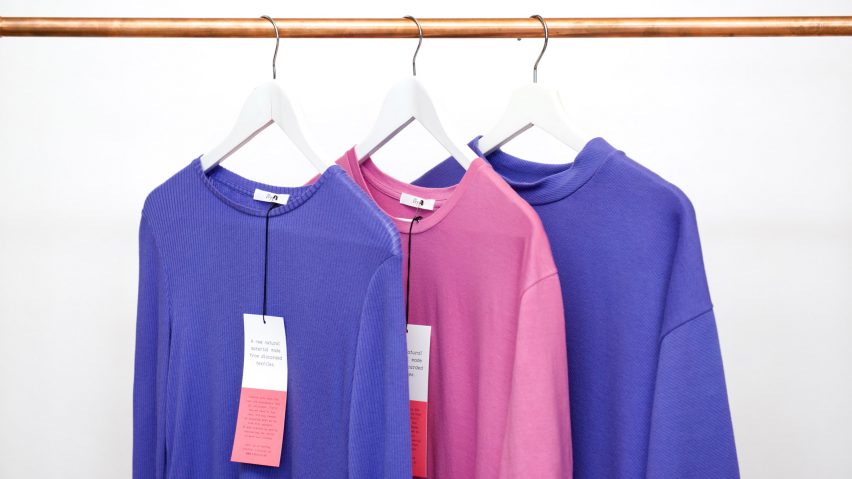
Clothes made out of recycled cotton [PHOTO NT]
Given such a low starting fiber value, it is evident that recycling represents an additional cost and not an economic advantage. Recycling costs more than intensively cultivating cotton, which benefits from economies of scale, and this should not be surprising. In the costs of textile recycling, one must always consider manual selection of scraps, color sorting, and the resulting industrial process.

Clothes made out of recycled cotton [PHOTO NT]
The choice to purchase recycled cotton garments cannot be dictated by price advantage but by the desire to change one's approach and try to reduce one's impact on the environment. As always, the most sustainable choice for the planet is not necessarily the most economical for those of us who inhabit it.
" We want to meet you in person while we discuss and shape together the future of our fashion industry most especially in the Modeling Sector. We’ve been waiting for this time to meet you and hear about what you are doing, and aiming to do and how better we can collaborate on the series of projects we have for models while we emphasize our recently announced Models Casting and the main Edition 2 of the biggest current Fashion Show in Rwanda" announcement by the Stage Fashion Showcase calling modeling agencies.
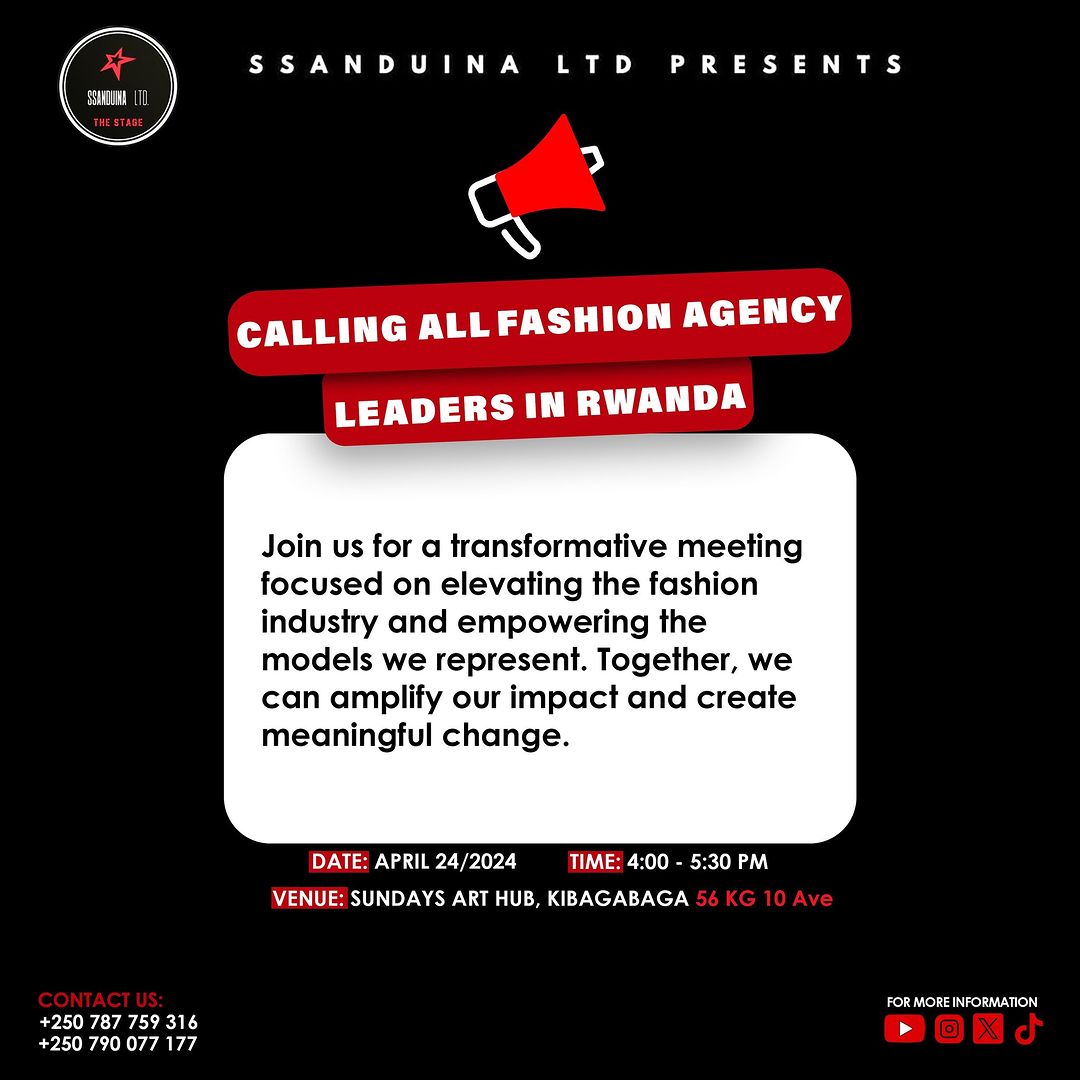
Announcement by SSANDUINA LTD the organizer of the Stage Fashion Showcase [PHOTO SSANDUINA]
Sandrine Mucyo is a former model turned entrepreneur on a mission to bring cohesion to Rwanda's modeling industry through her STAGE FASHION SHOWCASE. However, her efforts have faced resistance from some agency leaders unwilling to collaborate. The STAGE FASHION SHOWCASE, now in its second year, aims to provide a platform for models from different agencies to come together and showcase their talents. Mucyo, the founder, believes this kind of unified event benefits the entire industry.
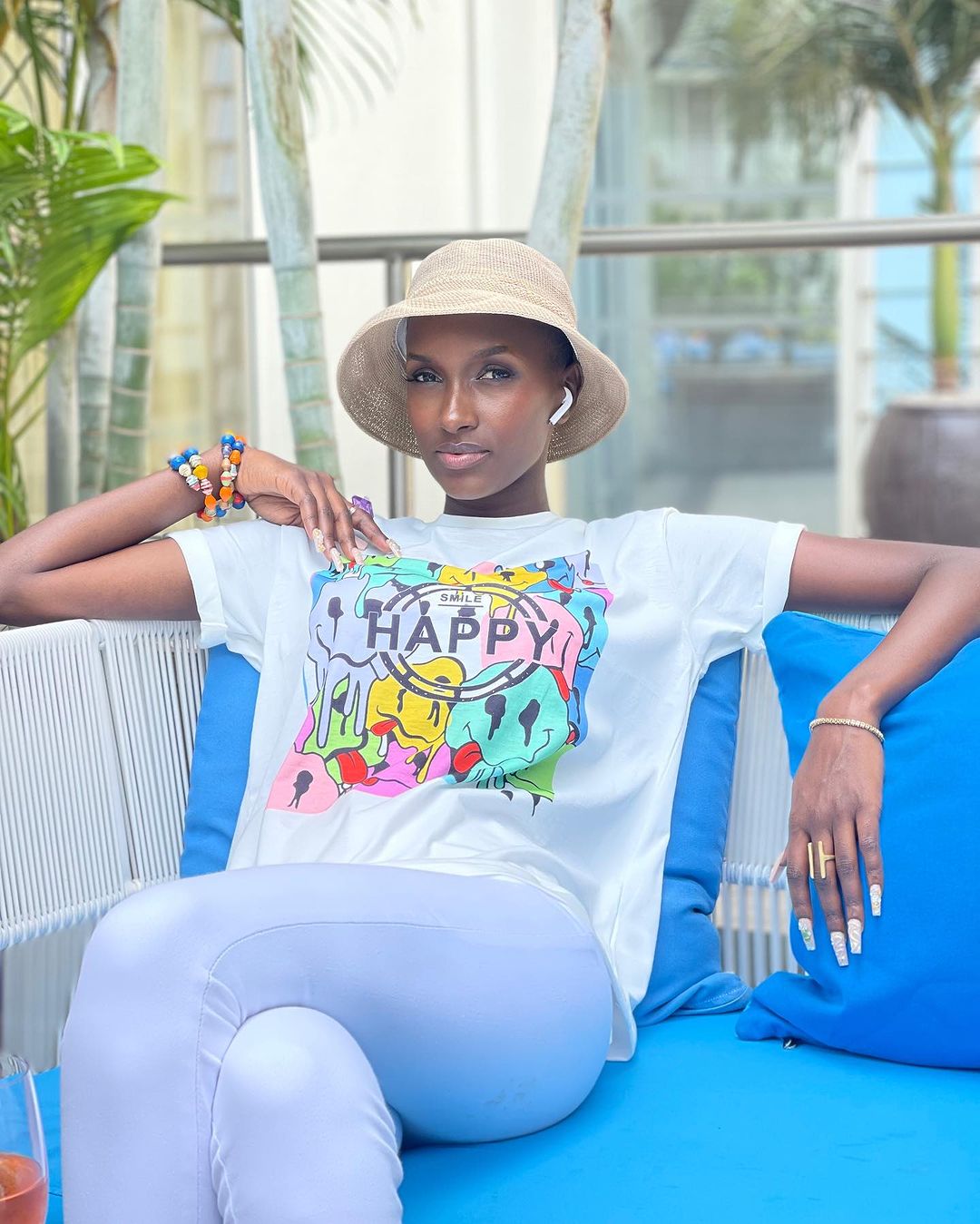
Ms. Sandrine Mucyo CEO and Managing Director of SSANDUINA LTD the organizer of the Stage Fashion Showcase [PHOTO SSANDUINA]
"When we work separately, it limits the opportunities for our models," Mucyo said. "By joining forces for events like the STAGE FASHION SHOWCASE, we can elevate Rwandan modeling and attract more brands and sponsors."
ALSO READ: The Stage Fashion Showcase: A Prestigious Fashion Show is Set to Premiere on October 14, 2023
However, getting agency leaders on board has proven difficult. Some have accused others of being selfish or mismanaging their organizations. There are also long-standing rivalries and trust issues preventing cooperation.
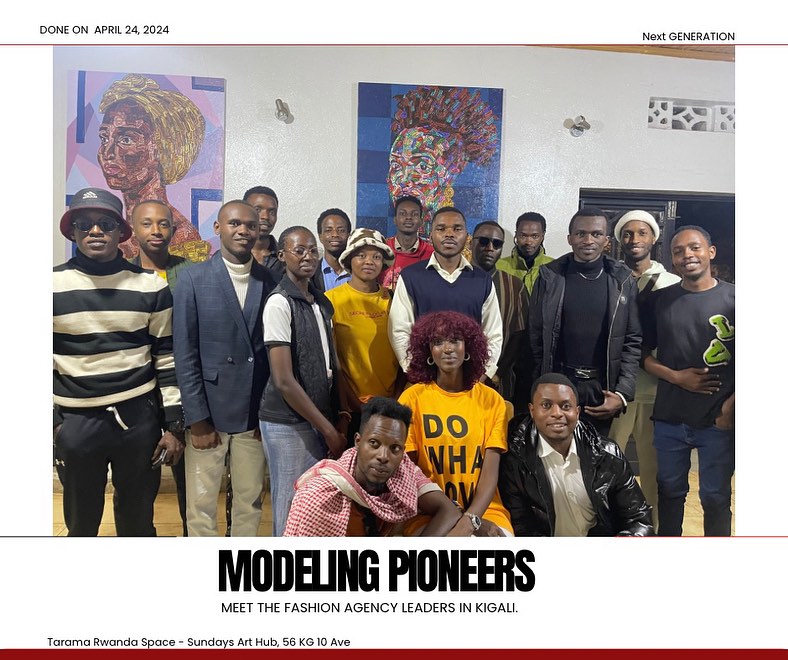
[Second from the right on the first row in a yellow T-shirt] Ms. Sandrine Mucyo with other modeling agency leaders after the meeting in Kigali - PHOTO SSANDUINA
"We've tried collaborating before, but it always falls apart because people put their own interests first," said Jacques Havugimana head of KMM "Until we can get past that, these efforts won't succeed."
Despite the roadblocks, Mucyo remains determined. The most recent STAGE FASHION SHOWCASE in October 2023 featured models from different modeling agencies sharing the runway.
 40 out of over 250 models were selected to participate in the inauguration of the highly anticipated the STAGE FASHION SHOWCASE 2023 at the Marriott Hotel [PHOTO NT]
40 out of over 250 models were selected to participate in the inauguration of the highly anticipated the STAGE FASHION SHOWCASE 2023 at the Marriott Hotel [PHOTO NT]
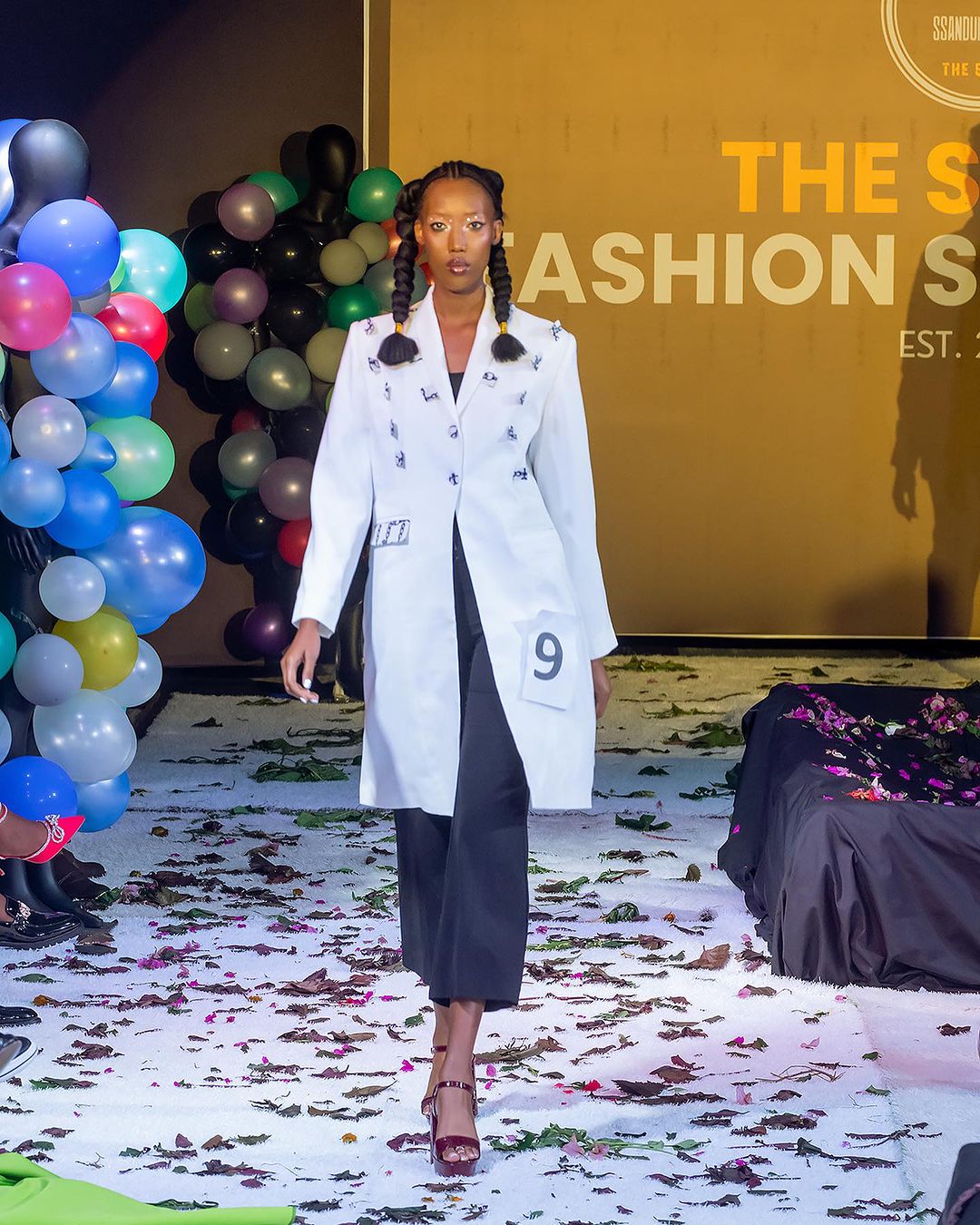
Model on the runway at the Stage Fashion Showcase 2023 [PHOTO SSANDUINA]
"It's a start, but I won't give up on my vision of a unified modeling community here," Mucyo stated. "The benefits for everyone involved are clear. We just have to overcome the egos and politics getting in the way."
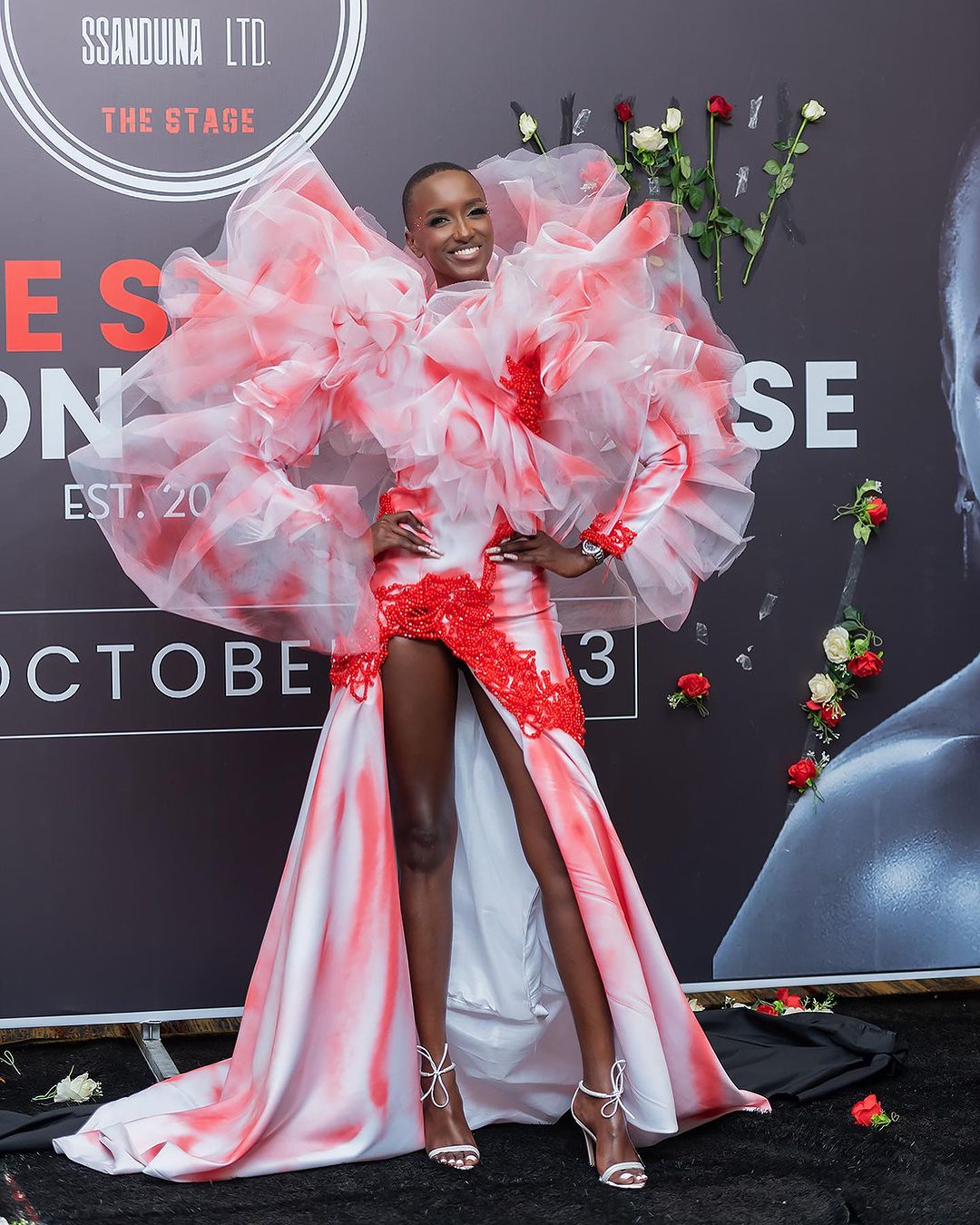
Ms. Sandrine Mucyo CEO and Managing Director of SSANDUINA LTD the organizer of the Stage Fashion Showcase [PHOTO SSANDUINA]
As she continues rallying the agencies, Mucyo hopes to make the STAGE FASHION SHOWCASE an unmissable annual event that brings positive attention to Rwanda's modeling talent. The Stage Fashion Showcase is a hub for models that is not only geared towards booking talent on a national level but also towards planning a fashion show, under the auspices of SSANDUINA Ltd, with the goal of discovering, promoting, and growing Africa's models and fashion designers on a worldwide level.
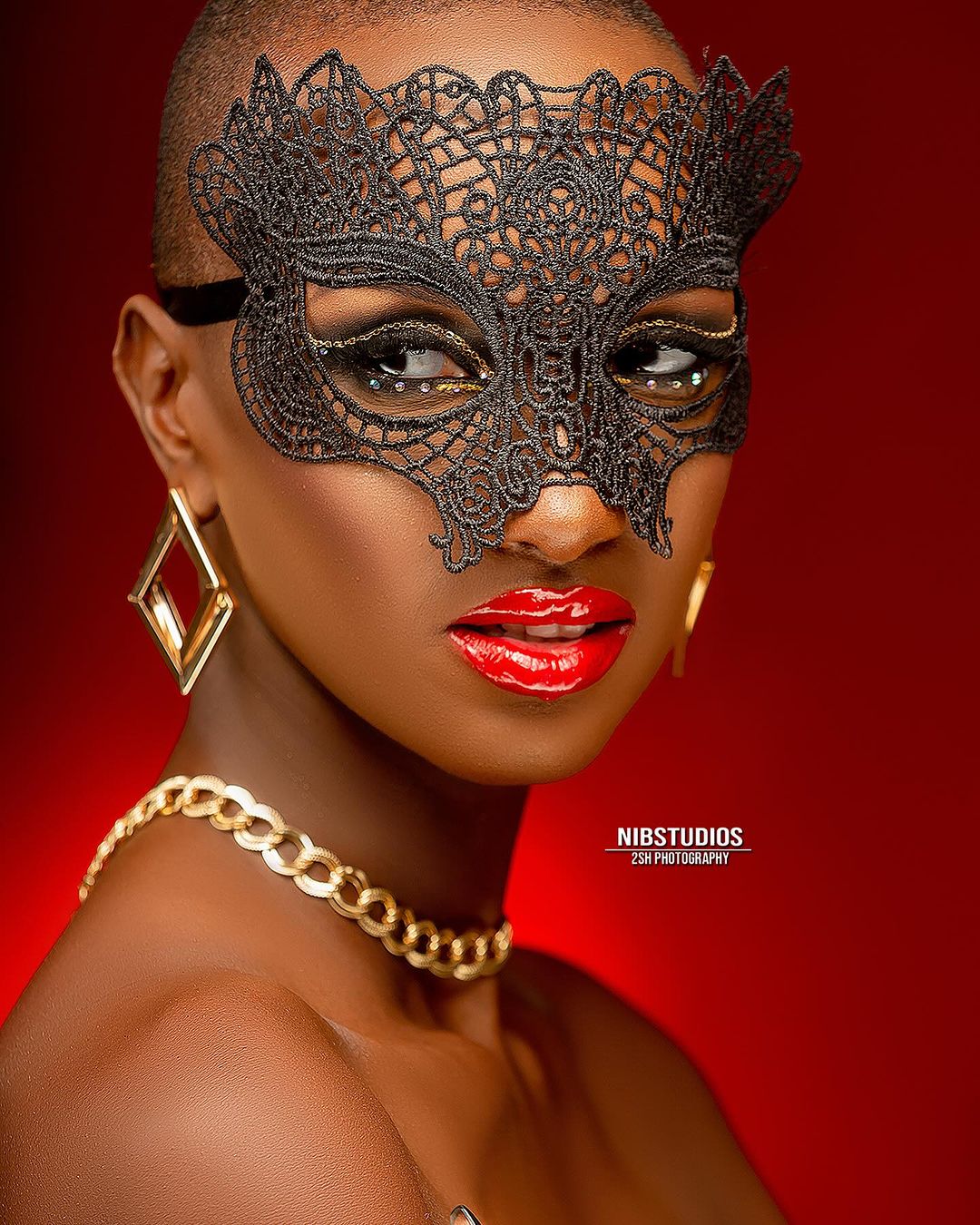
Ms. Sandrine Mucyo CEO and Managing Director of SSANDUINA LTD the organizer of the Stage Fashion Showcase [PHOTO SSANDUINA]
" We want to meet you in person while we discuss and shape together the future of our fashion industry most especially in the Modeling Sector. We’ve been waiting for this time to meet you and hear about what you are doing, and aiming to do and how better we can collaborate on the series of projects we have for models while we emphasize our recently announced Models Casting and the main Edition 2 of the biggest current Fashion Show in Rwanda" announcement by the Stage Fashion Showcase calling modeling agencies.

Announcement by SSANDUINA LTD the organizer of the Stage Fashion Showcase [PHOTO SSANDUINA]
Sandrine Mucyo is a former model turned entrepreneur on a mission to bring cohesion to Rwanda's modeling industry through her STAGE FASHION SHOWCASE. However, her efforts have faced resistance from some agency leaders unwilling to collaborate. The STAGE FASHION SHOWCASE, now in its second year, aims to provide a platform for models from different agencies to come together and showcase their talents. Mucyo, the founder, believes this kind of unified event benefits the entire industry.

Ms. Sandrine Mucyo CEO and Managing Director of SSANDUINA LTD the organizer of the Stage Fashion Showcase [PHOTO SSANDUINA]
"When we work separately, it limits the opportunities for our models," Mucyo said. "By joining forces for events like the STAGE FASHION SHOWCASE, we can elevate Rwandan modeling and attract more brands and sponsors."
ALSO READ: The Stage Fashion Showcase: A Prestigious Fashion Show is Set to Premiere on October 14, 2023
However, getting agency leaders on board has proven difficult. Some have accused others of being selfish or mismanaging their organizations. There are also long-standing rivalries and trust issues preventing cooperation.

[Second from the right on the first row in a yellow T-shirt] Ms. Sandrine Mucyo with other modeling agency leaders after the meeting in Kigali - PHOTO SSANDUINA
"We've tried collaborating before, but it always falls apart because people put their own interests first," said Jacques Havugimana head of KMM "Until we can get past that, these efforts won't succeed."
Despite the roadblocks, Mucyo remains determined. The most recent STAGE FASHION SHOWCASE in October 2023 featured models from different modeling agencies sharing the runway.
 40 out of over 250 models were selected to participate in the inauguration of the highly anticipated STAGE FASHION SHOWCASE 2023 at the Marriott Hotel [PHOTO NT]
40 out of over 250 models were selected to participate in the inauguration of the highly anticipated STAGE FASHION SHOWCASE 2023 at the Marriott Hotel [PHOTO NT]

Model on the runway at the Stage Fashion Showcase 2023 [PHOTO SSANDUINA]
"It's a start, but I won't give up on my vision of a unified modeling community here," Mucyo stated. "The benefits for everyone involved are clear. We just have to overcome the egos and politics getting in the way."

Ms. Sandrine Mucyo CEO and Managing Director of SSANDUINA LTD the organizer of the Stage Fashion Showcase [PHOTO SSANDUINA]
As she continues rallying the agencies, Mucyo hopes to make the STAGE FASHION SHOWCASE an unmissable annual event that brings positive attention to Rwanda's modeling talent. The Stage Fashion Showcase is a hub for models that is not only geared towards booking talent on a national level but also towards planning a fashion show, under the auspices of SSANDUINA Ltd, with the goal of discovering, promoting, and growing Africa's models and fashion designers on a worldwide level.

Ms. Sandrine Mucyo CEO and Managing Director of SSANDUINA LTD the organizer of the Stage Fashion Showcase [PHOTO SSANDUINA]
How Far is the African Fashion Industry? Potential, sustainability, and Challenges
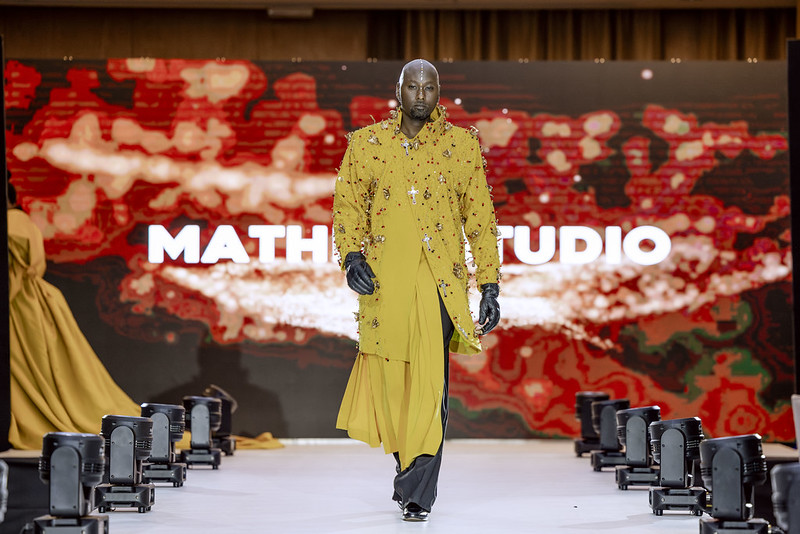 Model Franco Kabano on the runway show in the Kigali Triennial 2024's Fashion [PHOTO MYA]
Model Franco Kabano on the runway show in the Kigali Triennial 2024's Fashion [PHOTO MYA]
The fashion industry in Africa faces several challenges in achieving sustainability, primarily due to a combination of economic, social, and environmental factors. However, the African fashion industry is brimming with potential as stated in the UNESCO Report dubbed The African Fashion Sector: Trends, Challenges and Opportunities for Growth. A burgeoning middle class, a youthful and growing population, and rapid urbanization are creating a booming market for African-made clothing. African fashion designers, drawing inspiration from traditional techniques and a rich cultural heritage, are not only creating beautiful and unique garments but also fostering economic growth and empowering communities across the continent.
However, despite its undeniable potential, the African fashion industry also faces a number of significant challenges. These challenges include a lack of investment, limited educational and training opportunities, difficulty sourcing high-quality materials, and navigating complex intellectual property issues.
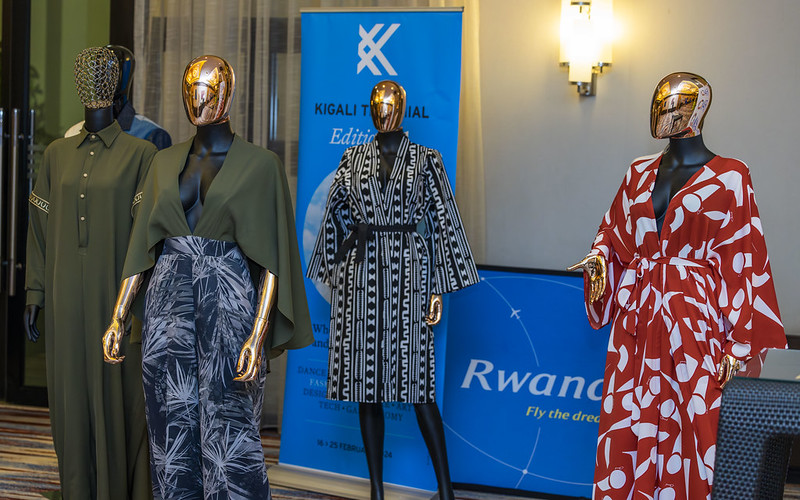
Made in Africa cloths during the exhibition at the Kigali Triennial 2024's Fashion [PHOTO MYA]
A Flourishing Market
Africa boasts a population of 1.2 billion people, with an estimated 60% being under the age of 25. This young demographic is fashion-forward and has a growing disposable income. A burgeoning middle class, with a taste for quality and a desire for unique pieces, is further propelling the demand for African fashion. Rapid urbanization is another key driver of growth in the fashion industry. As more and more Africans move to cities, the demand for ready-made clothing increases.
The rise of digital technologies is also playing a significant role in the growth of the African fashion industry. Online platforms are providing African designers with a global reach, allowing them to showcase their collections to a wider audience and connect with potential customers around the world. Social media is another powerful tool that African fashion designers are using to promote their brands and build a loyal following.
Cultural Inspiration and Economic Empowerment
African fashion is known for its vibrant colours, bold prints, and unique silhouettes. African designers are drawing inspiration from a rich cultural heritage, incorporating traditional textiles, techniques, and motifs into their contemporary designs. This not only creates visually stunning garments but also helps to preserve and promote African culture.
The growth of the African fashion industry is also having a positive impact on local economies. The industry is creating jobs, not only for designers and tailors but also for artisans, weavers, and other skilled workers. By promoting the use of locally sourced materials and traditional techniques, the fashion industry is helping to empower communities and foster sustainable economic development.
Moreover, the focus on locally sourced materials and traditional production techniques fosters sustainable practices. By promoting the use of organic cotton, natural dyes, and upcycled materials, African fashion designers are not only reducing their environmental footprint but also creating a demand for sustainable production methods. This not only benefits the environment but also promotes ethical sourcing and empowers local communities to build sustainable livelihoods.
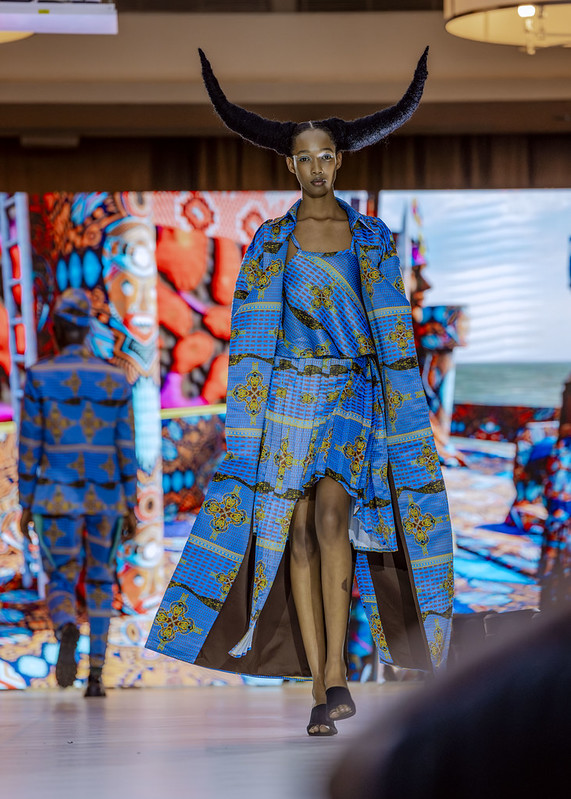
Model on the runway show in the Kigali Triennial 2024's Fashion [PHOTO MYA]
The Road Ahead: Challenges and Opportunities
The African fashion industry is at a crossroads. With its rich cultural heritage, talented designers, and growing market, the industry has the potential to become a major force in the global fashion landscape. However, in order to achieve this potential, a number of challenges need to be addressed.
There is a need for increased investment in the African fashion industry. This investment can come from a variety of sources, including governments, development agencies, and the private sector. Investment is needed to support the development of educational and training programs, improve infrastructure, and provide access to finance for African fashion businesses.
There is also a need for stronger intellectual property protection mechanisms in Africa. This will help to protect African designers from counterfeiting and ensure that they can reap the rewards of their creativity.
By addressing these challenges, stakeholders can help the African fashion industry to flourish. A thriving African fashion industry will not only create jobs and boost economic growth but also promote cultural identity and empower communities across the continent.
Bridging the Gap: Solutions for a Sustainable Future
The future of the African fashion industry hinges on addressing the aforementioned challenges and creating an ecosystem that fosters sustainable growth. Increased investment is crucial, and stakeholders from governments and development agencies to private investors and philanthropists need to recognize the industry’s potential and allocate resources accordingly. These investments can support the development of educational and training programs in fashion design, production, and business management.
Infrastructure development is also essential. Investing in textile manufacturing facilities, processing plants, and logistics networks can create a more efficient and cost-effective environment for domestic production. This will not only reduce reliance on imports but also improve the quality and consistency of locally sourced materials.
Strengthening intellectual property protection mechanisms in Africa is crucial to safeguard the creativity of designers. Governments need to implement stricter laws against counterfeiting and streamline the process for registering and protecting designs. Additionally, raising awareness about IP rights among designers and fashion businesses is essential.
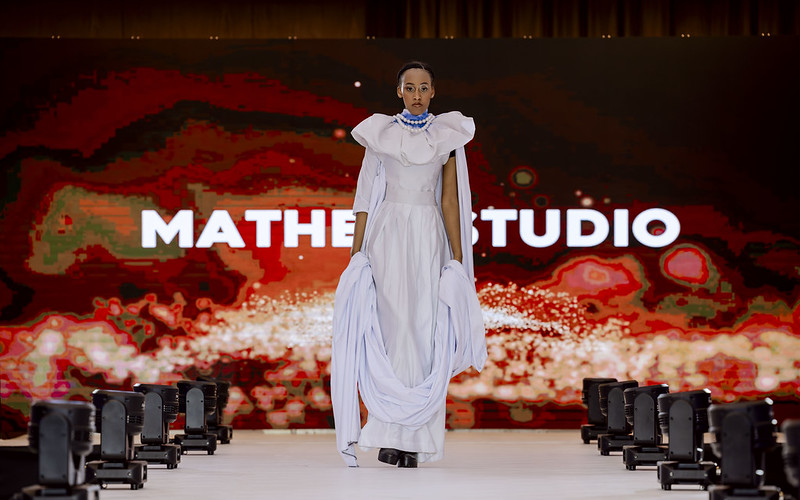
Model on the runway show in the Kigali Triennial 2024's Fashion [PHOTO MYA]
Beyond Borders: A Global Stage for African Fashion
The rise of digital technologies presents exciting opportunities for African fashion designers to reach a global audience. Online platforms like e-commerce websites and social media can be leveraged to showcase collections, connect with international buyers, and build a loyal customer base. Collaboration between African designers and international fashion brands can be a powerful driver of growth. Such partnerships can provide access to expertise, technology, and global distribution networks, allowing African designers to expand their reach and achieve greater commercial success.
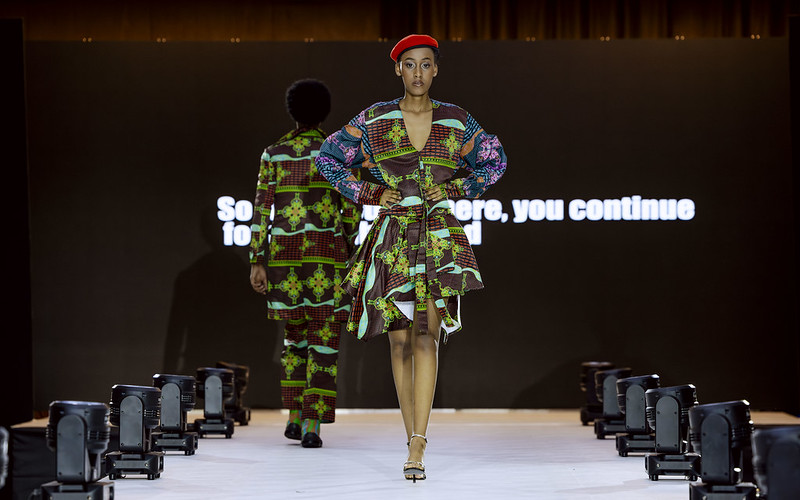
Model on the runway show in the Kigali Triennial 2024's Fashion [PHOTO MYA]
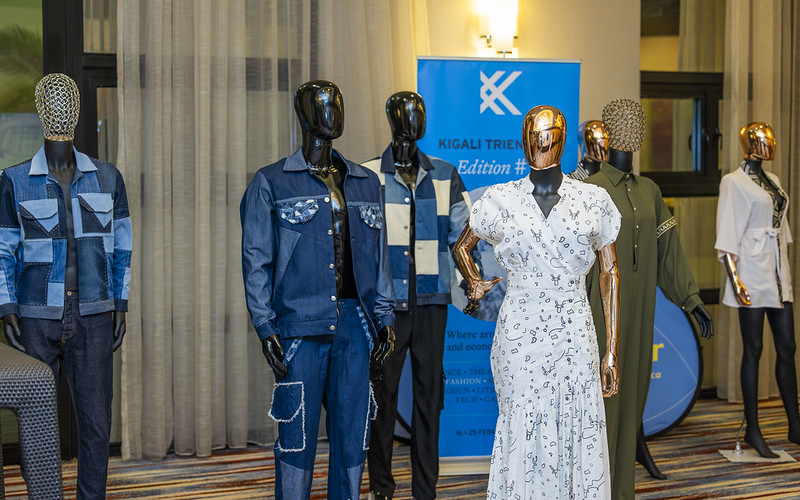
Made in Africa cloths during the exhibition at the Kigali Triennial 2024's Fashion [PHOTO MYA]
Article source Couture Africa
The Man Behind the Kigali Fashion Week: The Story of John Bunyenshuri
 John Bunyeshuli CEO and founder of the Kigali Fashion Week [PHOTO IGIHE]
John Bunyeshuli CEO and founder of the Kigali Fashion Week [PHOTO IGIHE]
Since the inception of Kigali Fashion Week, one man has stood as the driving force and mastermind behind this thriving brand. With a friendly demeanor that exudes cultural sophistication and goodwill toward others, John Bunyenshuri embodies the essence of a true cosmopolitan gentleman.
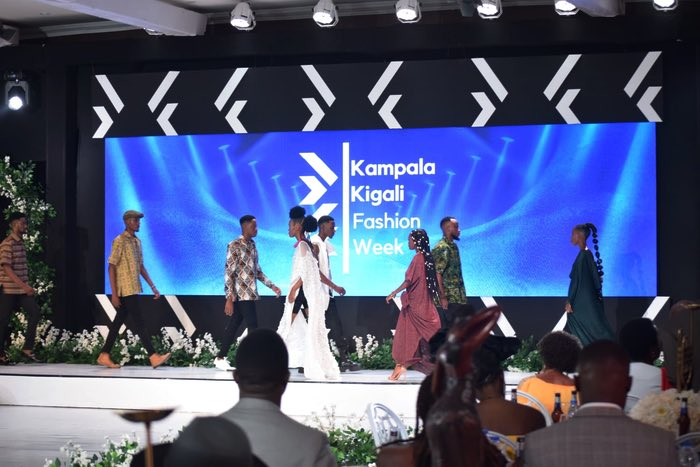 Kigali Kampala Fashion Week orga ized by Bunyeshili [PHOTO KFW]
Kigali Kampala Fashion Week orga ized by Bunyeshili [PHOTO KFW]
Growing up in Uganda, Bunyenshuri was known as the class clown, always bringing joy and laughter to those around him. His fondest memories include lively outings with friends, painting the town red with wine, laughter, and dancing.
At Namasagali College in Eastern Uganda, Bunyenshuri led his dance group, the “Creative Dance Troupe,” on memorable trips to the Capital Kampala to then popular Suzanna Night Club.
Even in his formative years, he recognized that showbiz was his true calling. Fate intervened when his family, facing persecution during Obote’s regime, relocated to Vancouver, Canada.
 Second from [RIGHT]; John Bunyeshuli with his team [PHOTO KFW]
Second from [RIGHT]; John Bunyeshuli with his team [PHOTO KFW]
ALSO READ: "Kigali Fashion Week is Still Running": Interview with the CEO and Founder John Bunyeshuli.
He pursued his studies at San Antonio Community College before venturing to London to study at the London City Lit College for the Creative Arts, specializing in Camera Acting and Theater.
“I may be shy by nature, but acting allows me to transform into a whole new persona. When I’m in front of the camera or on stage, I become extroverted, embracing my alter-ego,” John reflects his love for acting.
His journey led him to New York in 1993, where he embarked on a career in the entertainment industry. It was during this time that he discovered a passion for jazz music, mentored by a Jewish-Scottish saxophonist.
Additionally, he found success working with Suzan Scott of the Suzan Scott Agency, portraying a Luther Vandross look-alike for gigs and commercial advertisements.
“With earnings from my work as Luther Vandross, I made a down payment on an apartment in Brooklyn. Around that time, I was in my first relationship and had my first daughter. She, too, has found her place in the entertainment industry,” Bunyenshuri shares.
Although the relationship didn’t last, he found love again and had his second born daughter, also pursuing a career in entertainment.
Motivated by his experiences, John Bunyenshuri made it his mission to advocate for young talents in the industry, ensuring they receive fair treatment and opportunities.
 KFW 2023 [PHOTO KFW]
KFW 2023 [PHOTO KFW]
In 2011, Bunyenshuri came to Rwanda and founded Kigali Fashion Week, aiming to support local talent and generate employment opportunities for youth both locally and internationally.
Today, Kigali Fashion Week has expanded to major cities like London, New York, Amsterdam, and Tokyo, showcasing Rwandan creativity on a global scale.
Looking ahead, Bunyenshuri has exciting plans, including partnering with Bella Flowers to launch Kigali Flower Festival in February next year. Additionally, he’s forming a jazz band, Twilight Jazz Groove, poised for a forthcoming launch, further enriching Rwanda’s cultural landscape.
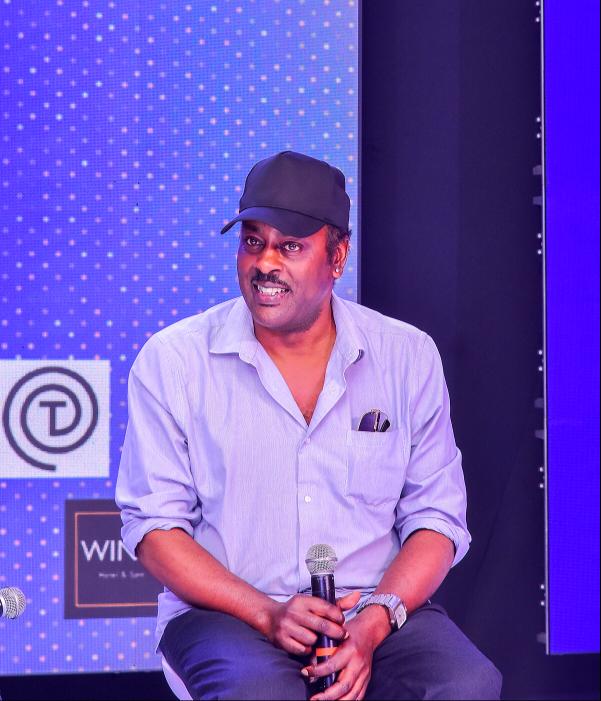 John Bunyeshuli CEO & founder of the Kigali Fashion Week, during the conference in Kampala - Kigali Fashion Week 2023 fashion discussions [PHOTO KFW]
John Bunyeshuli CEO & founder of the Kigali Fashion Week, during the conference in Kampala - Kigali Fashion Week 2023 fashion discussions [PHOTO KFW]
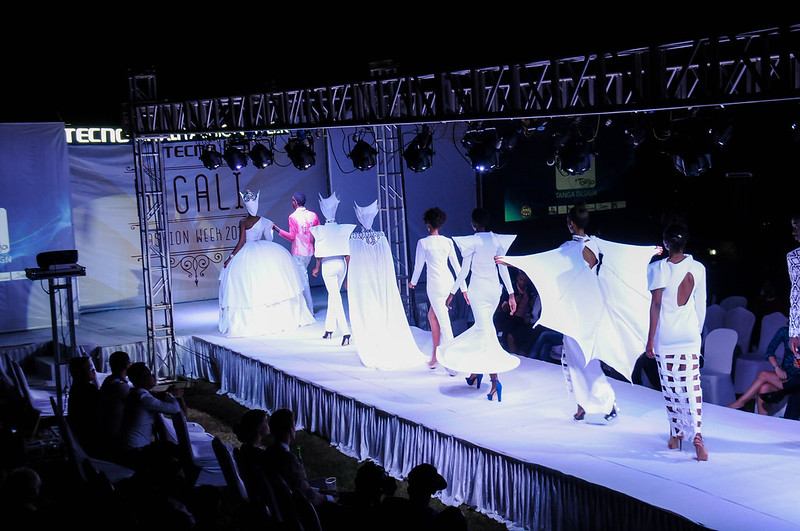 [PHOTO KFW 2015]
[PHOTO KFW 2015]
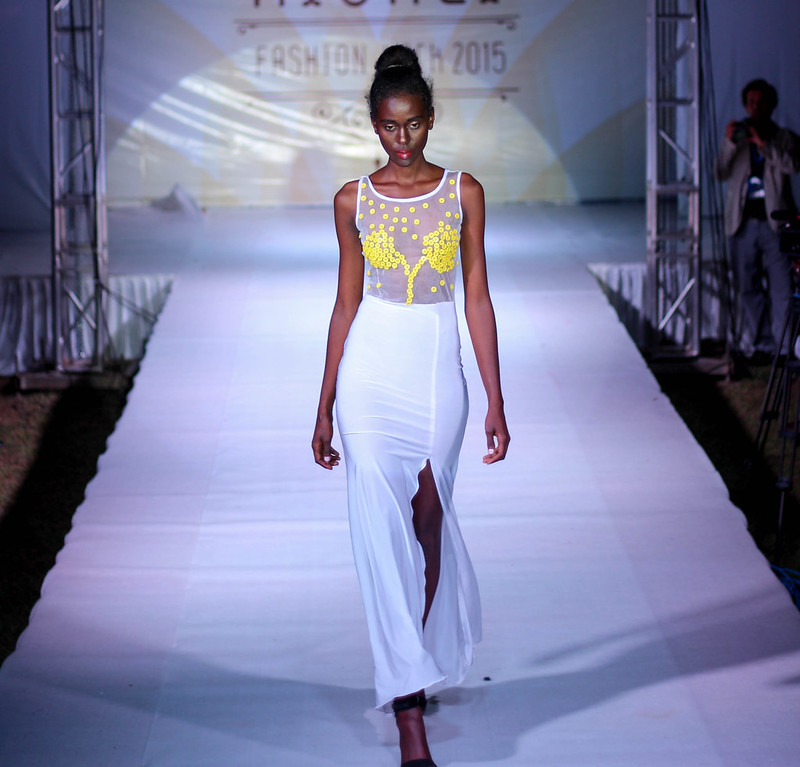 [PHOTO KFW 2015]
[PHOTO KFW 2015]
 [PHOTO KFW 2015]
[PHOTO KFW 2015]
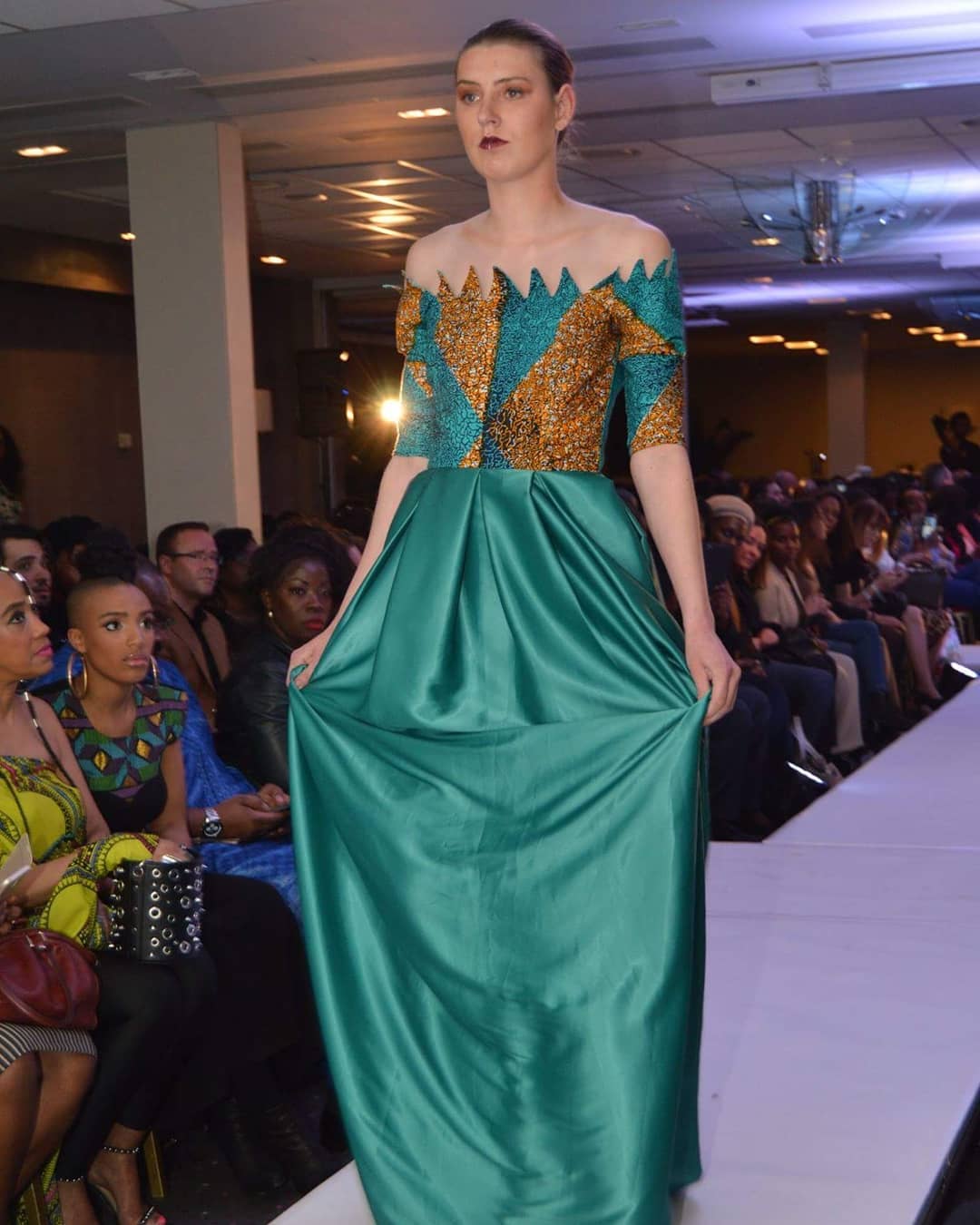 [PHOTO KFW 2018]
[PHOTO KFW 2018]
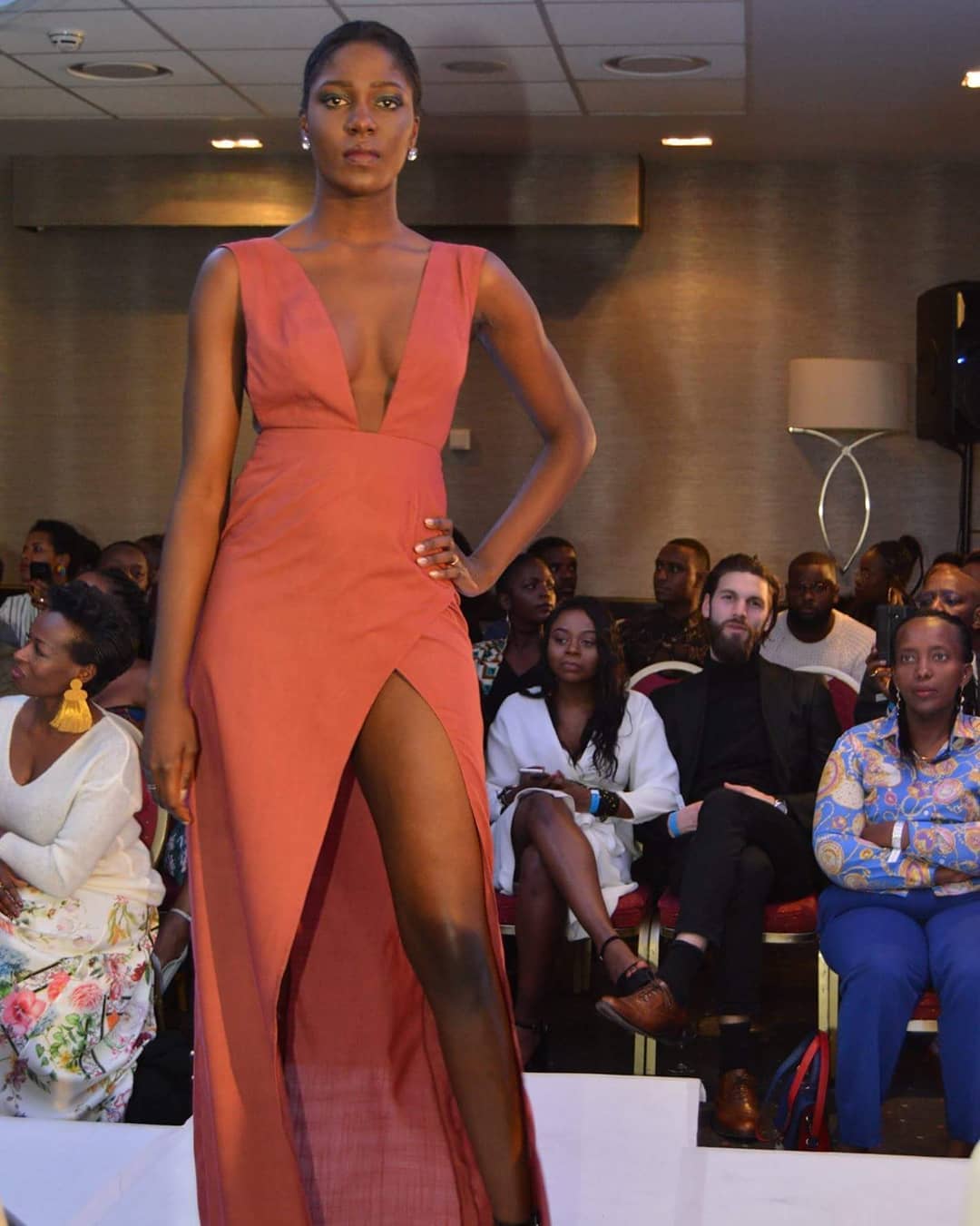
[PHOTO KFW 2018]
Winner of Rising Sustainable Brand Award in New York 2024: The rise of Asantii to a global sustainable fashion brand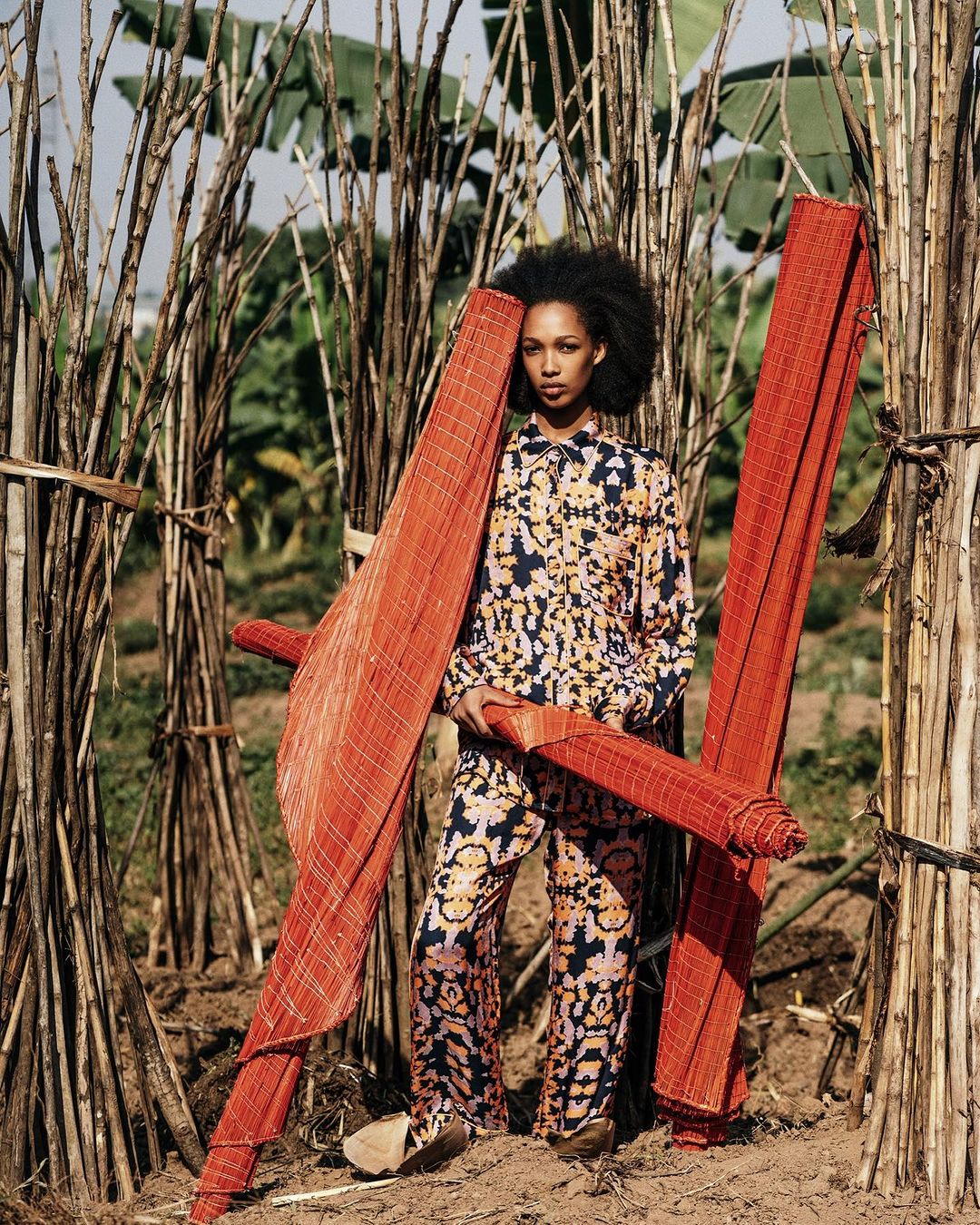
Made by ASANTII clothing brand based in Kigali- Rwanda[PHOTO ASANTII]
After winning the prestigious 2024 Rising Sustainable Brand Award in New York, Rwandan based clothing line Asantii is primed to push its brand to the global market, according to Asanti’s analyst, Noble Nziza. Speaking to The New Times, Nziza said that “this prize inspired and motivated Asantii to keep pushing for the globalization of Made in Africa”. He added that Asantii’s road to being a global sustainable brand is truly one with intention and commitment to its people and the planet.
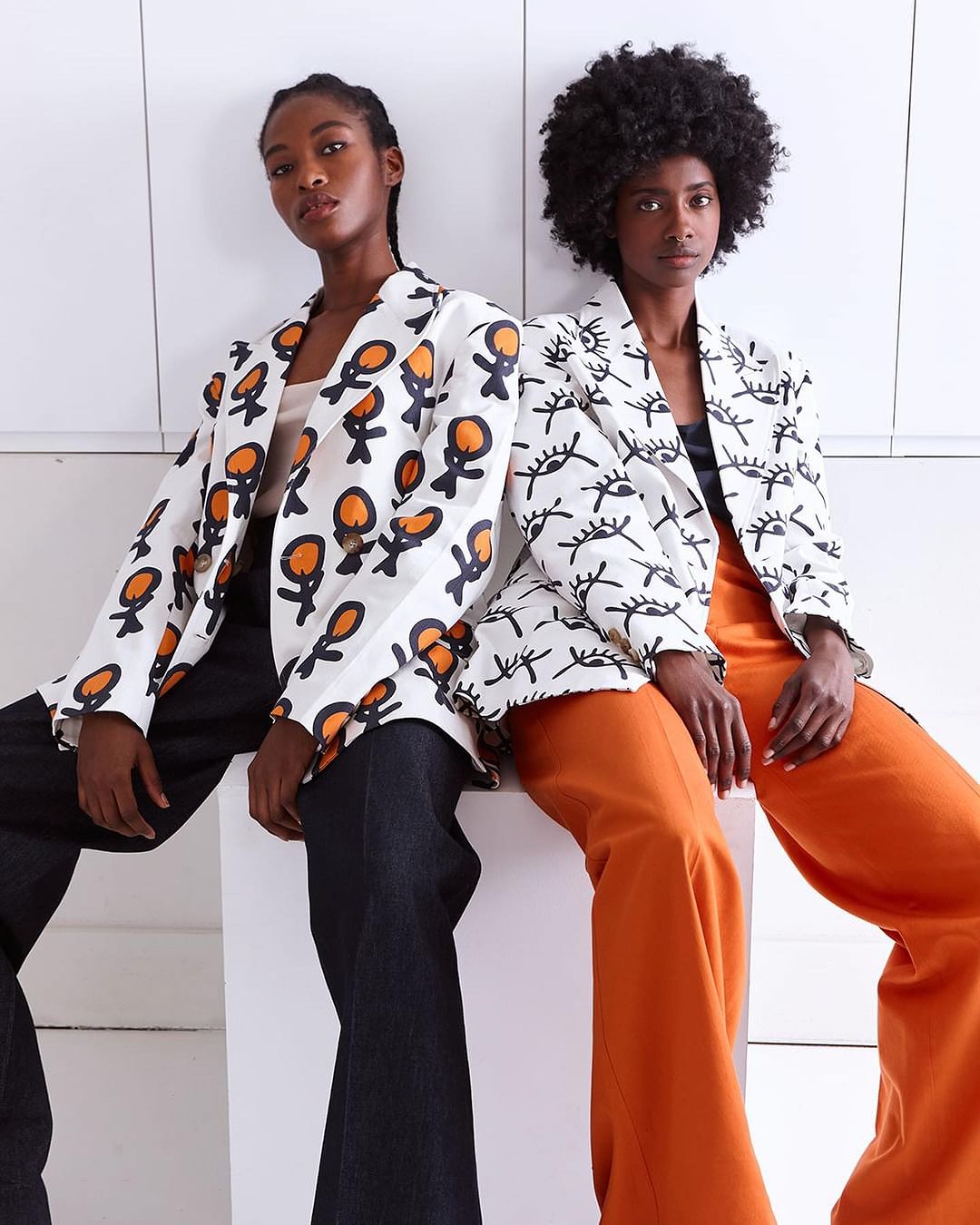
Made by ASANTII clothing brand based in Kigali- Rwanda[PHOTO ASANTII]
Founded by Rwandan entrepreneur, . She is a Rwandan woman entrepreneur with over 20 years of experience in the global fashion and garments industry in Europe but also in China and South East Asia and more recently since 2017, in Africa. Maryse is the founder of Pink Mango, an export-focused garment trading and manufacturing group. She is also the co-founder of the C&D Pink Mango Rwanda joint venture, a group of export-oriented garment factories employing jointly 5,000 workers in Rwanda to date, 70% of whom are women.
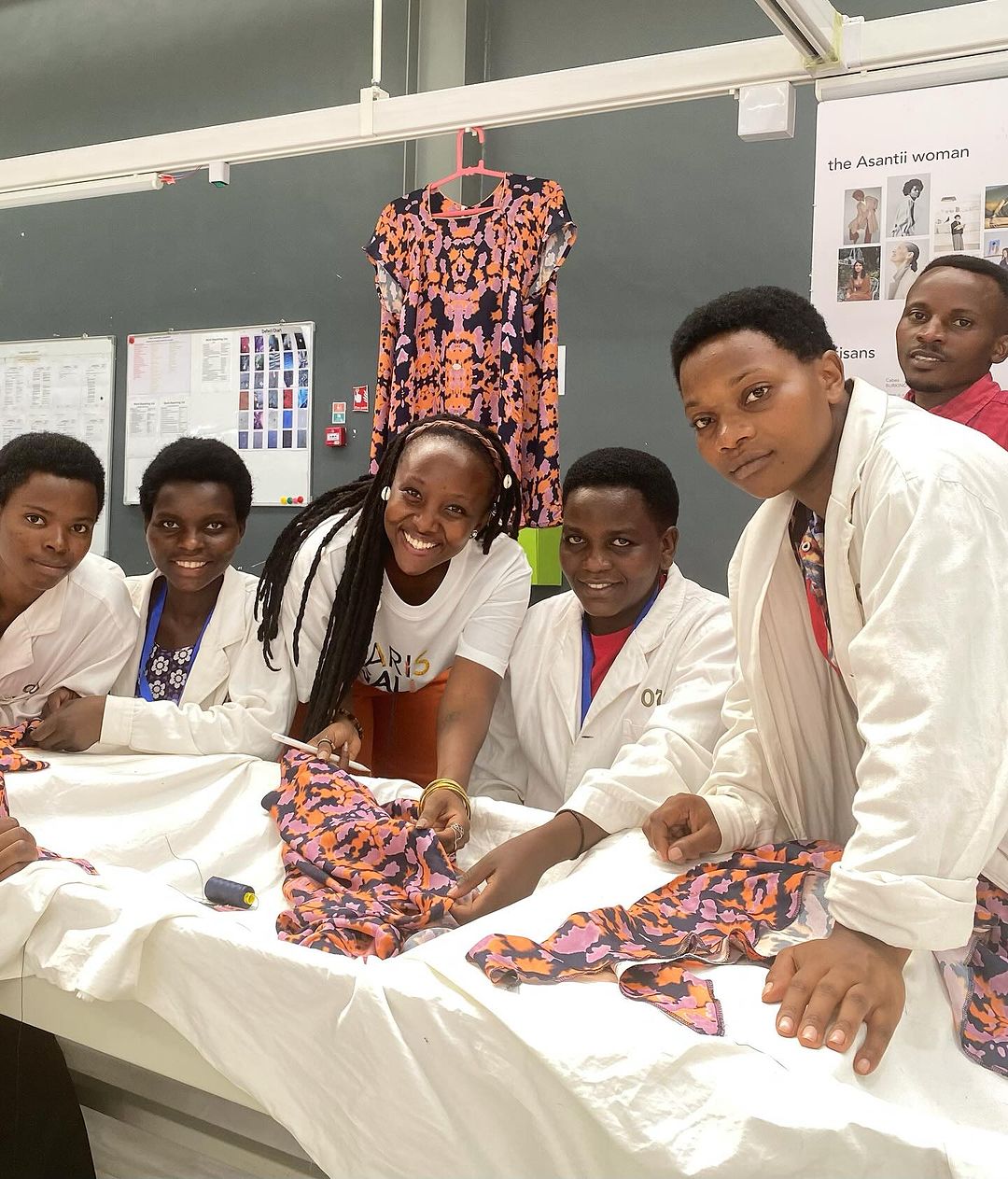
Workers inside ASANTII shop in Rwanda[PHOTO ASANTII]
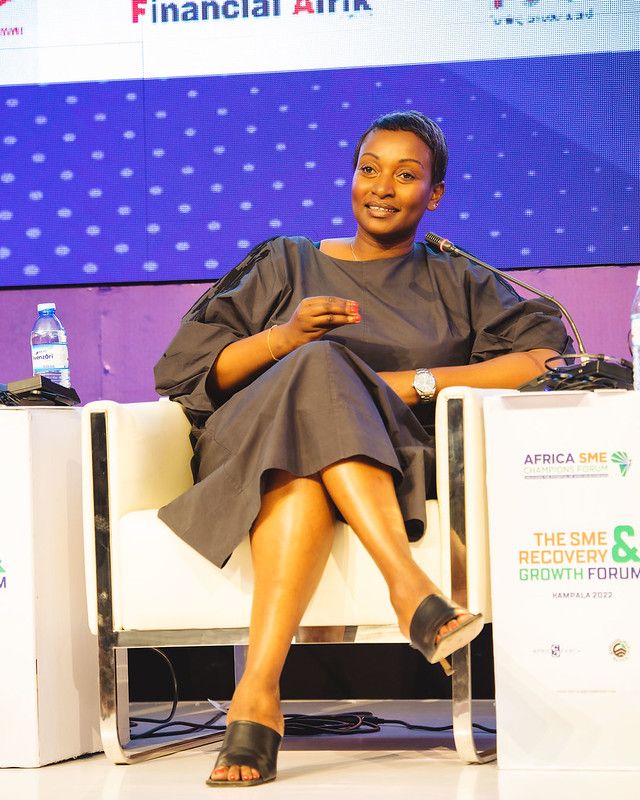
Maryse Mbonyumutwa CEO and founder of the ASANTII clothing brand { PHOTO ASANTII]
In 2022, Asantii, in February got recognised during an event hosted by Coterie New York, an organisation that links up-and-coming designers with knowledgeable insiders who can change the direction of fashion. The event was held on February 22, and was attended by 760 other people in the fashion sector from across the world.
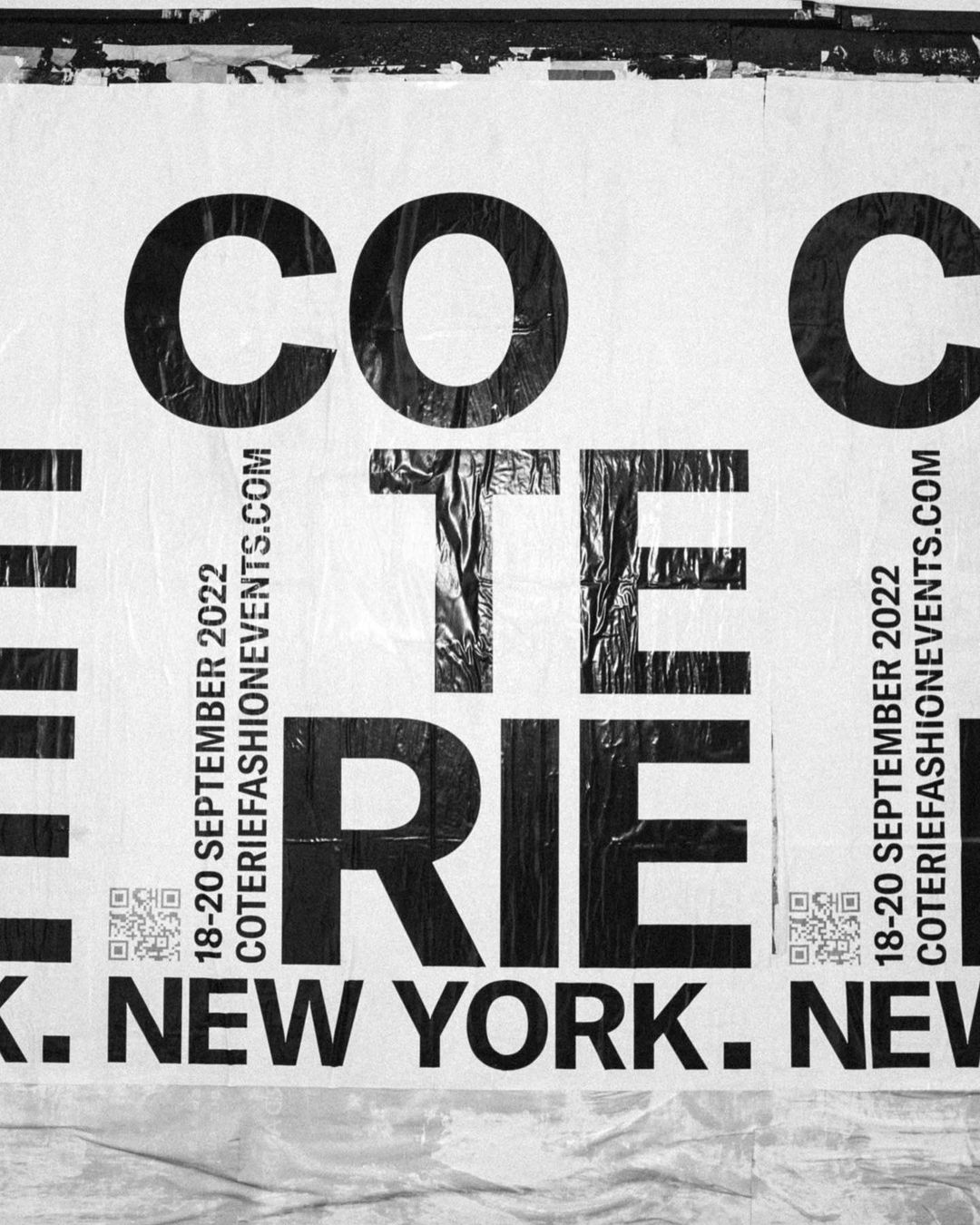 “When you meet other brands in the community you realize everyone has the same hustle - fashion owners, fashion designers, fashion sellers - I love that aspect of COTERIE." - J Squared Showroom
“When you meet other brands in the community you realize everyone has the same hustle - fashion owners, fashion designers, fashion sellers - I love that aspect of COTERIE." - J Squared Showroom
Their commitment to sustainability is based on the concept of "ubuntu," which translates as humanity; it is the idea that "I am" because "we are." It is seen largely in how they have established a conducive environment for their workers by giving daily meals, monthly sanitary pads, and subsidized groceries to all factory workers.
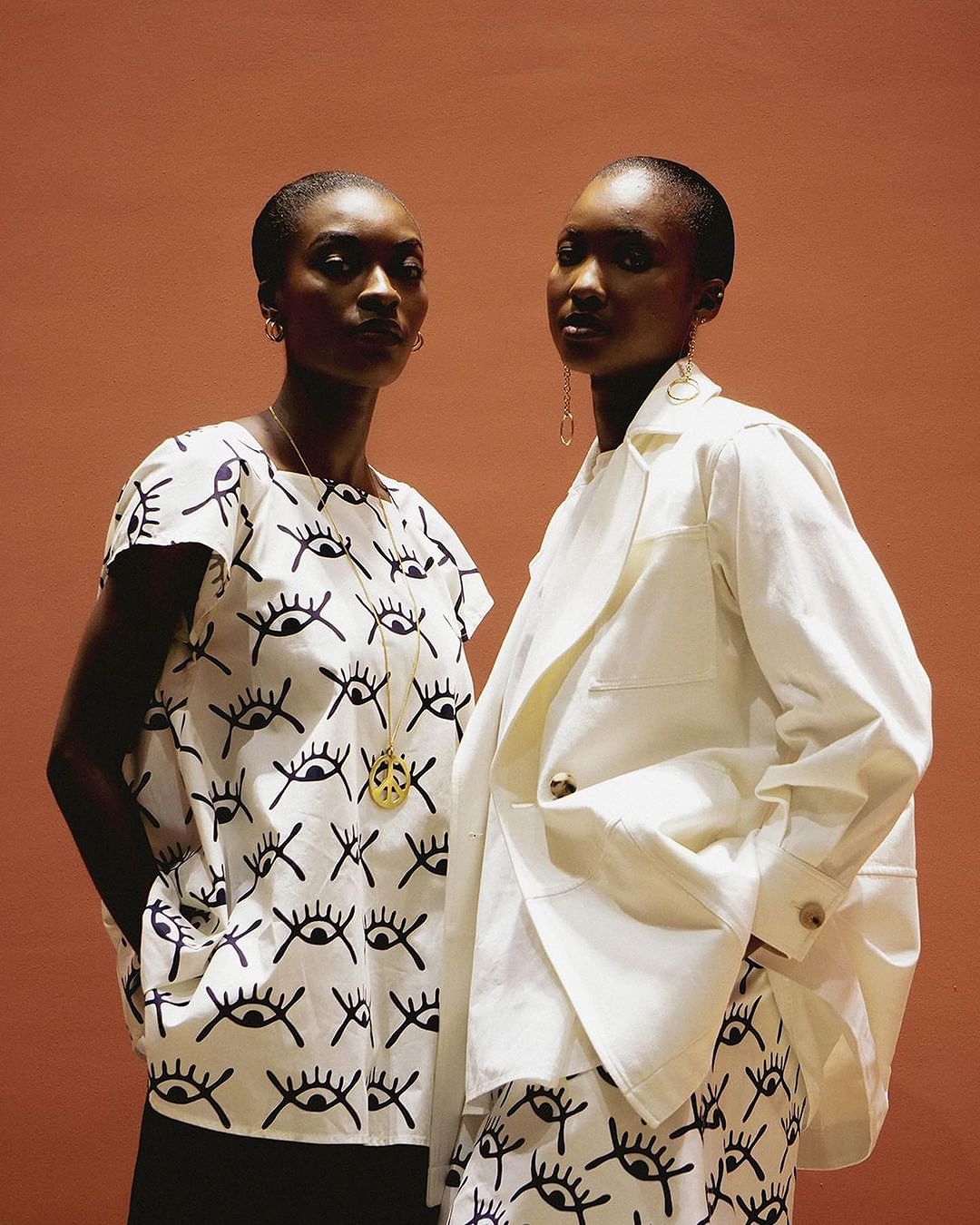 Made by ASANTII clothing brand based in Kigali- Rwanda[PHOTO ASANTII]
Made by ASANTII clothing brand based in Kigali- Rwanda[PHOTO ASANTII]
Asantii believes that this is the first project of its kind, as they have made it their mission to add value to the rich skills Africa has. 80 per cent of the materials are sourced from the continent because Asantii is particularly conscious of the origins of its raw resources; their denim is sourced from Egypt, their cotton is sourced from Madagascar, and their added novelty fabrics are hand woven in Burkina Faso. They have also partnered with cooperatives in Rwanda for broidery and in South Africa for beading.

Made by ASANTII clothing brand based in Kigali- Rwanda[PHOTO ASANTII]
To create their collections, the Asantii team brings together 14 African designers they work with, each with their own brand, to share inspiration and heritage, rooted in the continent right from the initiation phase. Asantii particularly merges cultural heritage and industry knowledge to create timeless and effortless essentials that pay homage to Africans. The purpose of this project is to address the issue of Africa's thin representation in the global fashion industry—less than one per cent.
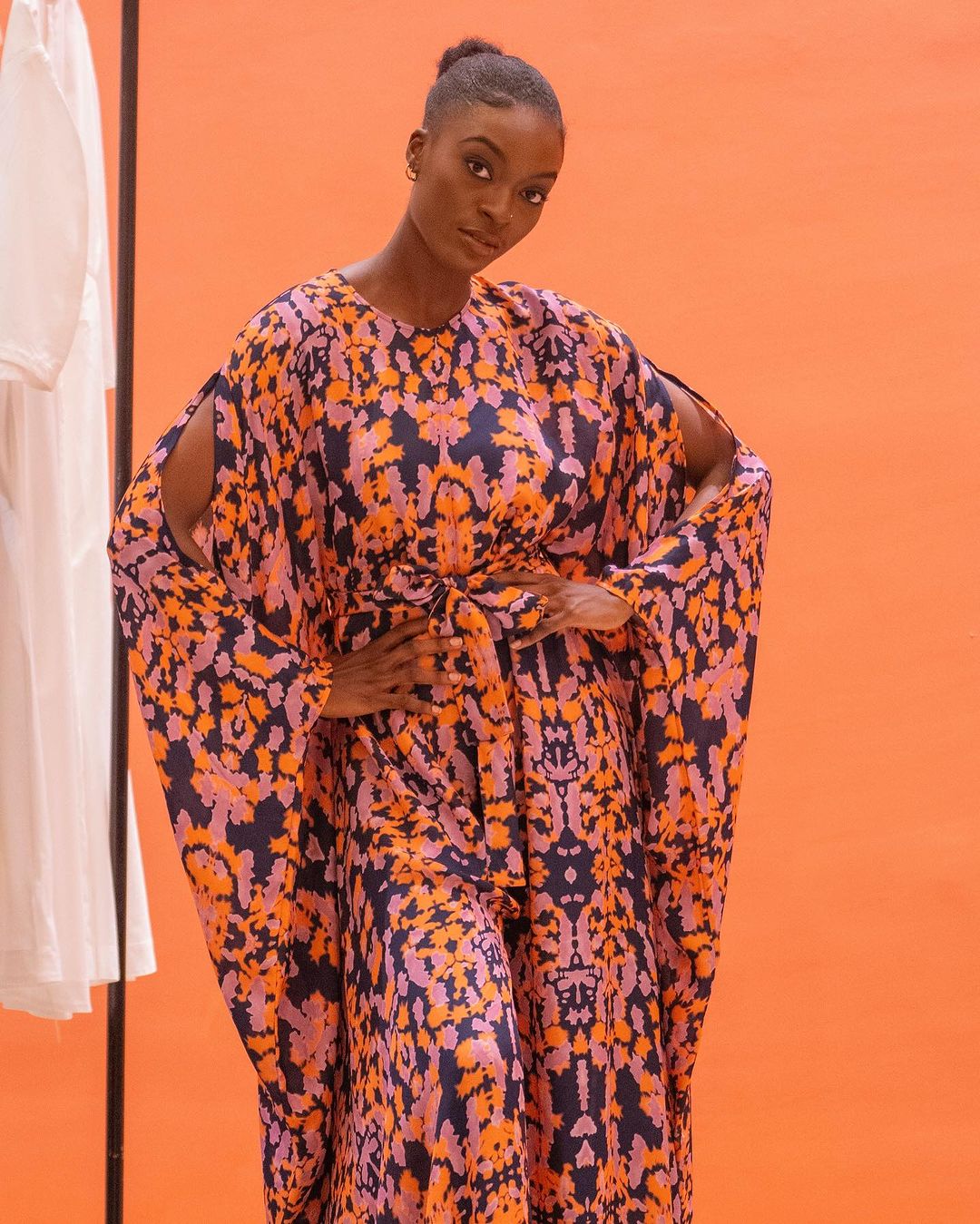 Made by ASANTII clothing brand based in Kigali- Rwanda[PHOTO ASANTII]
Made by ASANTII clothing brand based in Kigali- Rwanda[PHOTO ASANTII]
The purpose of this project is to address the issue of Africa's thin representation in the global fashion industry—less than 1%. To widen the representation of fashion in Africa, Asantii became part of the first export and domestic garment factory in Rwanda and embarked on a passionate, sustainable journey.
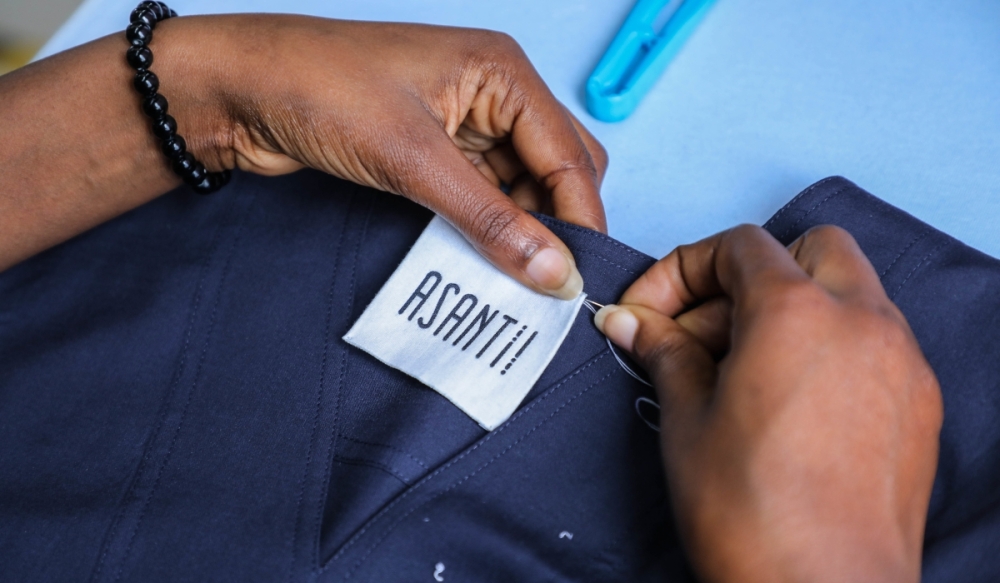
Made by ASANTII clothing brand based in Kigali- Rwanda[PHOTO ASANTII]
Maryse’s dedication to creating meaningful development in Africa, hence her decision to set up Pink Ubuntu, a CSR program which aims to improve the living conditions of workers, particularly women in the textile and garment industries across the African continent. The clothing brand ASANTI is a contemporary pan African clothing brand celebrating the continent’s heritage and craftsmanship through sustainable and fair fashion. Asantii was launched in August 2022 and is currently available online and in selected concept stores in Kigali, Accra, Abidjan, London, New York, and Brussels.
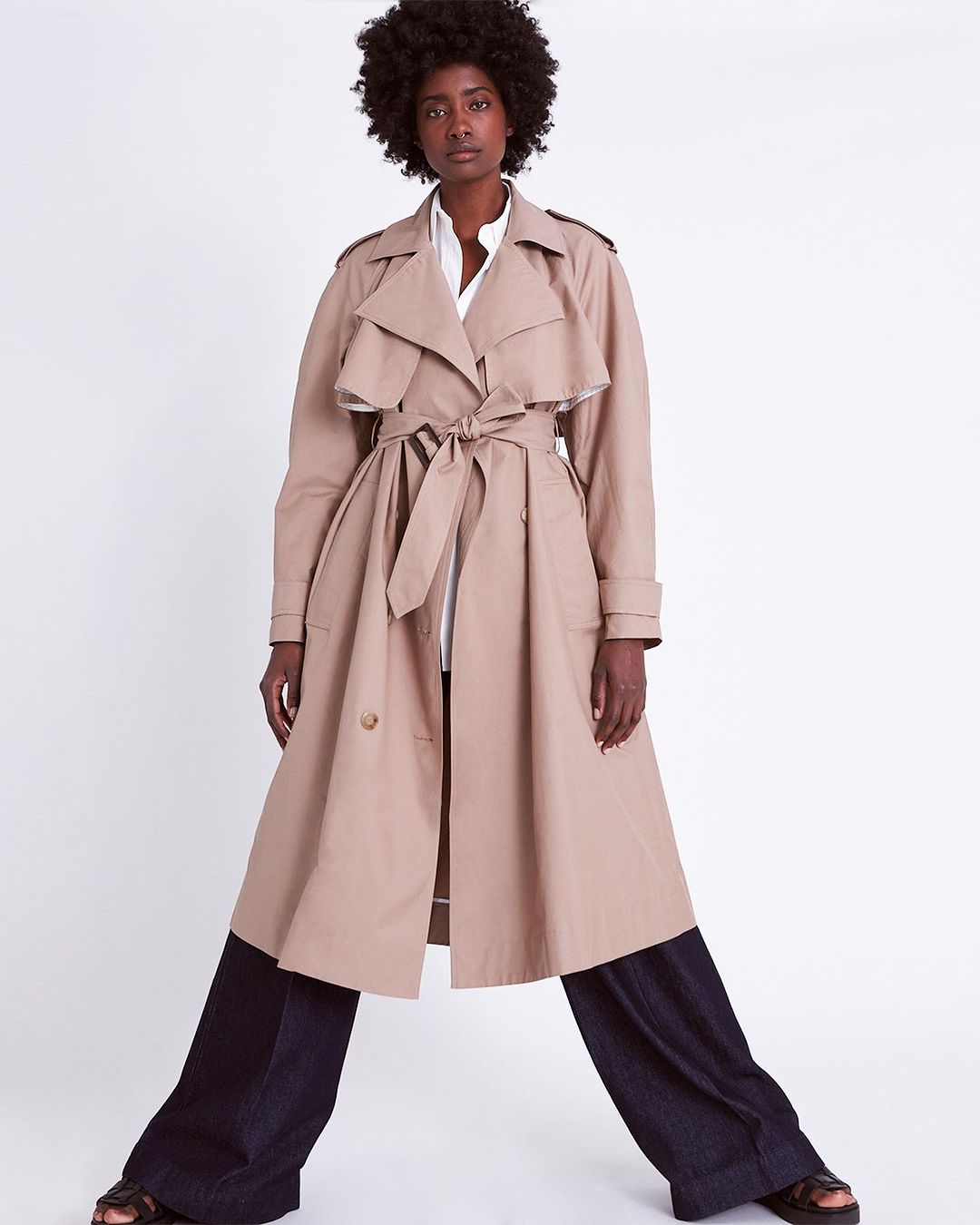 Made by ASANTII clothing brand based in Kigali- Rwanda[PHOTO ASANTII]
Made by ASANTII clothing brand based in Kigali- Rwanda[PHOTO ASANTII]
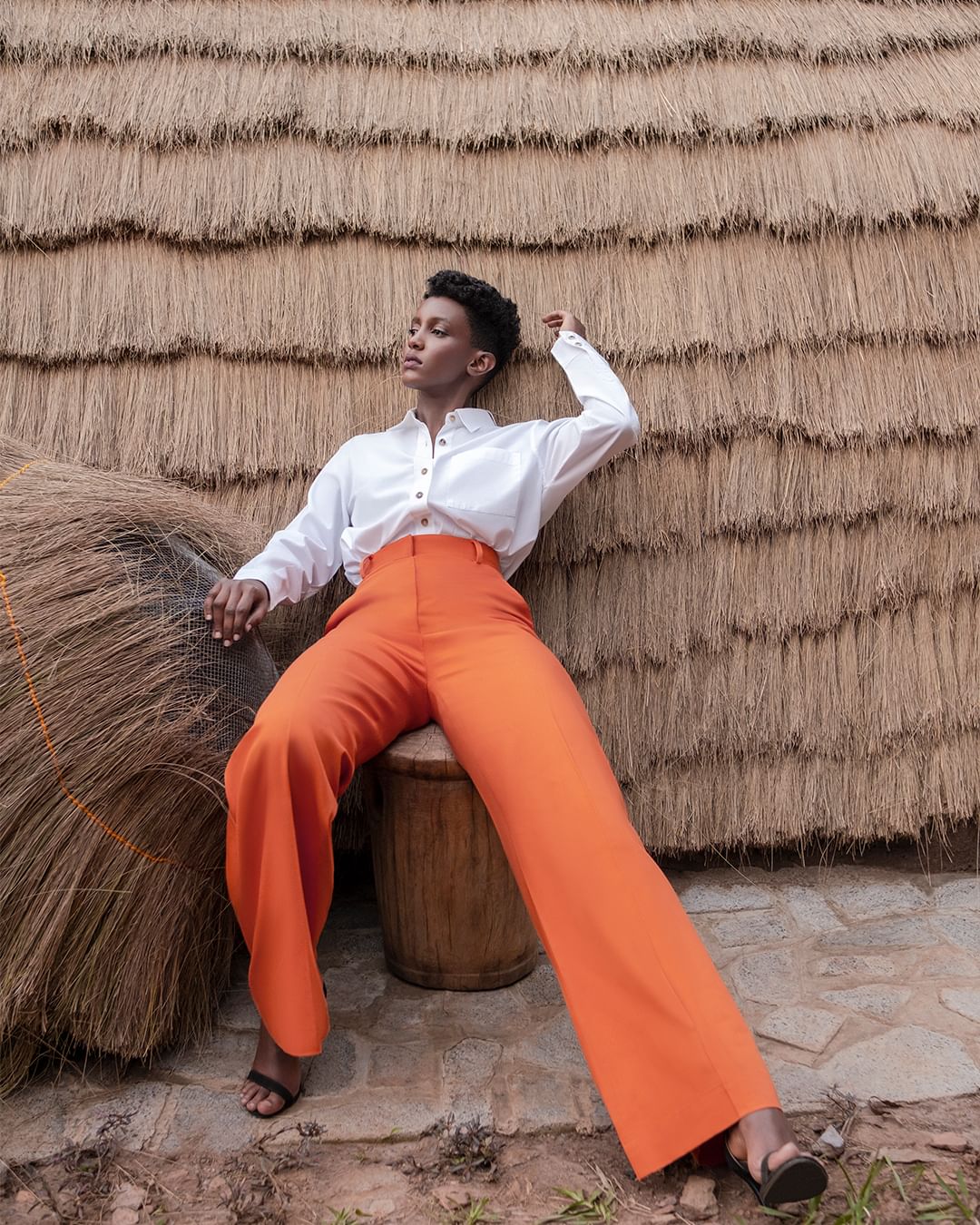 Made by ASANTII clothing brand based in Kigali- Rwanda[PHOTO ASANTII]
Made by ASANTII clothing brand based in Kigali- Rwanda[PHOTO ASANTII]
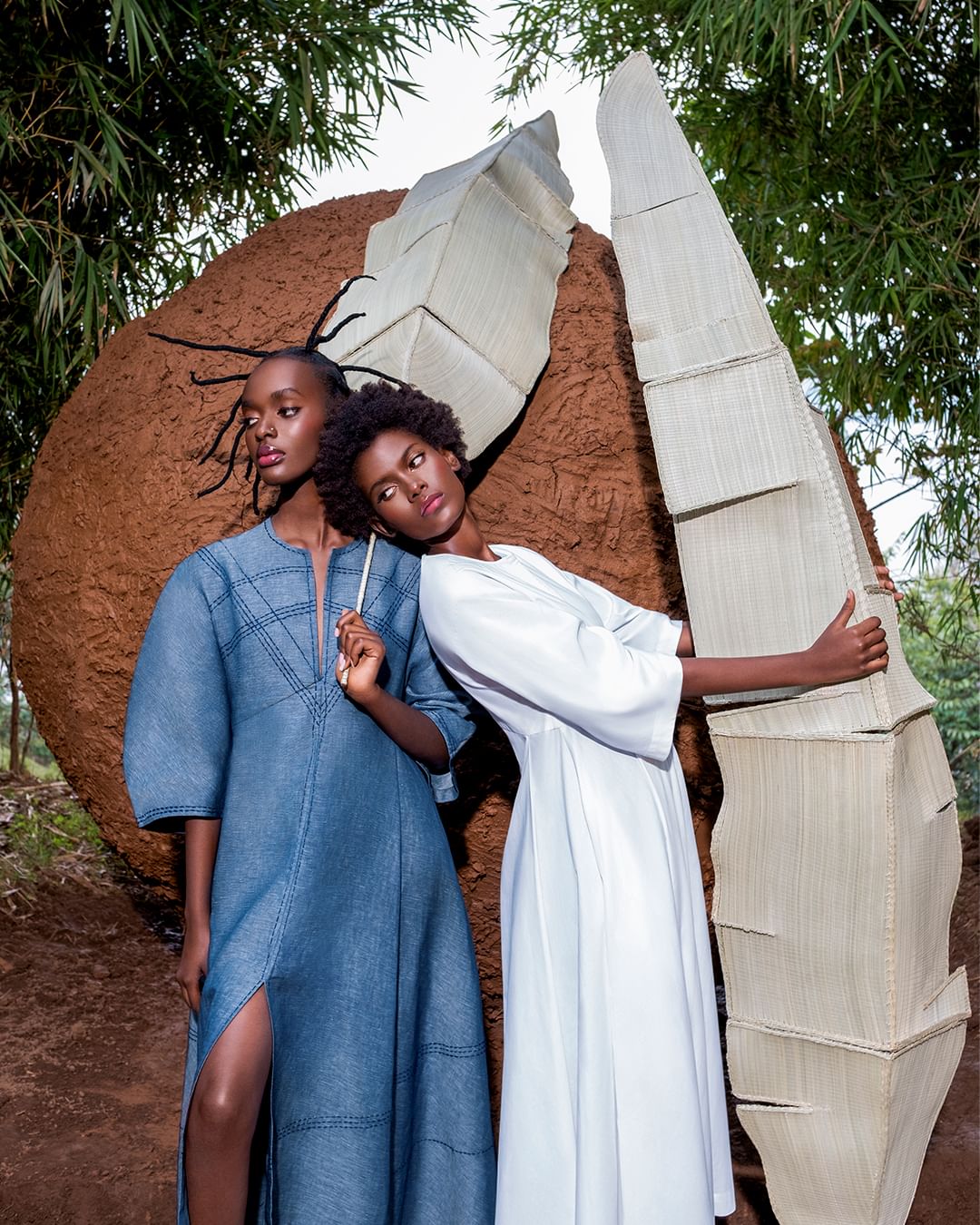
Made by ASANTI clothing brand based in Kigali- Rwanda[PHOTO ASANTI]
"Infaransa collection is not fully released. That was a pre-lunch event to meet with our clients and of course fashion lovers and fashion enthusiasts. The big event will be taking place in May 2024, in Paris" Moses Turahirwa Creative Designer and the founder of Moshions told the RCFS's Media
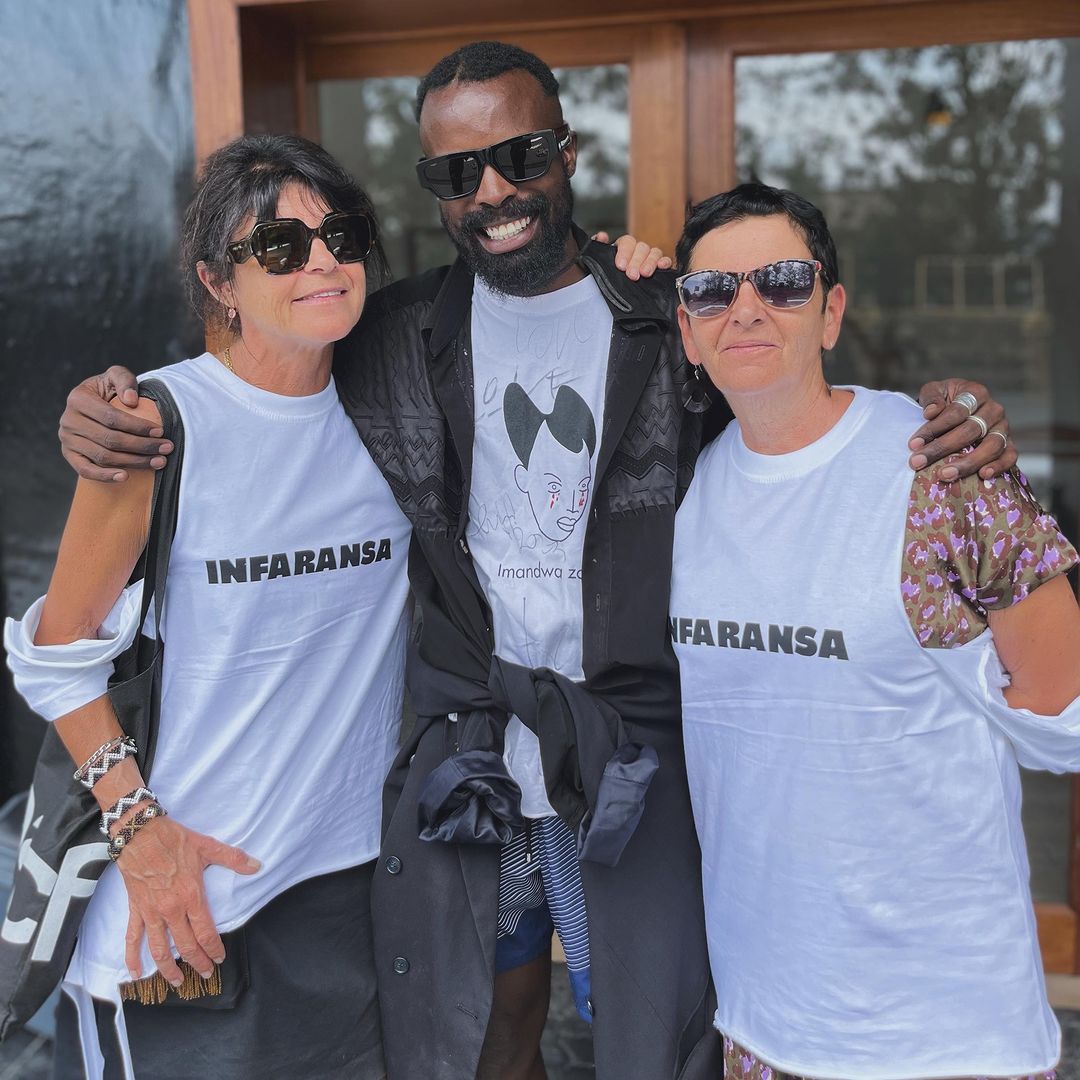 In a black jacket Mr. Moses Turahirwa, a fashion designer and the founder of Moshions [PHOTO KWANDAS1]
In a black jacket Mr. Moses Turahirwa, a fashion designer and the founder of Moshions [PHOTO KWANDAS1]
The Moshions a luxury fashion brand from Rwanda, recently debuted its latest couture collection, Infaransa. The launch showcased a diverse range of creatively designed outfits on the runway, featuring music artists and renowned models.
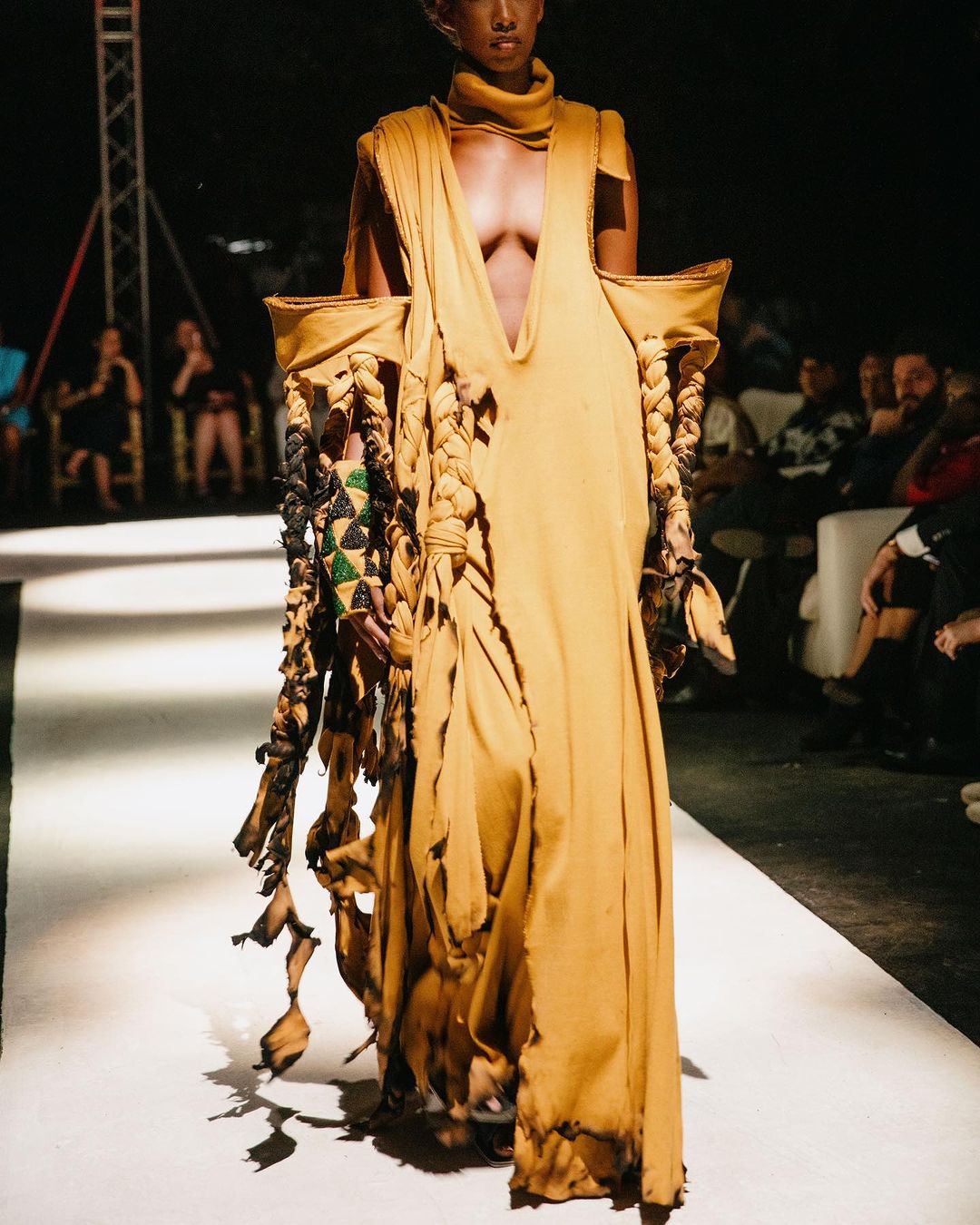 INFARANSA Collection made by MOSHIONS [PHOTO KWANDAS1]
INFARANSA Collection made by MOSHIONS [PHOTO KWANDAS1]
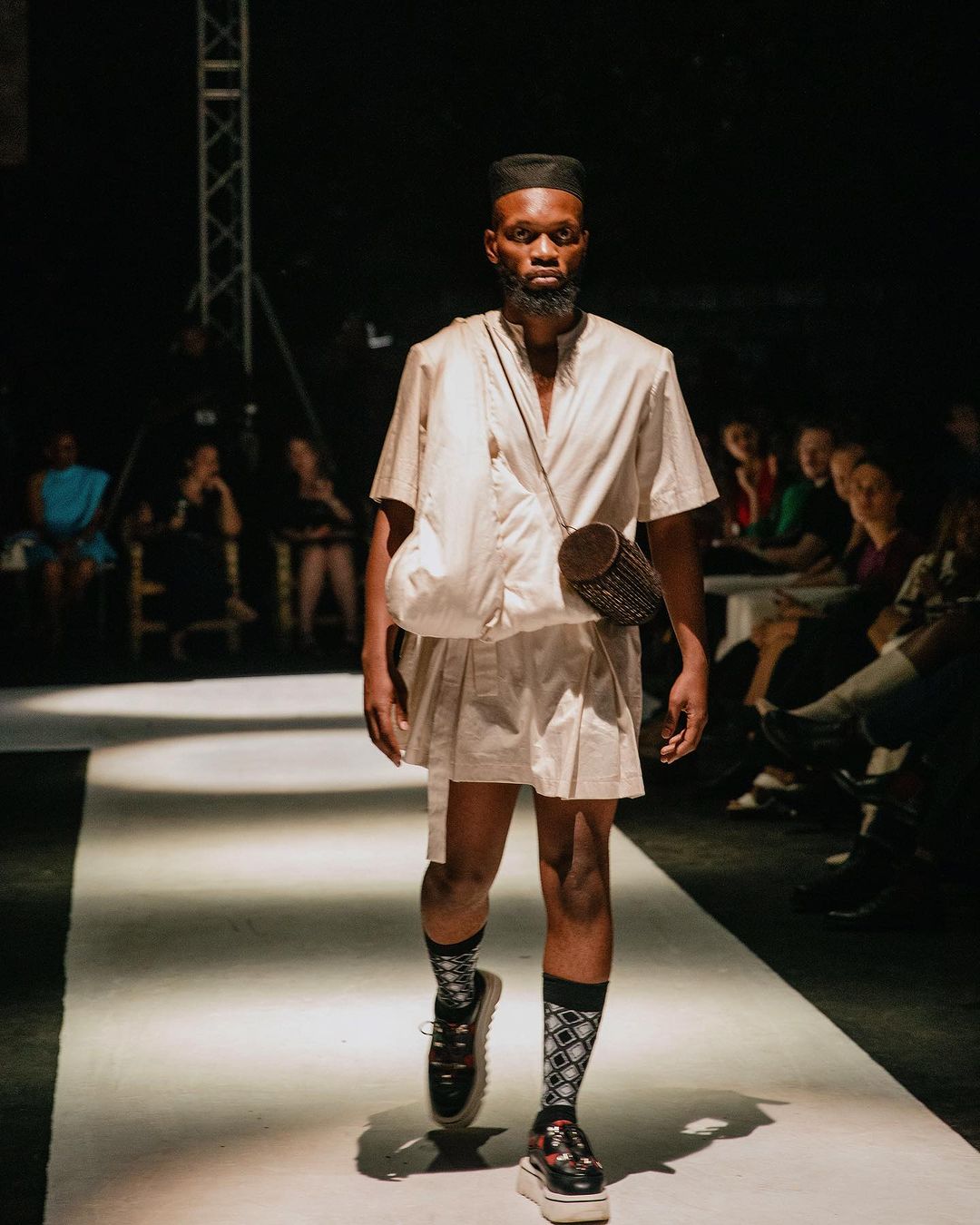 INFARANSA Collection made by MOSHIONS [PHOTO KWANDAS1]
INFARANSA Collection made by MOSHIONS [PHOTO KWANDAS1]
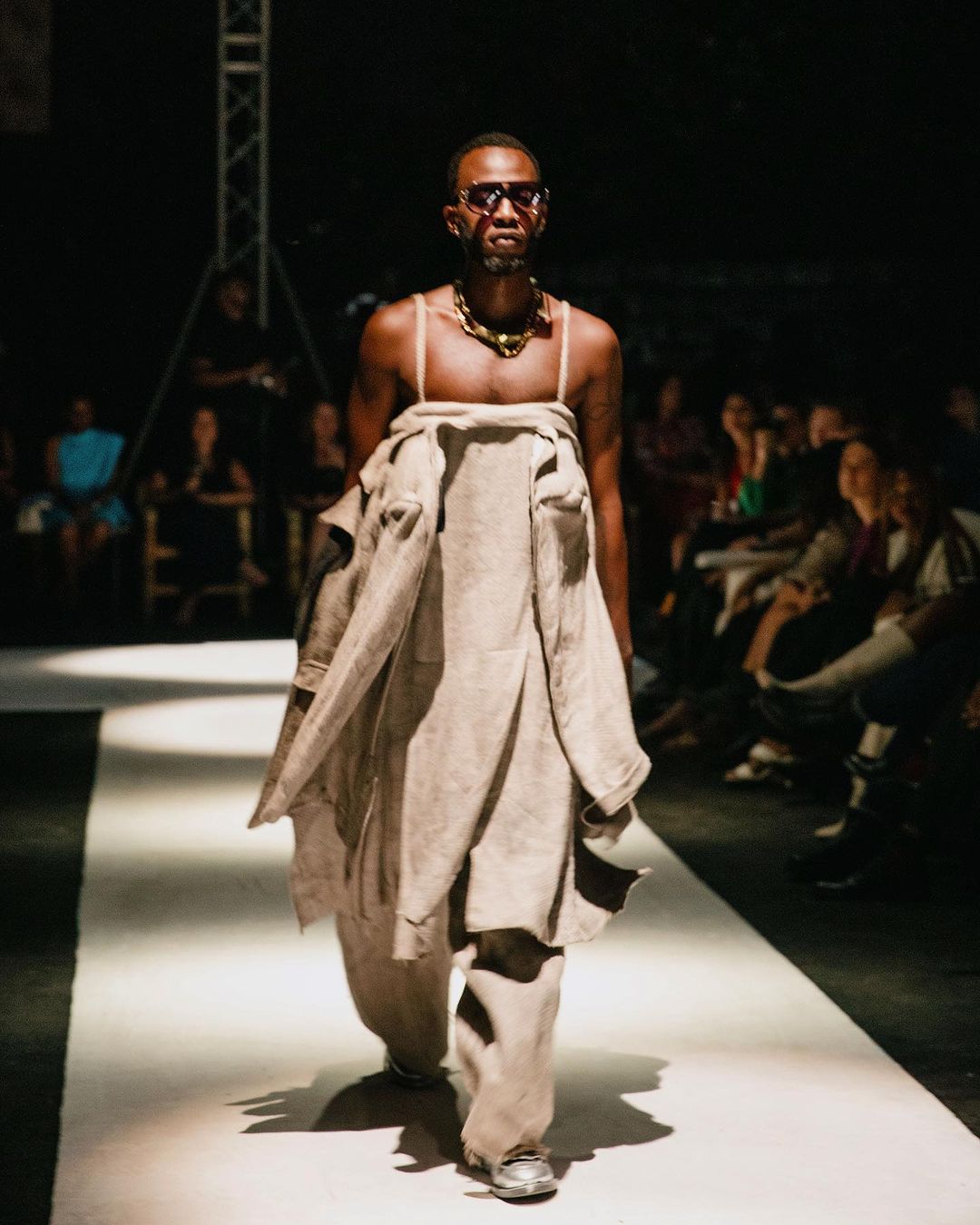 INFARANSA Collection made by MOSHIONS [PHOTO KWANDAS1]
INFARANSA Collection made by MOSHIONS [PHOTO KWANDAS1]
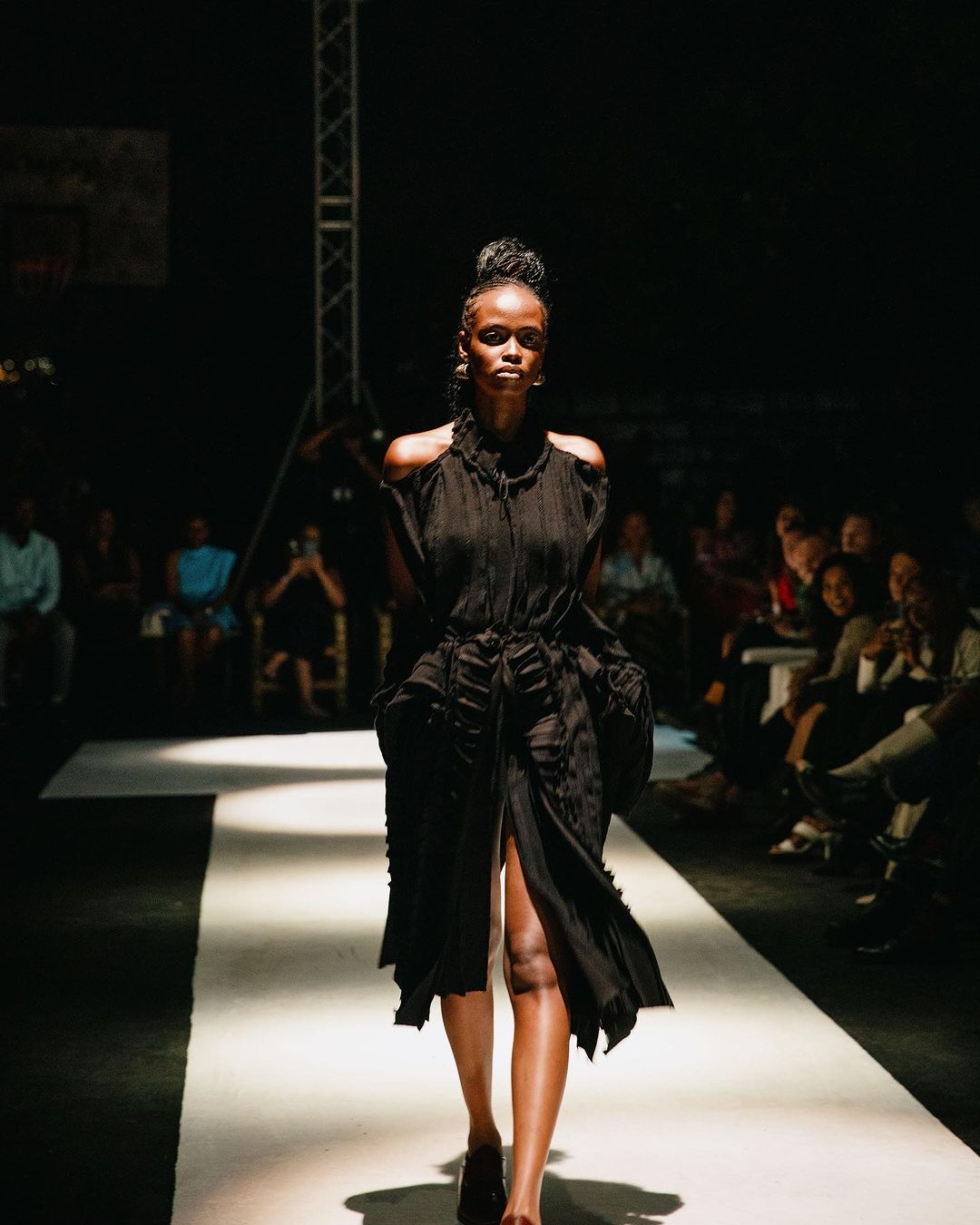 INFARANSA Collection made by MOSHIONS [PHOTO KWANDAS1]
INFARANSA Collection made by MOSHIONS [PHOTO KWANDAS1]
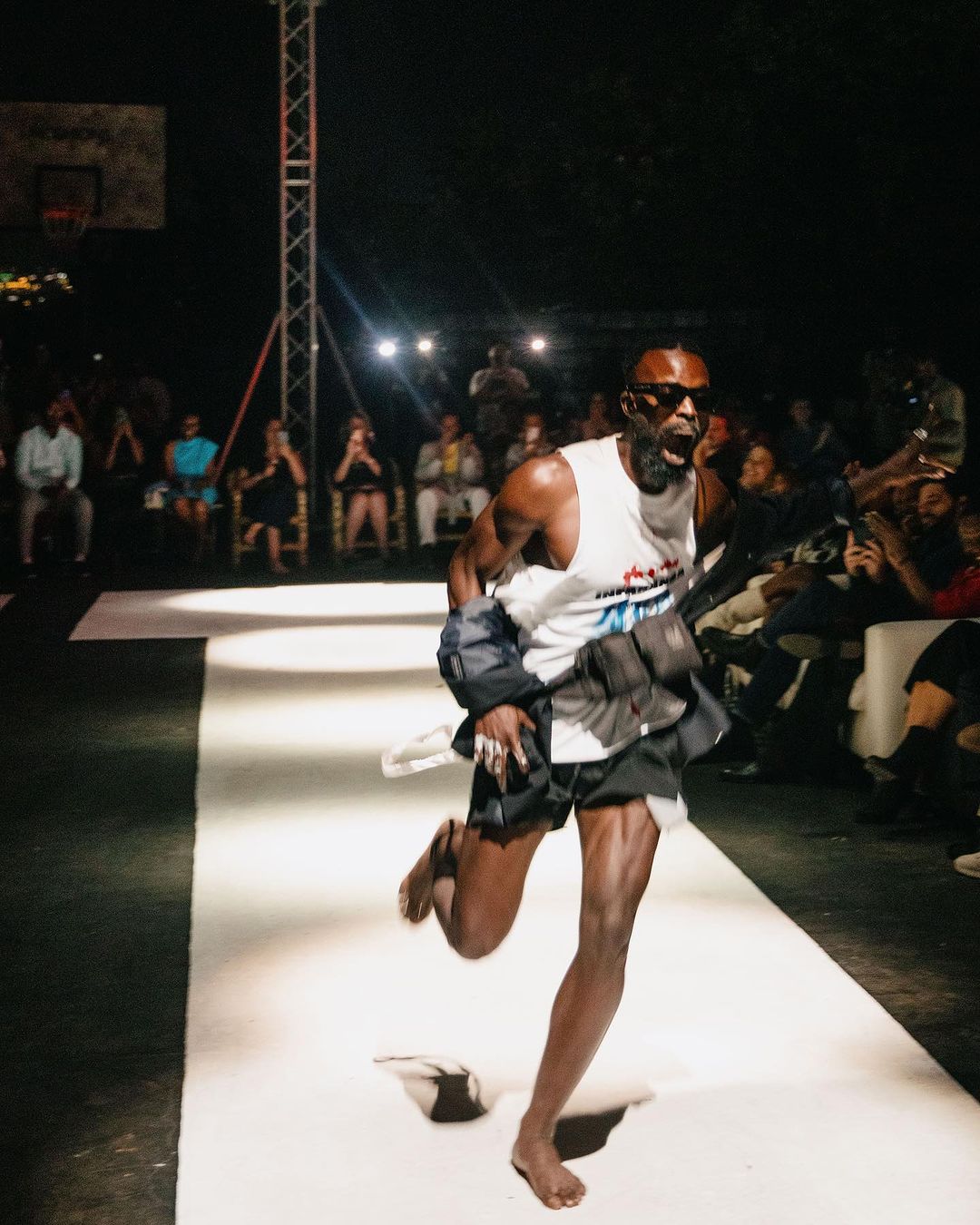
Moses Turahirwa Creative Designer and the founder of Moshions running on the runway to express the INFARANSA Collection concept [PHOTO KWANDAS1]
INFARANSA: " In this Queer couture state of mind, We are going to church running... [I am really running ...?, I'm afraid to be late, so I am running, I am running, I am carrying a lot but I am running, I Am changing money, buying things on the way, buying food & eating on the streets. while I'm running, but I am running, I meet my friends on the way, oh they are so also running, we are running. we are taking a little break as we breathe in and out....phewwww, but hey we are running ... we are so beautiful like angels but we are running... running to Heaven... We are arriving... INDEGE Y'INFARANSA" by Moses Turahirwa creative designer and founder of the Moshions
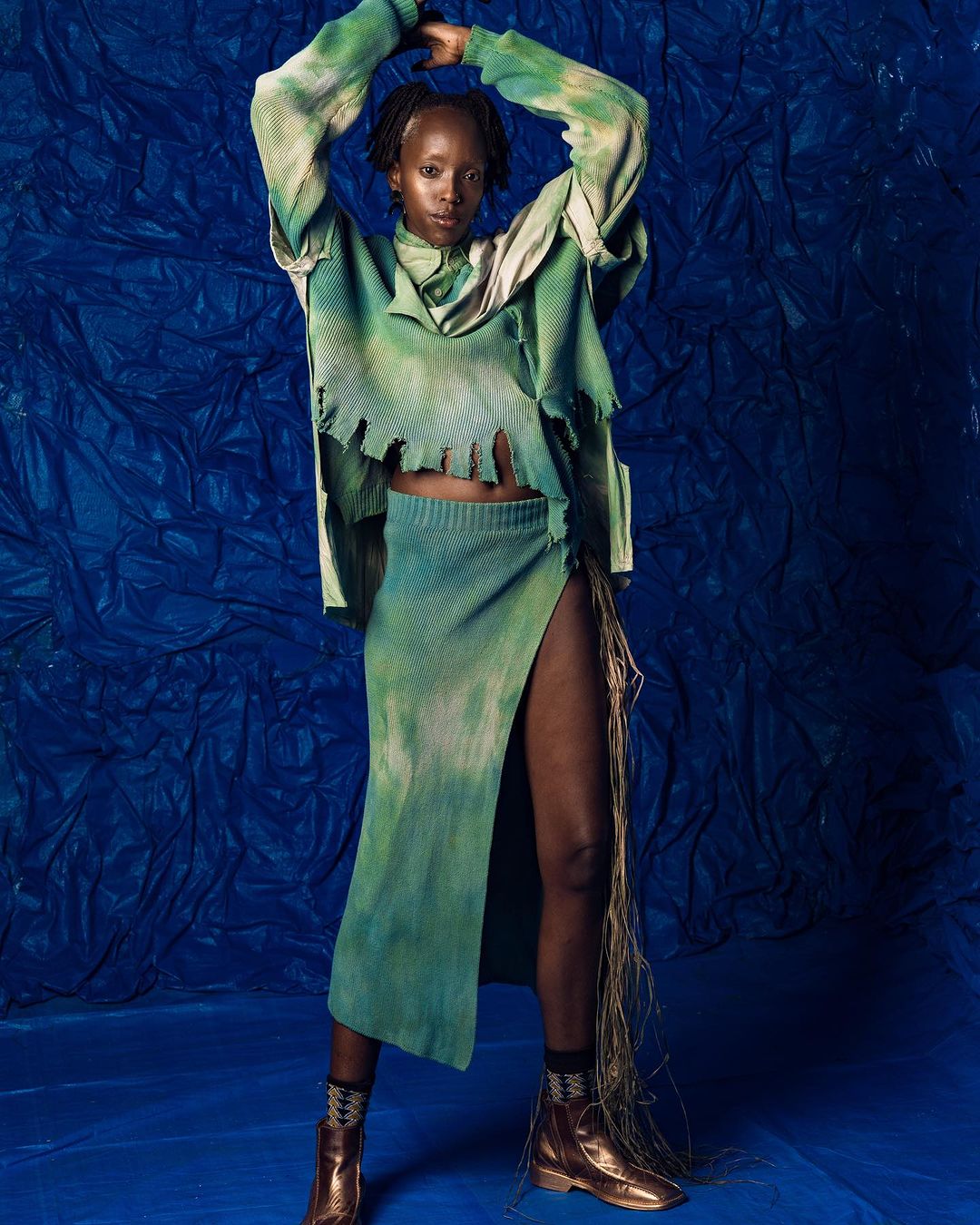 INFARANSA Collection made by MOSHIONS [PHOTO KWANDAS1]
INFARANSA Collection made by MOSHIONS [PHOTO KWANDAS1]
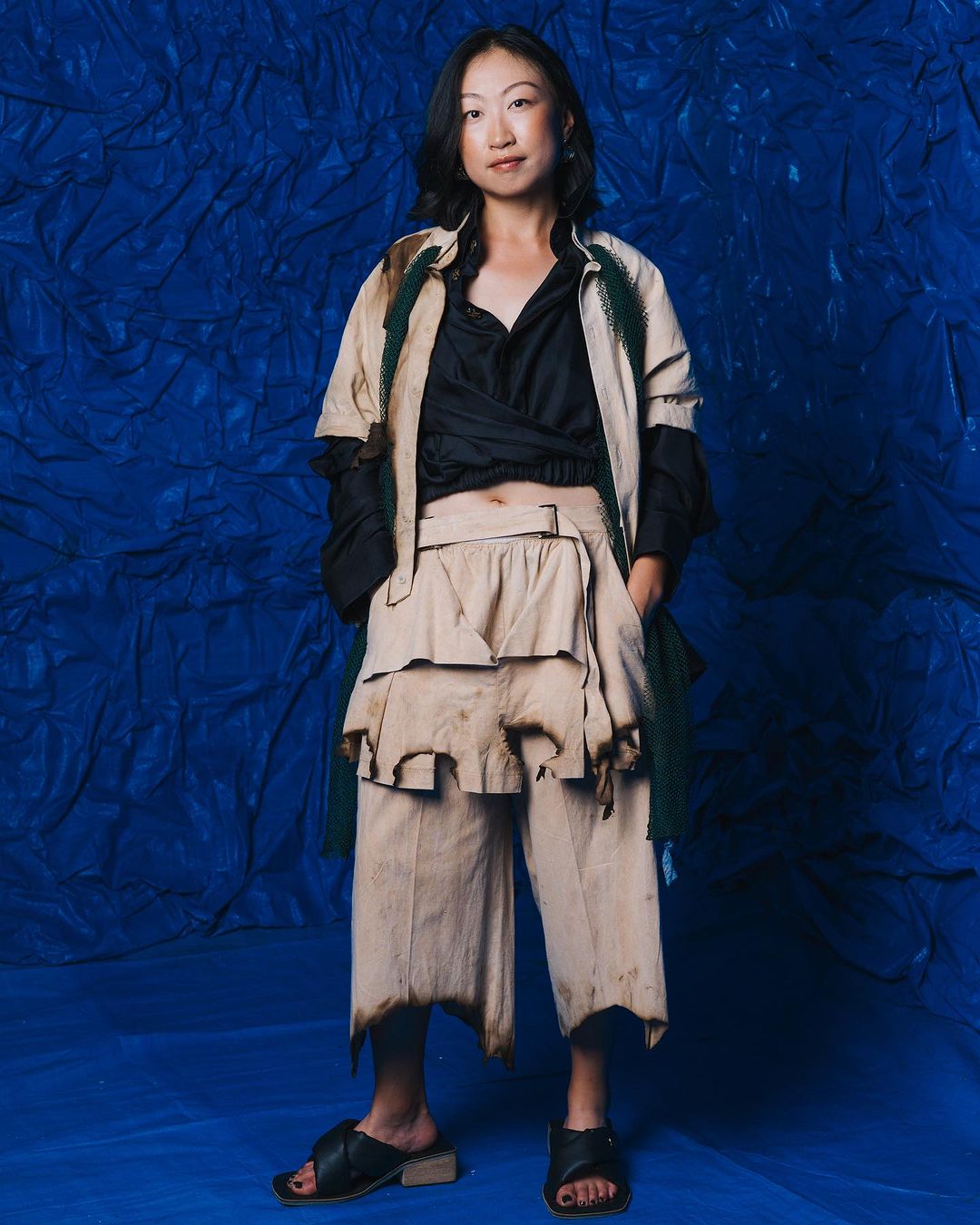 INFARANSA Collection made by MOSHIONS [PHOTO KWANDAS1]
INFARANSA Collection made by MOSHIONS [PHOTO KWANDAS1]
 INFARANSA Collection made by MOSHIONS [PHOTO KWANDAS1]
INFARANSA Collection made by MOSHIONS [PHOTO KWANDAS1]
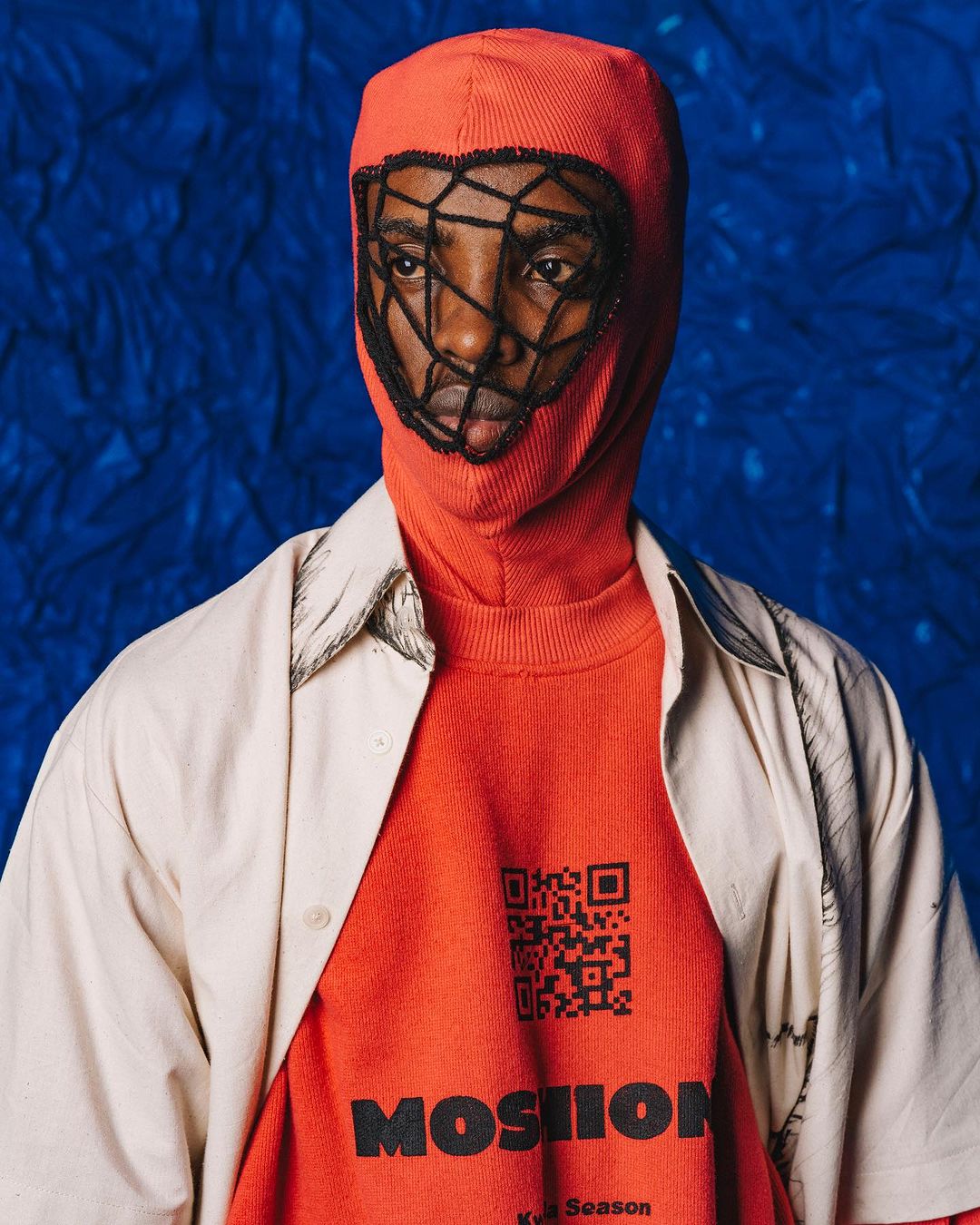 INFARANSA Collection made by MOSHIONS [PHOTO KWANDAS1]
INFARANSA Collection made by MOSHIONS [PHOTO KWANDAS1]
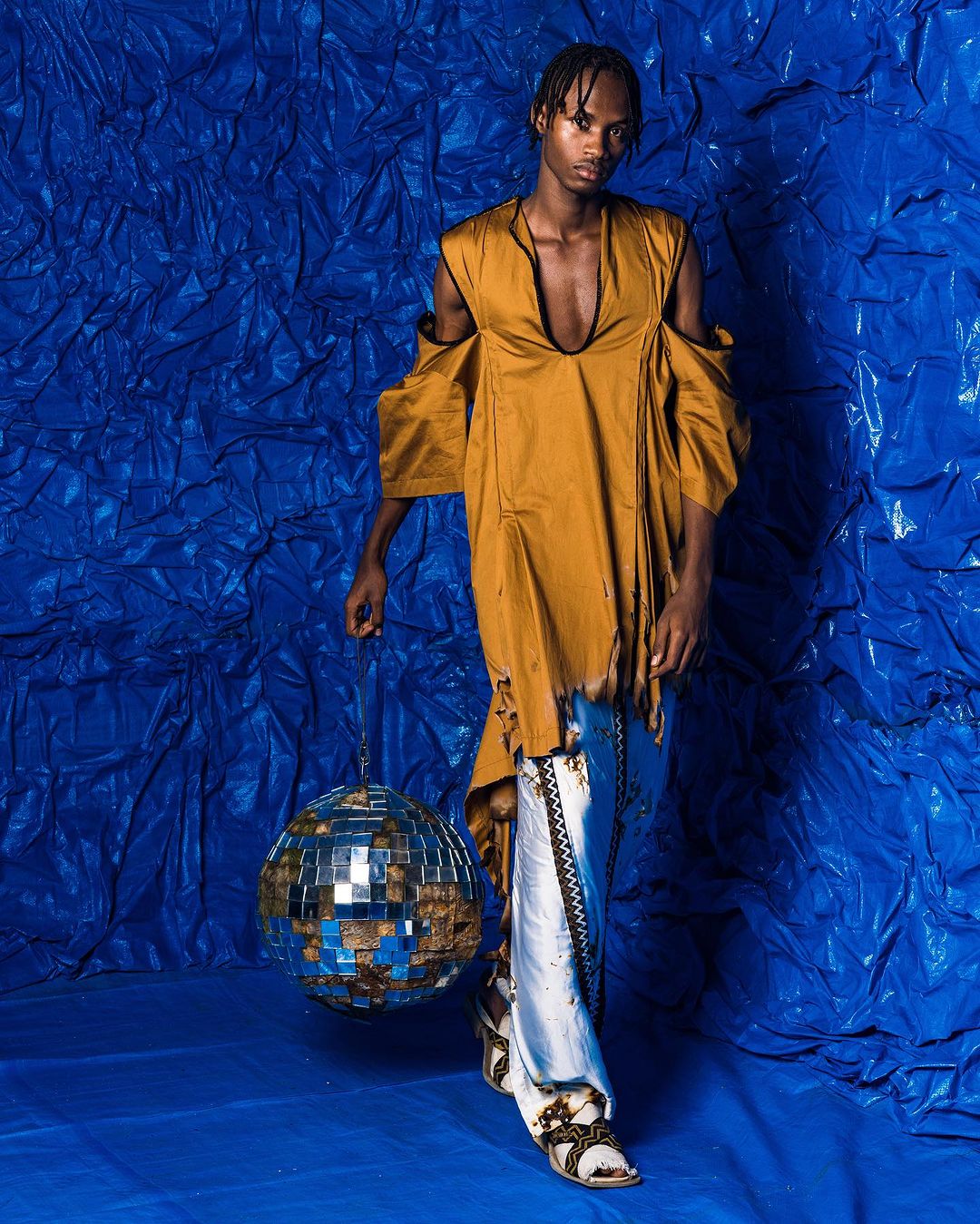 INFARANSA Collection made by MOSHIONS [PHOTO KWANDAS1]
INFARANSA Collection made by MOSHIONS [PHOTO KWANDAS1]
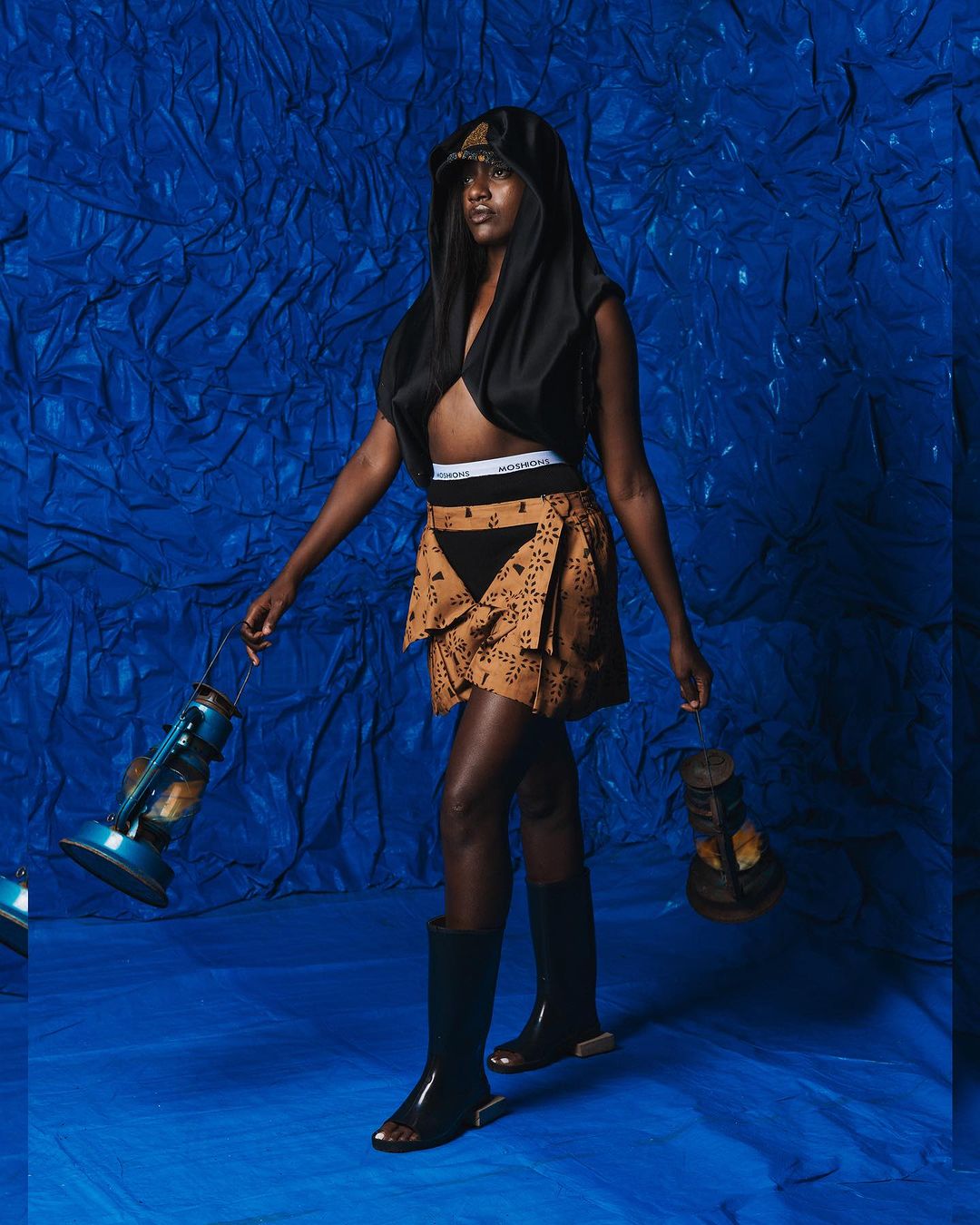 INFARANSA Collection made by MOSHIONS [PHOTO KWANDAS1]
INFARANSA Collection made by MOSHIONS [PHOTO KWANDAS1]
Moshions bridges the past with the future to unleash the creative potential of the present. Established in 2015 by Moses Turahirwa, Moshions reimagines the eclectic visual heritage of Africa. Through innovative and artful elevation, we design contemporary luxury apparel and accessories for a global audience. Inspired by and dedicated to local craftsmanship and artisanry, we collaborate with local and continental suppliers to empower a new generation of creatives. Moshions champions premium quality, 100% Made in Africa fashion.
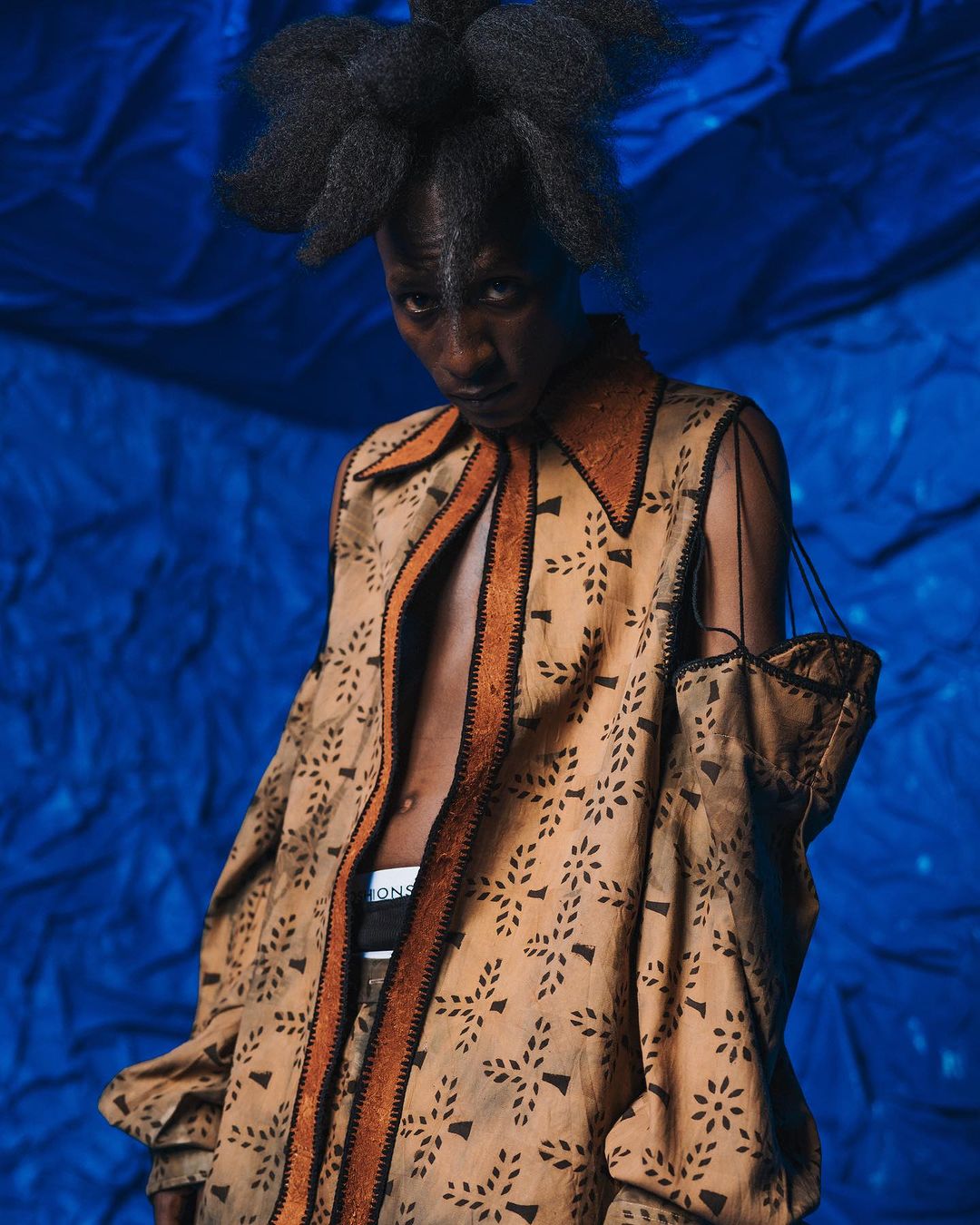 INFARANSA Collection made by MOSHIONS [PHOTO KWANDAS1]
INFARANSA Collection made by MOSHIONS [PHOTO KWANDAS1]
ALSO READ: WHERE IS THE BRAND MOSHIONS NOW? A NEW COLLECTION HAS BEEN RELEASED "ISHURI RIRAKOMEJE"
 INFARANSA Collection made by MOSHIONS [PHOTO KWANDAS1]
INFARANSA Collection made by MOSHIONS [PHOTO KWANDAS1]
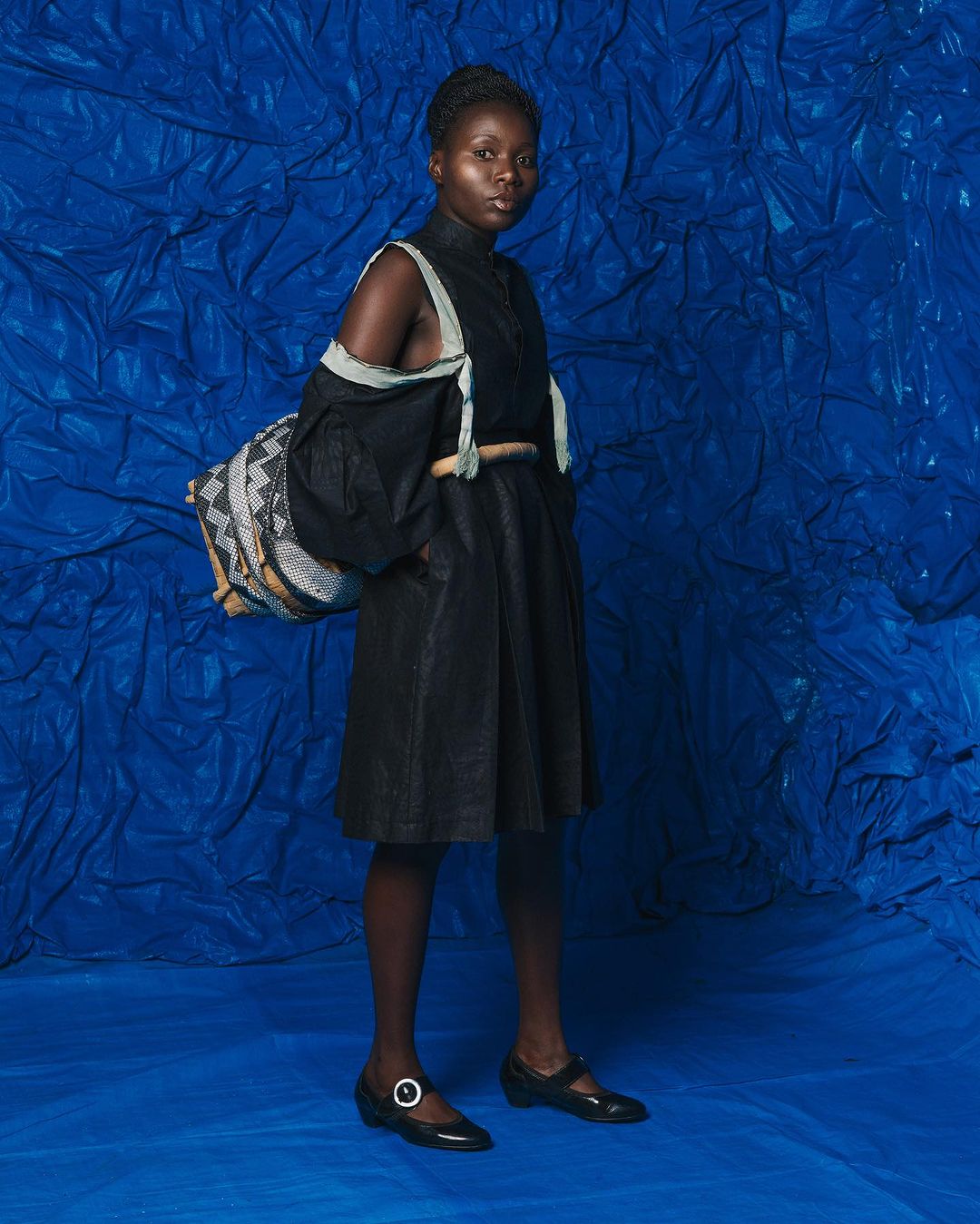 INFARANSA Collection made by MOSHIONS [PHOTO KWANDAS1]
INFARANSA Collection made by MOSHIONS [PHOTO KWANDAS1]
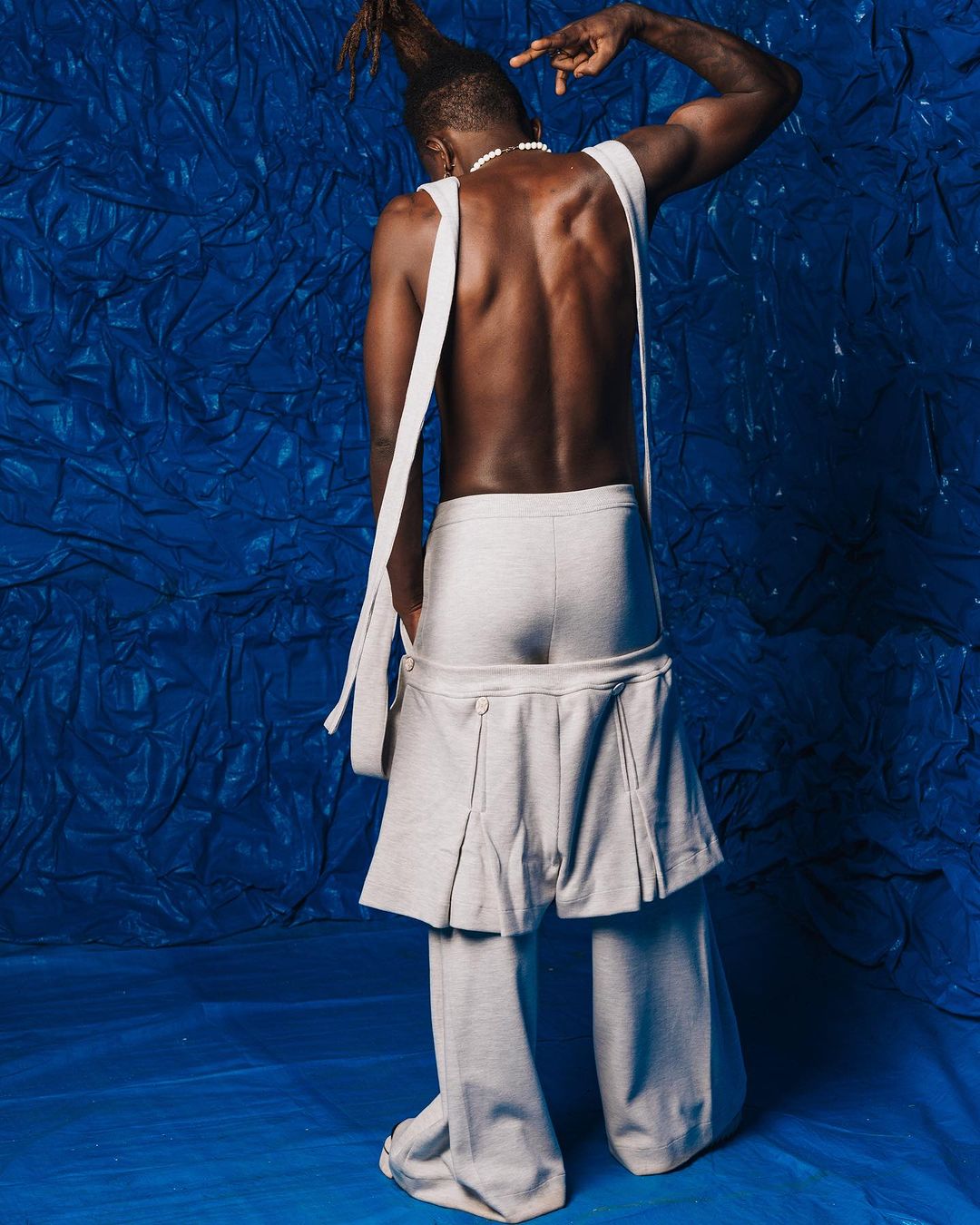 INFARANSA Collection made by MOSHIONS [PHOTO KWANDAS1]
INFARANSA Collection made by MOSHIONS [PHOTO KWANDAS1]
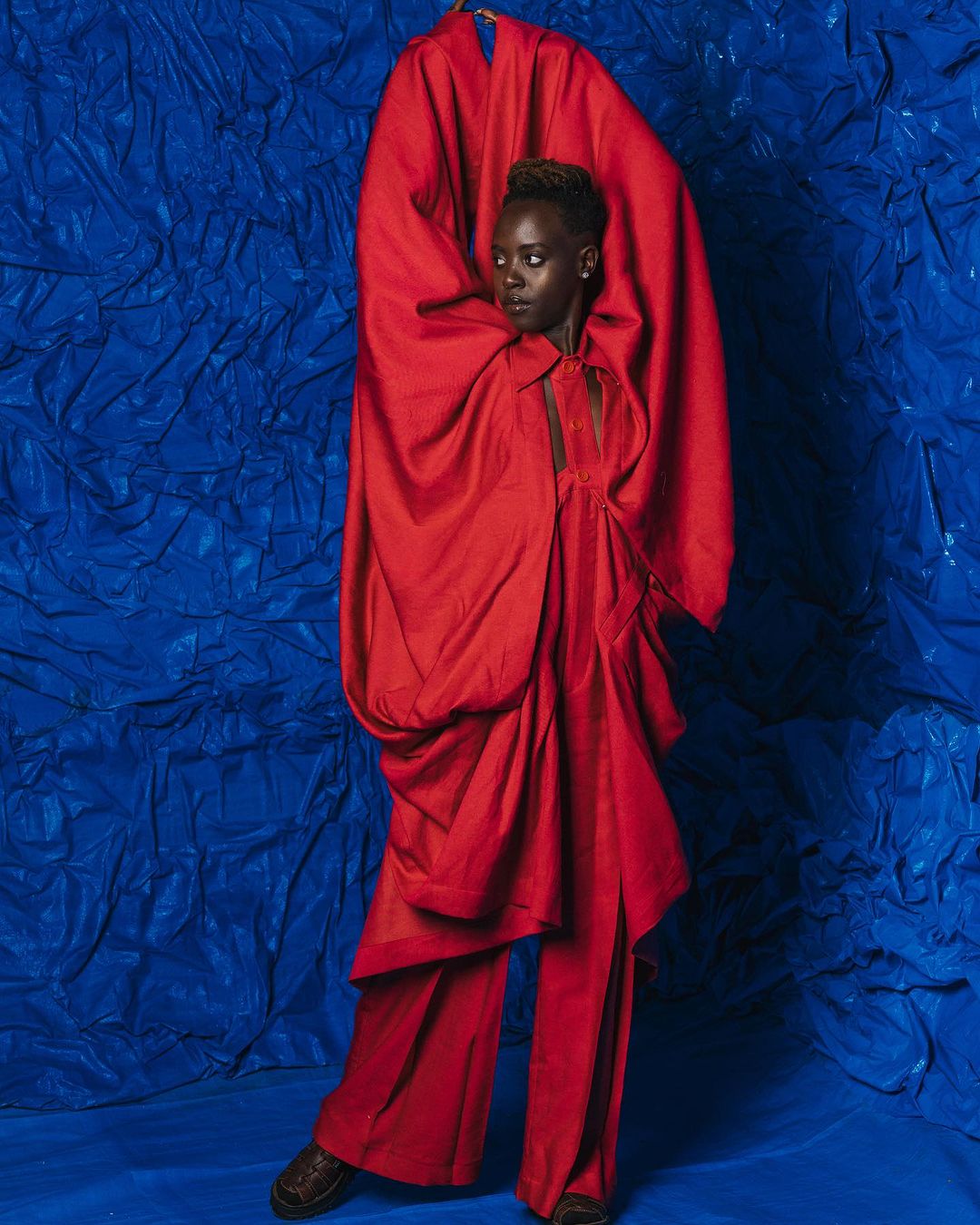 INFARANSA Collection made by MOSHIONS [PHOTO KWANDAS1]
INFARANSA Collection made by MOSHIONS [PHOTO KWANDAS1]
 INFARANSA Collection made by MOSHIONS [PHOTO KWANDAS1]
INFARANSA Collection made by MOSHIONS [PHOTO KWANDAS1]
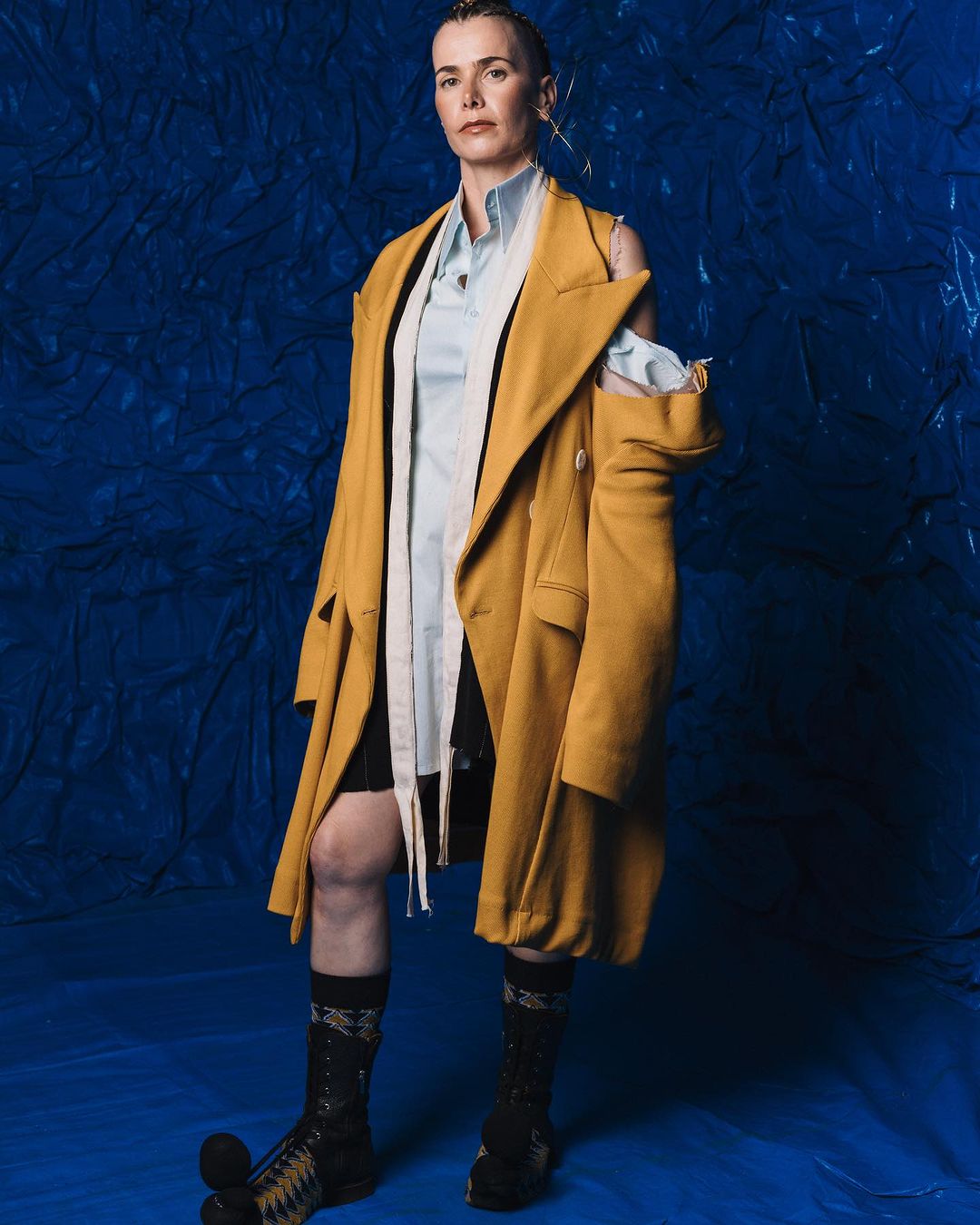 INFARANSA Collection made by MOSHIONS [PHOTO KWANDAS1]
INFARANSA Collection made by MOSHIONS [PHOTO KWANDAS1]
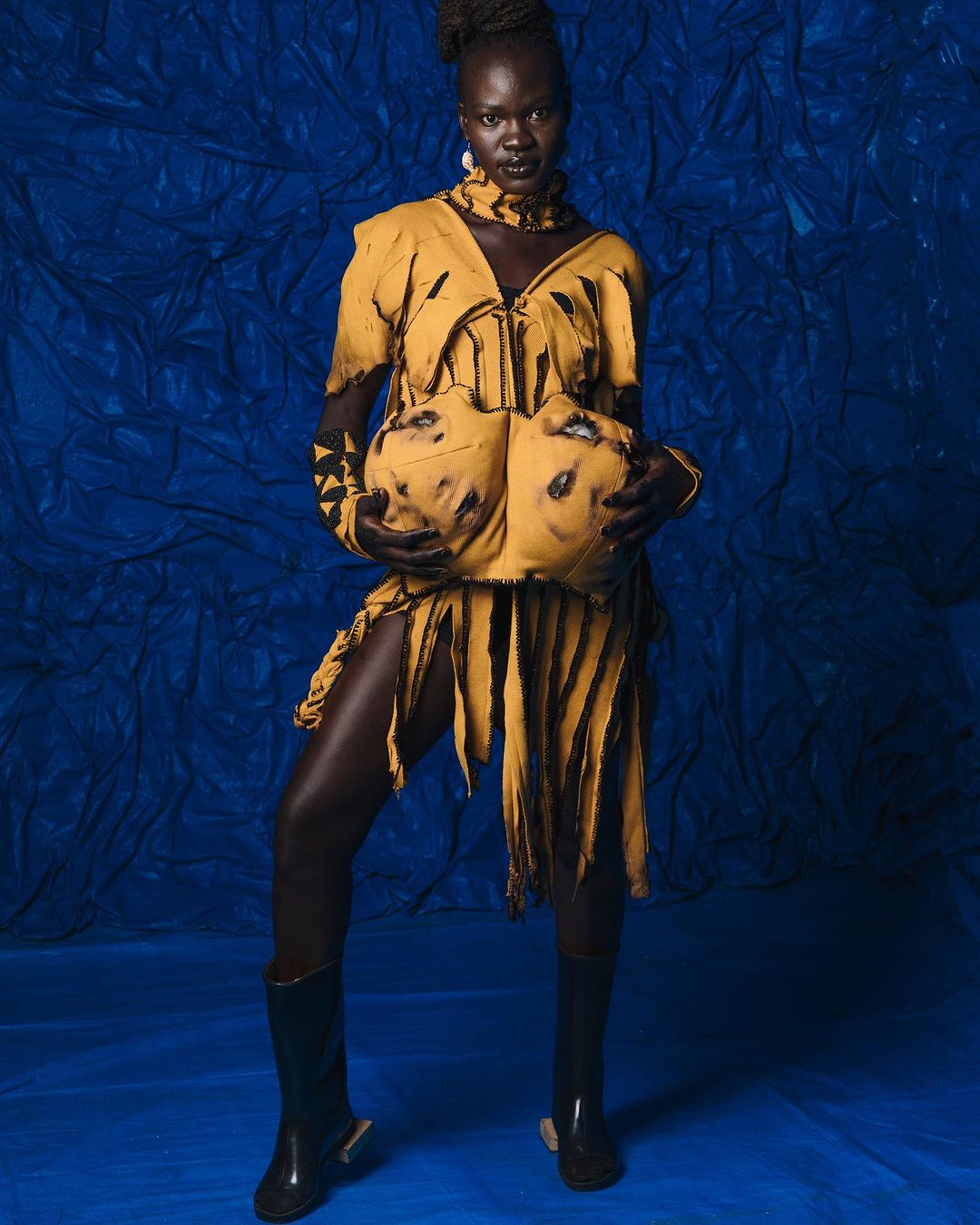 INFARANSA Collection made by MOSHIONS [PHOTO KWANDAS1]
INFARANSA Collection made by MOSHIONS [PHOTO KWANDAS1]
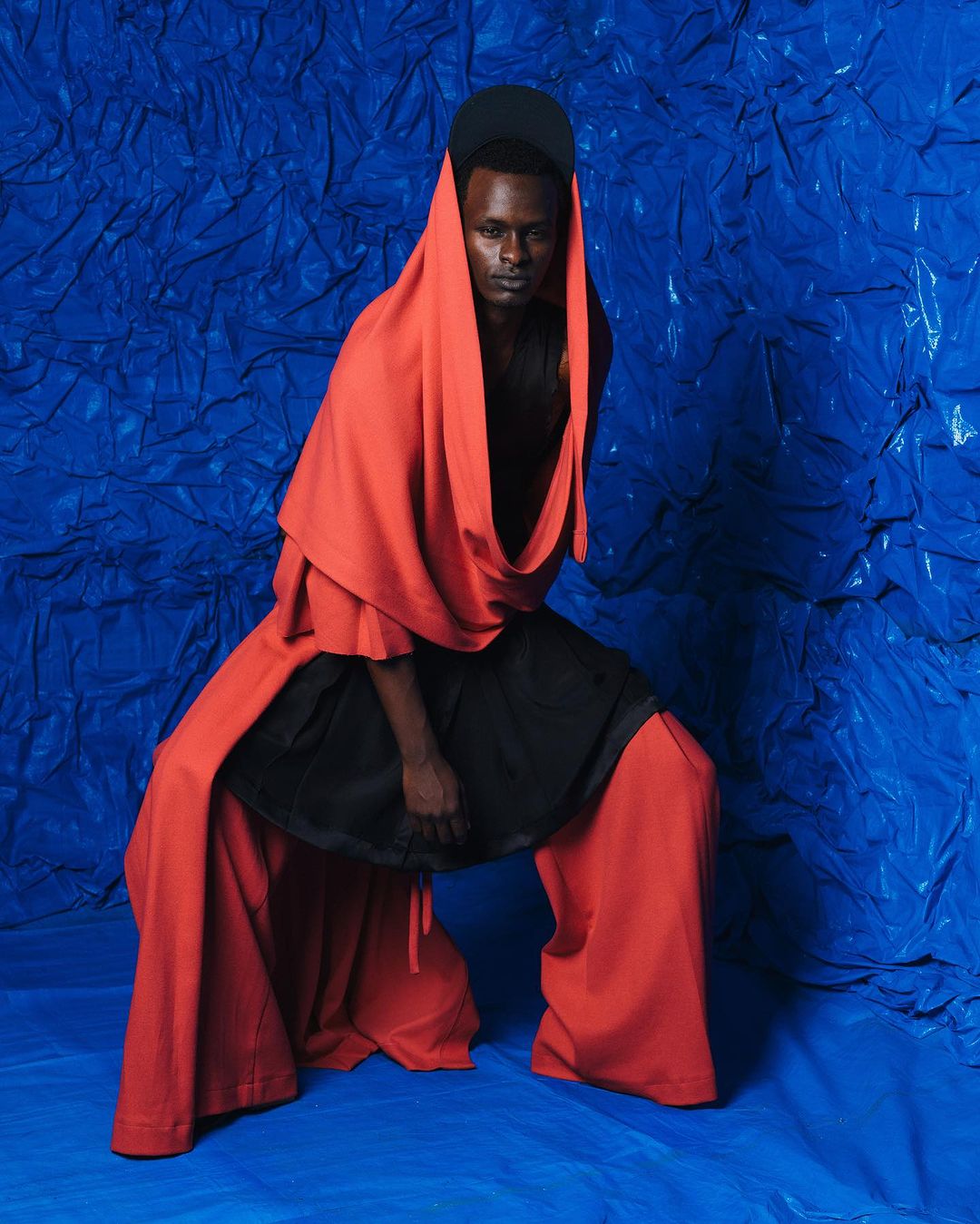 INFARANSA Collection made by MOSHIONS [PHOTO KWANDAS1]
INFARANSA Collection made by MOSHIONS [PHOTO KWANDAS1]
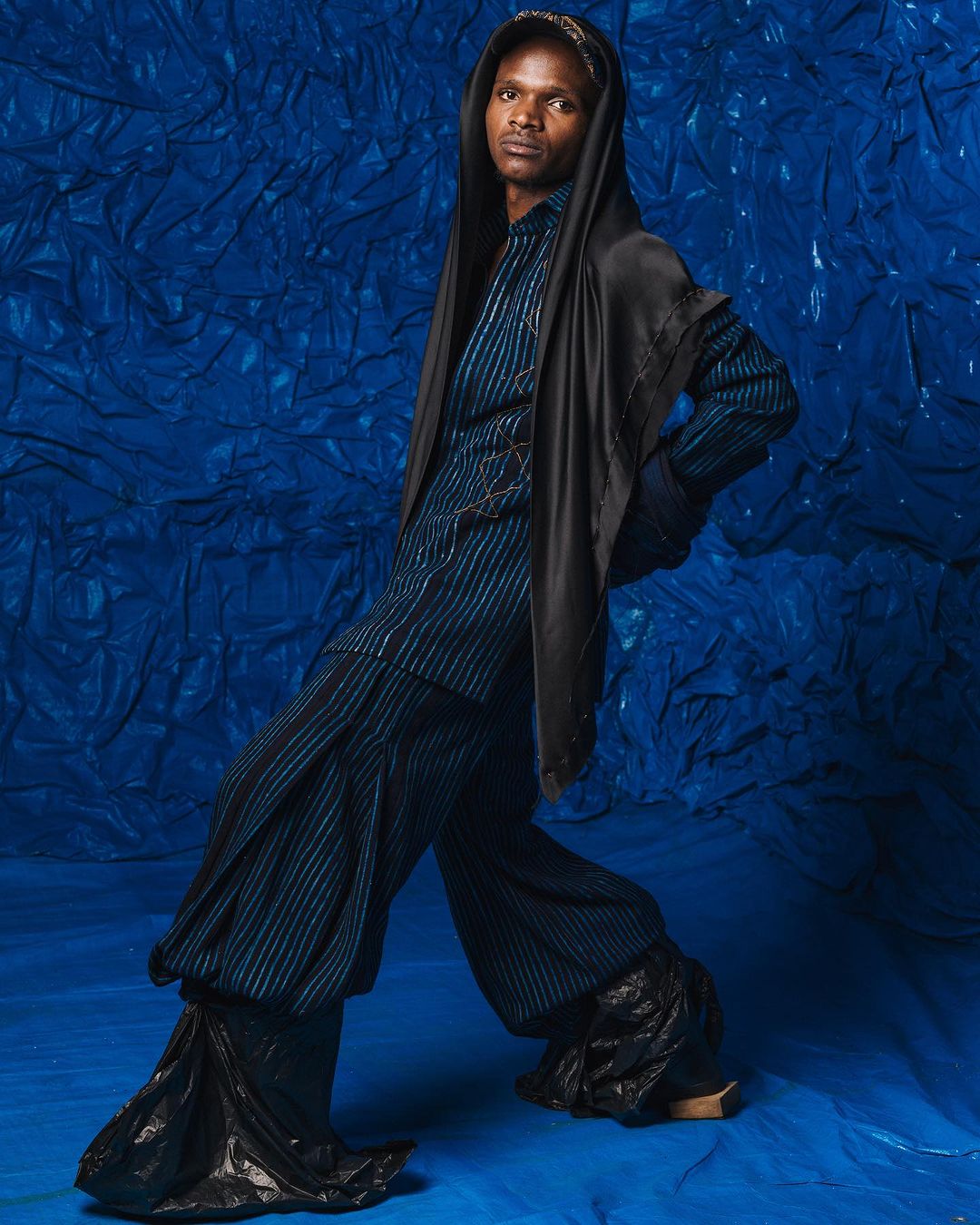 INFARANSA Collection made by MOSHIONS [PHOTO KWANDAS1]
INFARANSA Collection made by MOSHIONS [PHOTO KWANDAS1]
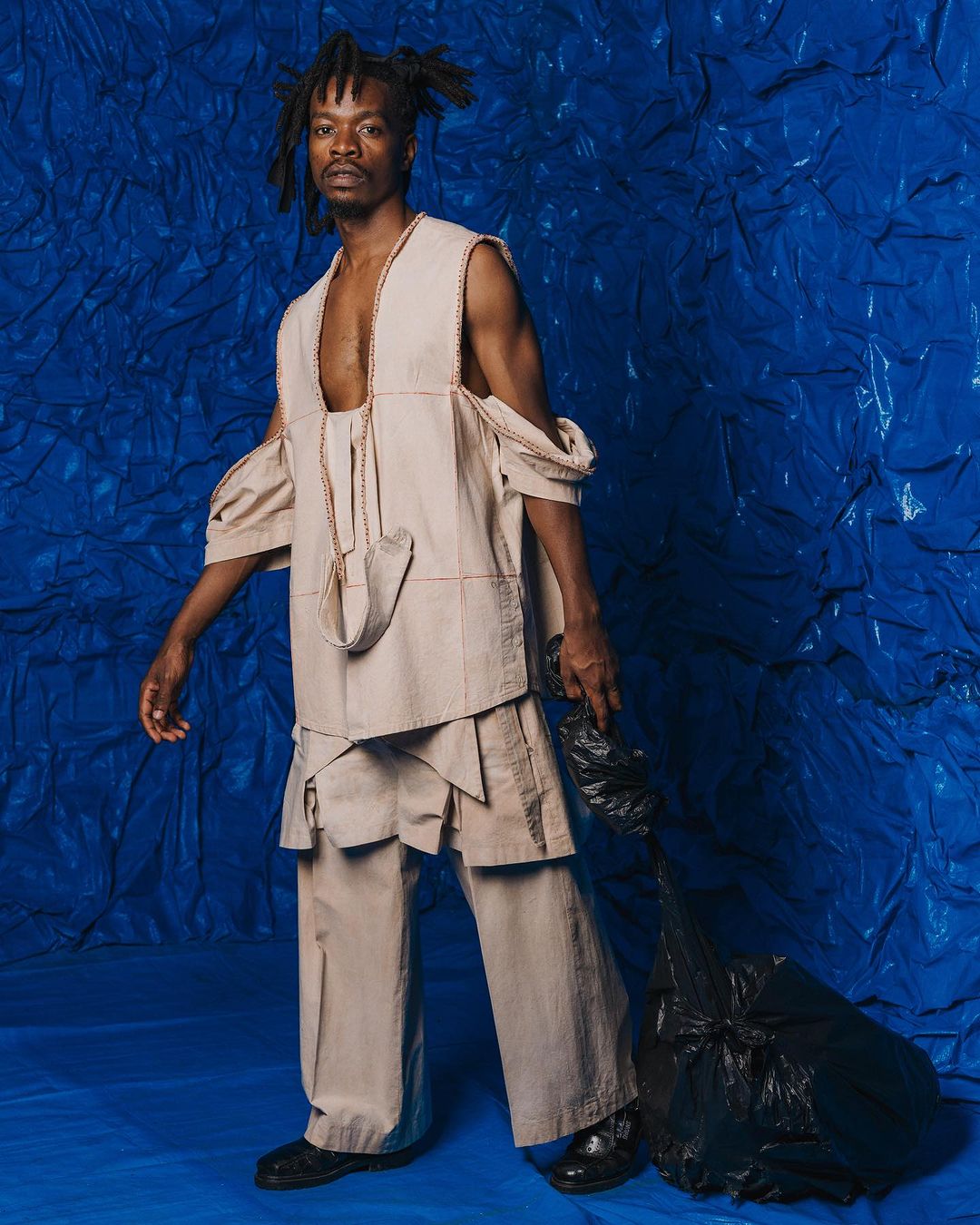 INFARANSA Collection made by MOSHIONS [PHOTO KWANDAS1]
INFARANSA Collection made by MOSHIONS [PHOTO KWANDAS1]
 Moses Turahirwa with models- INFARANSA Collection made by MOSHIONS [PHOTO KWANDAS1]
Moses Turahirwa with models- INFARANSA Collection made by MOSHIONS [PHOTO KWANDAS1]
LATEST NEWS
One week to go until Africa Sourcing and Fashion Week 2024: Designers, Exhibitors, and Speakers
01 November 2024 45 hitsOne week to go until Africa Sourcing and Fashion Week 2024: Designers, Exhibitors, and Speakers The countdown has begun for…
9 Years Milestone: Moses Turahirwa and His Moshions Brand Rwanda-Based
25 October 2024 329 hits9 Years Milestone: Moses Turahirwa and His Moshions Brand Rwanda-Based Over the past decade, Rwanda's fashion industry has emerged as…
What to Expect in Lagos Heineken Fashion Week 2024: Runways Kick off Today
23 October 2024 434 hitsWhat to Expect in Lagos Heineken Fashion Week 2024: Runways Kick Off Today The prestigious Heineken Lagos Fashion Week (LagosFW),…
Storytelling Meets High Fashion at The Kenya Fashion Story 2024
23 October 2024 487 hitsStorytelling Meets High Fashion at The Kenya Fashion Story 2024 The convergence of narrative and haute couture takes center stage…
Why Former Model Franco Kabano Is Backing the Stage Fashion Showcase's Founder
23 October 2024 444 hitsWhy Former Model Franco Kabano Is Backing the Stage Fashion Showcase's Founder In Rwanda's fashion industry, Franco Kabano and Sandrine…
The Stage Fashion Showcase 2024 Pre-Event Highlights Emerging and Established Talents: Main Event Set for November 1
20 October 2024 411 hitsThe Stage Fashion Showcase 2024 Pre-Event Highlights Emerging and Established Talents: Main Event Set for November 1 The fashion scene…
FASHION SHOPS
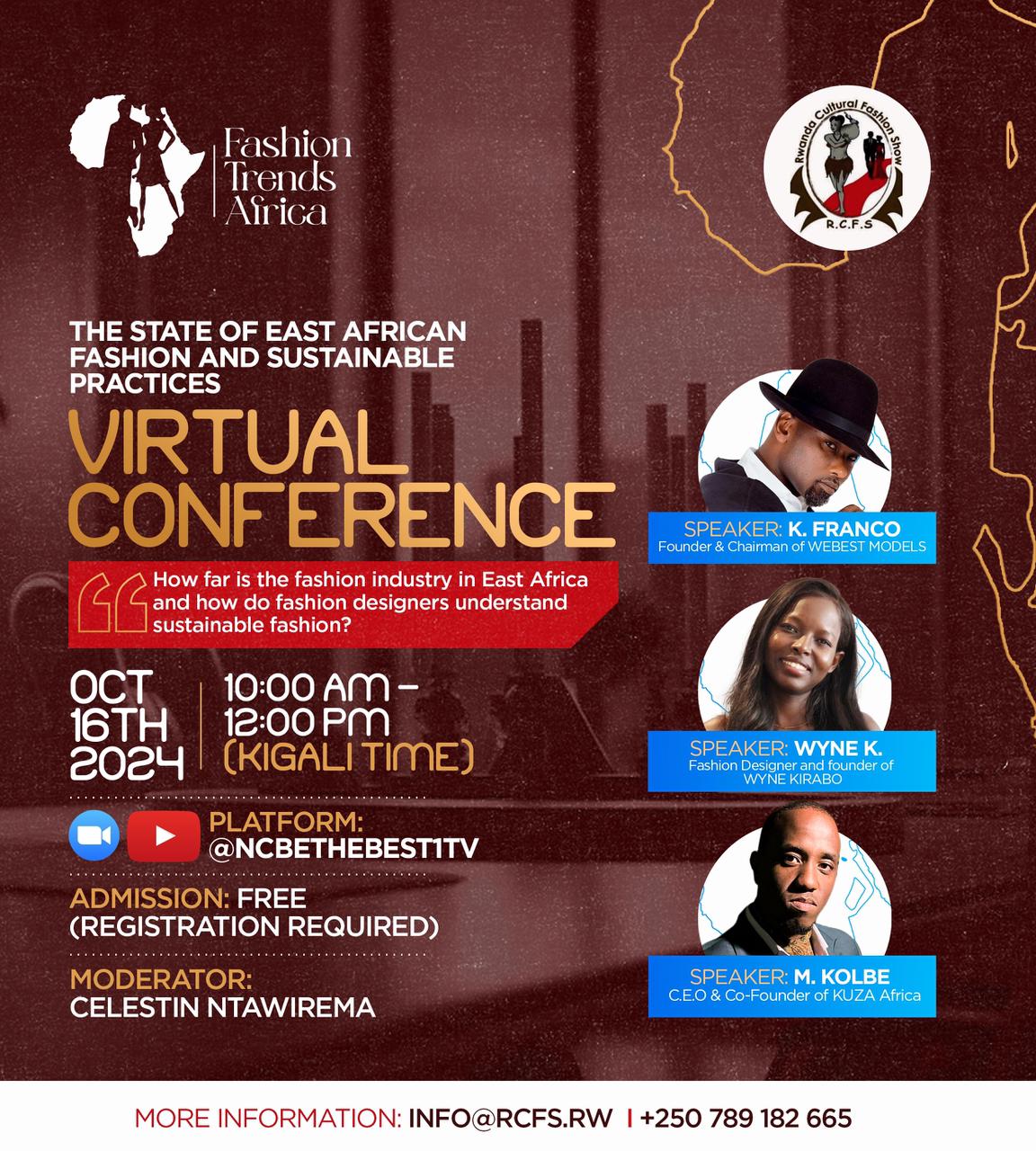



![Circular Economy and Sustainability in Africa: Fashion and Textiles [PHOTO NT]](/media/k2/items/cache/68497d6cb194485d2759fde9466457b7_Generic.jpg)
![Ethiopian Workers inside a Clothing Factory [PHOTO NT]](/media/k2/items/cache/f9a9b7c9f33a923e5475b478a62125ae_Generic.jpg)
![Ethiopian Workers inside a Clothing Factory [PHOTO NT]](/media/k2/items/cache/3bd6583af5a14653b7b54db2c9fe7f3e_Generic.jpg)
![Cotton Yarns [PHOTO ELISABETH]](/media/k2/items/cache/de2df791682f079f8397226a3ff38bc7_Generic.jpg)
![Modeling Agencies Leaders with Sandrine Mucyo in Kigali[PHOTO SS]](/media/k2/items/cache/f41bf091a4e18f2312495cc0e975d9f7_Generic.jpg)
![Modeling Agencies Leaders with Sandrine Mucyo in Kigali[PHOTO SS]](/media/k2/items/cache/5f9ec0b2e765a617089a13fe6f9b5c6d_Generic.jpg)
![Model on the runway-show in the Kigali Triennial 2024's Fashion [PHOTO MYA]](/media/k2/items/cache/fe4bbe81600a40063594e597e00eb05b_Generic.jpg)
![The Man Behind the Kigali Fashion Week: The Story of John Bunyenshuri [ PHOTO IN]](/media/k2/items/cache/f50c152c7848dac24210d3ad3ad22154_Generic.jpg)
![Made by ASANTII clothing brand based in Kigali- Rwanda[PHOTO ASANTII]](/media/k2/items/cache/49d07d2f2b048709fab28e0845347114_Generic.jpg)
![Infaransa Collection is Released: Inside Moshions 2024 [PHOTO KWANDAS1]](/media/k2/items/cache/23f6a067599ae98276b159b7685c0abf_Generic.jpg)
